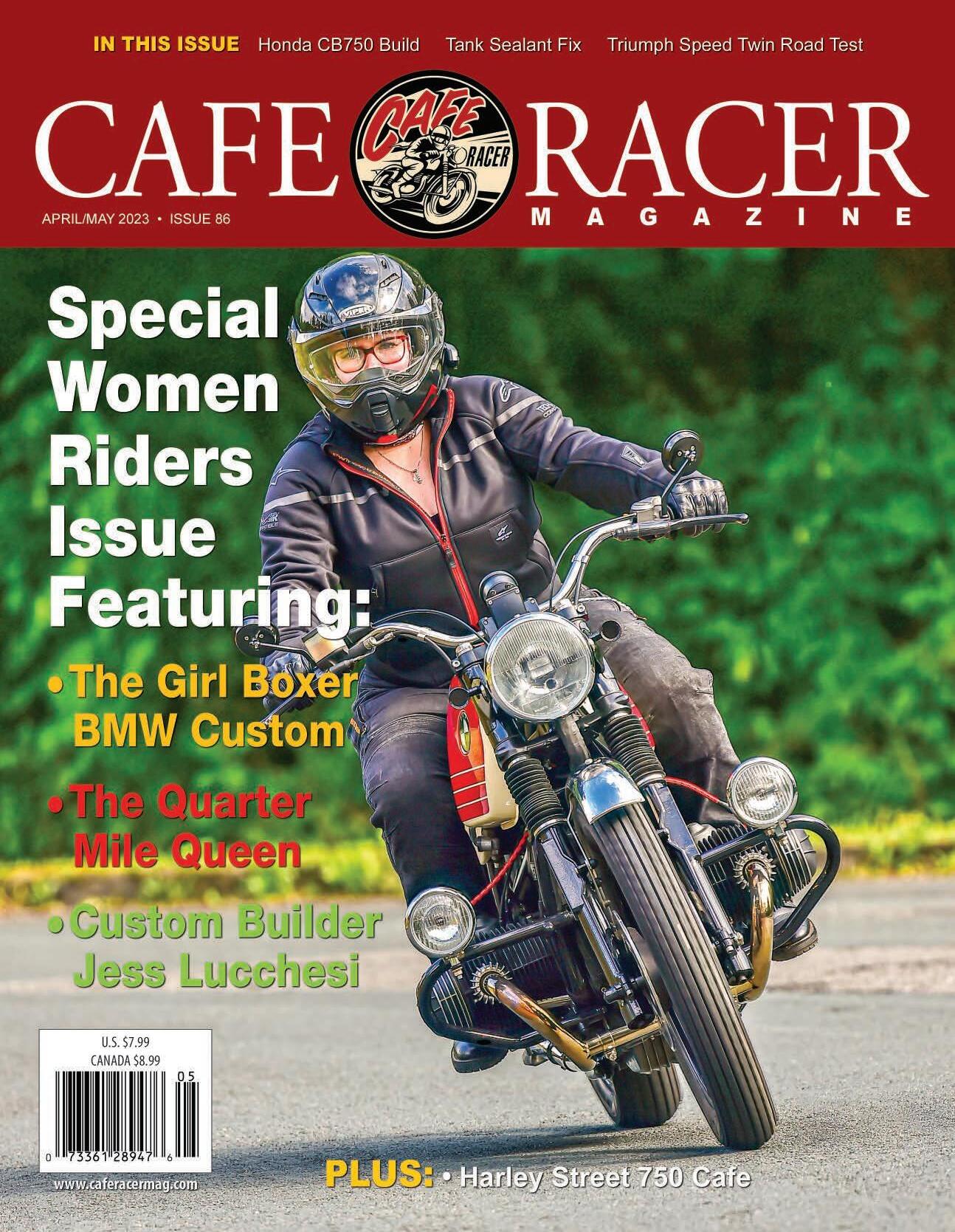

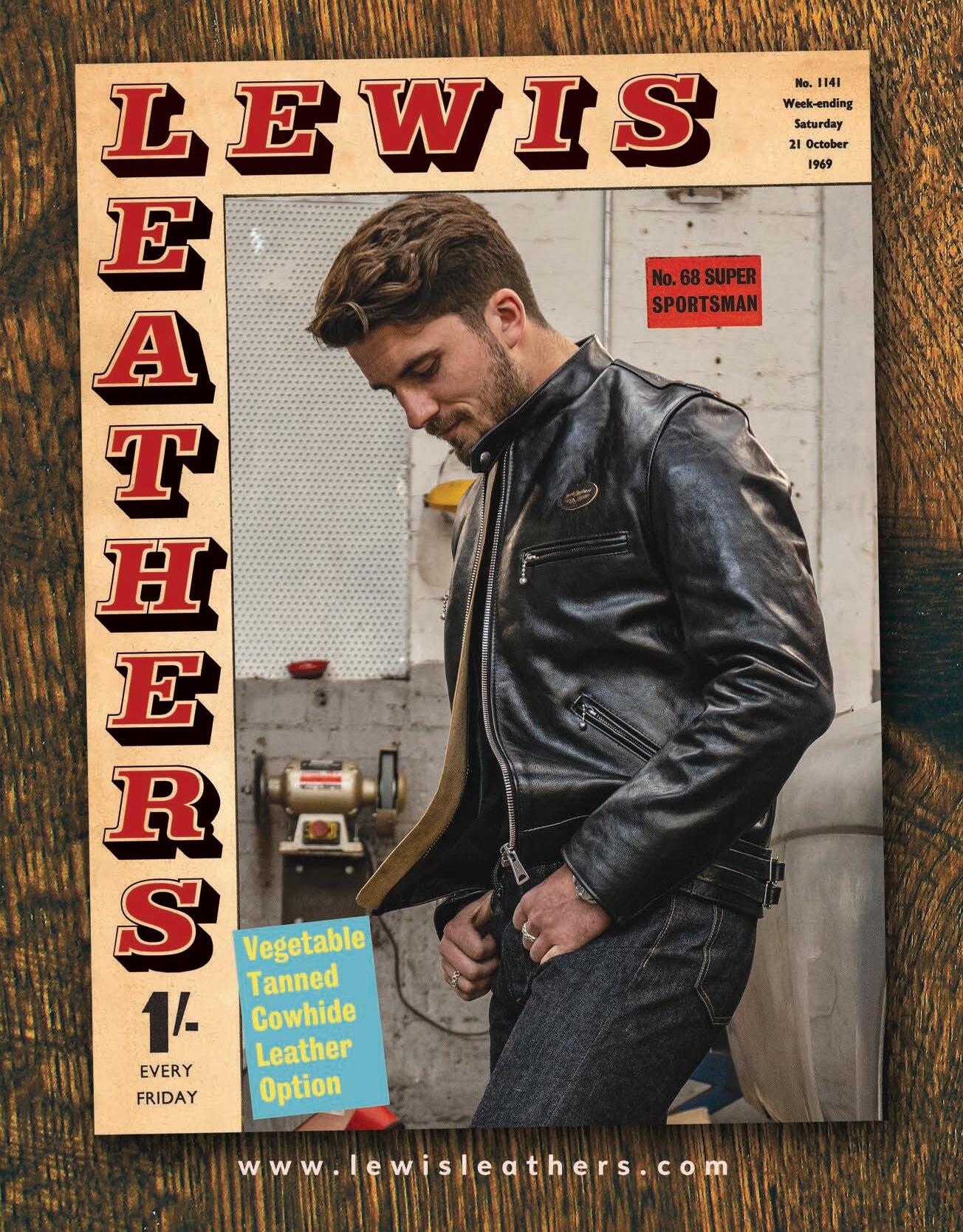


www.caferacermag.com
Brought to You by the Following Contributors Getting In Shape For Spring By…
Mike Seate, Editor/Publisher: Working on my six-pack...of Guinness
Kim Love, Managing Editor: Doing the heavy lifting, as always
Matt Wiley, Tech Editor: Curling...crankshafts and pistons

Simon Everett, Chief Photographer: Watching “Strictly Come Dancing.” Seriously.
Freelance Contributors doing one-armed push-ups…on the sofa:
Nick Coumos
Paul D. Stanstead
Gary Hallobeck
Adam Bowser
Manny Pandya
Advertising Sales
Steve Pospolita
Jose Gallina
Jeremy Haynes
Nick Altland
Bob Hesch
Ann Curtis @ (412) 463-5559 adsales@caferacermag.com
Customer Service: George Krisher is available for address changes, subscription renewals, back issue orders, T-shirts, hats and other cool swag (but no fitness training, please!) via support@caferacermag.com or a call to (412) 627-4104.
Layout and Design by Cindy Segrest, on the treadmill of life
Digital design by Christy Sparks, refereeing cat and dog fights
Send us your pictures! We dig seeing custommade cafe racers, streetfighters, bobbers, classics and bikes that don’t easily fit into categories. Make sure the photos are shot with a clear background (no cars, lawn furniture or grimy plastic kid’s toys) and are in a highresolution color format. Include some words –we’re not mind readers, ‘ya know!
Cafe Racer magazine is published six times yearly by our dedicated crew of writers, photographers, technicians and volunteers, and coming up this and every August, they transform themselves into a well-oiled team of carnies. That’s when we stage the annual Readers Ride-In Custom Show, now in its 15th year. We’re already getting glimpses of some incredible, trophy-winning customs being built for the Sunday, August 13th event, so get those wrenches humming and those paint guns spraying for the country’s biggest outdoor show dedicated to you, the speed-crazed cafe racing tribe. Vroom and all that!
APRIL/MAY 2023 • Issue #86
On The Cover: As part of our first-ever issue focusing on women riders, British custom builder Cheyenne Keogh roars ahead with her self-built BMW cafe custom. Find out how the youthful motorcycle designer learned her trade and dig on our coverage of female cafe racers the world over. Photo by Simon Everett.
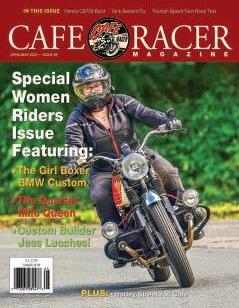
Follow along with our mechanical adventures inside the CRM garage, see where and what we’ve been riding and enjoy the general two-wheeled wackiness that is our staff on Instagram via @mikeseate and @love2ride650.
FEATURES
Never Ending Cycles 36 Jessica Lucchesi, Never Ending Cycles
Quarter Mile Queen 42 Megan Hill, Professional Drag Racer
Sportbike Chic 46 Riding Gear For Women By Women
COLUMNS
REGULAR SECTIONS
Fastlane News 10
The AIME Show/Dresda Tritons’
New Owners
The Paddock 16 Custom Bike News
First Ride 22
Triumph’s Speed Twin 1200
Long Term Bikes 26 MV Agusta Superveloce
Top Gear 30
Must-Have Parts and Accessories
Destinations 32 Events Guide
Curbside Customs 34 Home-brewed Specials
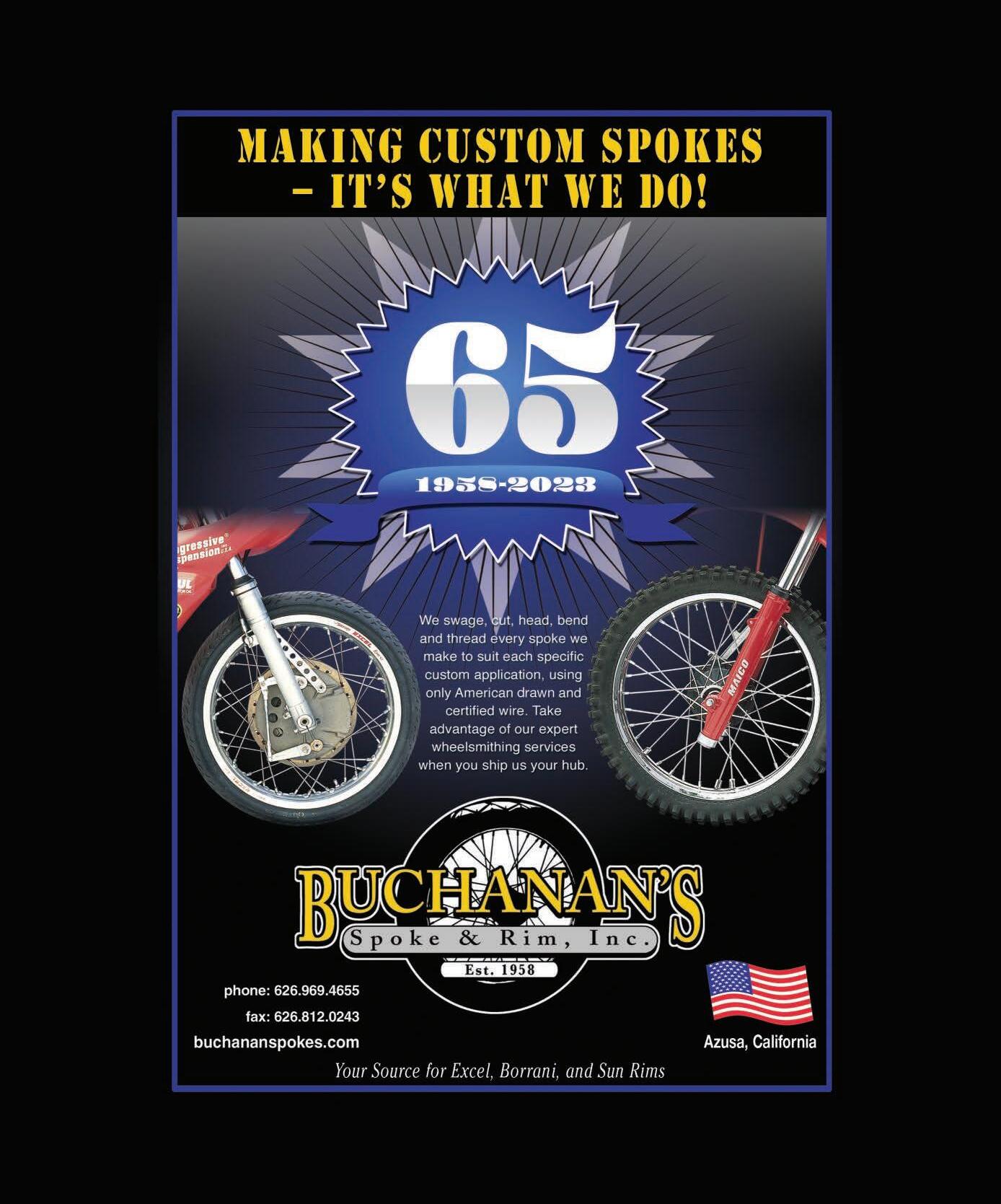
Girl Boxer 48
Cheyanne Keogh’s Beemer
Legacy 56
A History of Women in Motorcycling
Texas Beeza 60
Vintage BSA Special
Milwaukee’s Least Wanted 68
Harley Street 750 Cafe
Stylin’ 74 Letters, We Get Letters
The Market 76
J. Wood’s Online Auction
CR Tech 80
Honda CB750
CR Tech 81
Fat Featherbed Triton
Shopkeeping 82
Virginia’s Cognito Moto
CR Tech 84
V9 Bobber Road Test Time
CR Tech 87
Honda CB450
Workshop Files 88
Spring Tune-Up Guide
CONTENTS Café Racer Magazine
Open Mike 6 Check Up or Check Out Random Ramblings 8 R. E. S. P. E. C. T.

Open Mike
Check Up or Check Out
By Editor and Publisher Mike Seate

We were lucky enough to get out to our favorite new bike testing grounds in sunny So Cal recently, an area that’s always buzzing with two-wheeled activity. The fruits of the visit will appear in upcoming First Ride motorcycle evaluation features throughout the year, while some of the sights we took in were just too strange to categorize.
One of the main roads we use for testing is the twisty, undulating Mulholland Highway, a meandering slab of asphalt that winds its way through suburban Los Angeles for miles. On weekends, the road is a favorite for riders of all kinds of bikes, from stretched choppers to fullblown racebikes. There’s even a photographer who regularly sets up a mobile studio where he shoots every motorcycle that buzzes by in hopes of selling the action shots to riders as souvenirs.
Towards one fast section of Mulholland, there’s a hairpin turn where riders gear up for maximum lean angle, and it’s fun to dismount and watch the various lines and speeds taken through the apex. Most take the curve at around 40 to 60 MPH, but on a recent Sunday, someone had other ideas.
We heard the roar of a twin-cylinder engine well before the bike – a late-model air-cooled Triumph Bonneville – came into view and from the frantic revs, the rider was really going flat-out. The low black cafe racer whizzed through the turn so fast that most of the sportbike riders who had gathered to watch were vocally awed by the spectacle. It seemed a bit on the crazy side what with dozens of cars parked along the roadside and hikers and backpackers walking not far from the berm.
Leaned over far enough that his footpegs scraped the pavement in a shower of sparks, the rider, in a flash, was gone, leaving in his wake plenty of discussions about whether we’d just witnessed a professional racer strutting his stuff or one bad dude on a streetbike.

A few minutes later, our crew rolled up to the Rock Store, the fabled motorcycle meeting place in Cornell, near Malibu, where the Triumph sat parked, smoke slowly curling from one of its straight-open exhaust pipes. “It’s him,” observed CRM test rider, Jay LaRossa, who eagerly pointed out unexpected details on the bike. While we expected to find a motorcycle festooned with high-performance accessories, instead the Bonneville was rolling on nearly bald and poorly-inflated tires, its engine leaking oil from several points.
The rear chain drew plenty of shocked and horrified onlookers as it was bright red with rust, and so worn that there were kinks in the links where it was threatening to break. Dents in the gas tank evidenced this bike was not unfamiliar with horizontal travel.
“What kind of nutball would ride a bike in that bad of shape that fast
in the bends?” Jay wondered aloud, saying what dozens of other riders were thinking. I’d met my share of irresponsible riders, from guys who imbibed a six pack and several shots of high-octane whiskey before a ride to folks rolling on tires with less air than you’d find in a child’s Happy Birthday balloon. But this guy was the all-time caketaker.
I wondered if other riders thought it was cool or brave for the flat-out flyer to unnecessarily risk his life – and those of his fellow road users –each time he twisted the throttle. Was he simply negligent and/or lazy?

No matter the reasons, I wondered if the bike might be pulled from road use and used as an example by the local police or riding groups as an illustration of how not to treat a motorcycle.
It only takes a few minutes to perform a quick walk-around safety check of your ride to ensure that it’s in safe operating condition, which is something that can save on costly repairs not to mention expensive, painful hospital stays.
Before I could locate the rider and interview him, I heard the Triumph roar back to life and the rider wheelied out of the Rock Store parking lot like he was qualifying at Laguna Seca. Who knows if he’s still tempting fate and risking it all at every turn. Or maybe, just maybe, he’ll read this and clean up his act. CR
6 www.caferacermag.com

R.E.S.P.E.C.T.
By Managing Editor Kim Love
In honor of this month’s issue, dedicated to women, can we talk about women in motorcycling? I mean, really talk? For more years than I can count I’ve been involved in the industry, first as a passenger, then a rider, for 25+ years in dealerships and with this magazine for the last 15 years. And for all those years I’ve heard women riders referred almost as oddities, like they’re rare birds, bright and pretty and, oh look, there’s one over there. Quick, get a photo!
Oh for heaven’s sake people, one in five motorcyclists on the road is a woman. We’re legitimately 20% of the market. We’re not going anywhere, and whether you know it or not, we’ve been around for a long time. Seeing a woman on a bike isn’t a rare sighting anymore, and it hasn’t been for many years. So let’s stop being stunned when we see a woman on two wheels, and start giving women riders the respect they deserve for being a bona fide part of, not an rarity in, the industry.
For a great, albeit small, sampling of women’s contributions to the sport, take a look at our Legacy feature on page 56. If those women don’t command as much respect as the more well-known male motorcycling pioneers, well never mind, they just do. And while none of the women who’ve personally inspired me made the feature, they’re just as deserving of our respect.
My grandfather, Harry Probst, had a Harley-Davidson dealership for about 25 year, from the early 30s to 1956 when he passed away. My mother, Leona, spent her early years in the store. While other girls were playing hopscotch she was stocking shelves and manning the parts washer, elbow deep in gasoline.

Speaking of adventurous, in the late 90s I dared to hire a female motorcycle technician at my first dealership, and she was brave enough to accept the position. Marianne Taylor was an ace mechanic, but I can’t imagine what it felt like as a woman, walking into the boys club that was our service department. I know the men didn’t make it easy for her, and after a short time she was hired away by Harley-Davidson to work on their riders education program. I rode with Marianne once, her on her Buell, me on a demo bike that was probably too tall for me. I dropped the bike after stopping at a stop sign on a weird downhill curve, and was mortified. She quietly helped me right the bike and said nothing. I will be forever grateful for her silence on the matter. Last I heard she was working in the service department in a large Harley deal-
ership in Florida. If you see her, say hi from me. I miss her.
At that same dealership, recognizing that women were becoming a larger part of the riding scene, I organized an annual event called For Women Only. (I remember the local newspaper refused to run an ad for the event because it discriminated against men. I still laugh at the idea that anything within motorcycling discriminates against men.) The event included demo rides, a fashion show of women’s riding gear, seminars about bike maintenance and motorcycle safety and lots of camaraderie. Two of the women I met through those events, more than 25 years ago, are still friends today.
Nancy Stark attended the first For Women Only seminar. She had recently bought a Honda Shadow 750 (gorgeous in cream/red paint) and was eager to meet other riders. She kept that stunning Shadow even after she graduated to a big ass 1999 Harley-Davidson Road King, in stunning dark green with matching (big ass) saddlebags. She rode with pure joy and enthusiasm, and mentored younger riders.
Celine Nista, at the time a RiderCoach trainer with the PA Motorcycle Safety Program, led a seminar on, well, rider safety. She’s still a trainer with the Motorcycle Safety Foundation, and she still rides. She has a 1992 Ducati 750 Supersport that’s a work of art, but she mostly rides a Suzuki DRZ400 SuperMotard now. Oh, and if that’s not cool enough –and it is – she also rode her friend Neil’s 192 BSA 500 single…on ice. Yes, she ice races. Yes, she’s a badass.
So yes, women have been riding and working in motorcycling for a long time, and we’re not going anywhere. I’m excited to see we’re featuring women this issue. But I’ll be more excited when every issue includes women, when a female bike builder is just a builder, and a female rider is just a rider. We’ll get there. Keep riding. CR
Random Ramblings
8 www.caferacermag.com
L - R, Uncle Gene, my grandmother Betty, my uncle Mickey and my mother, Leona, in front of my grandfather's Harley-Davidson dealership circa early 1940s.
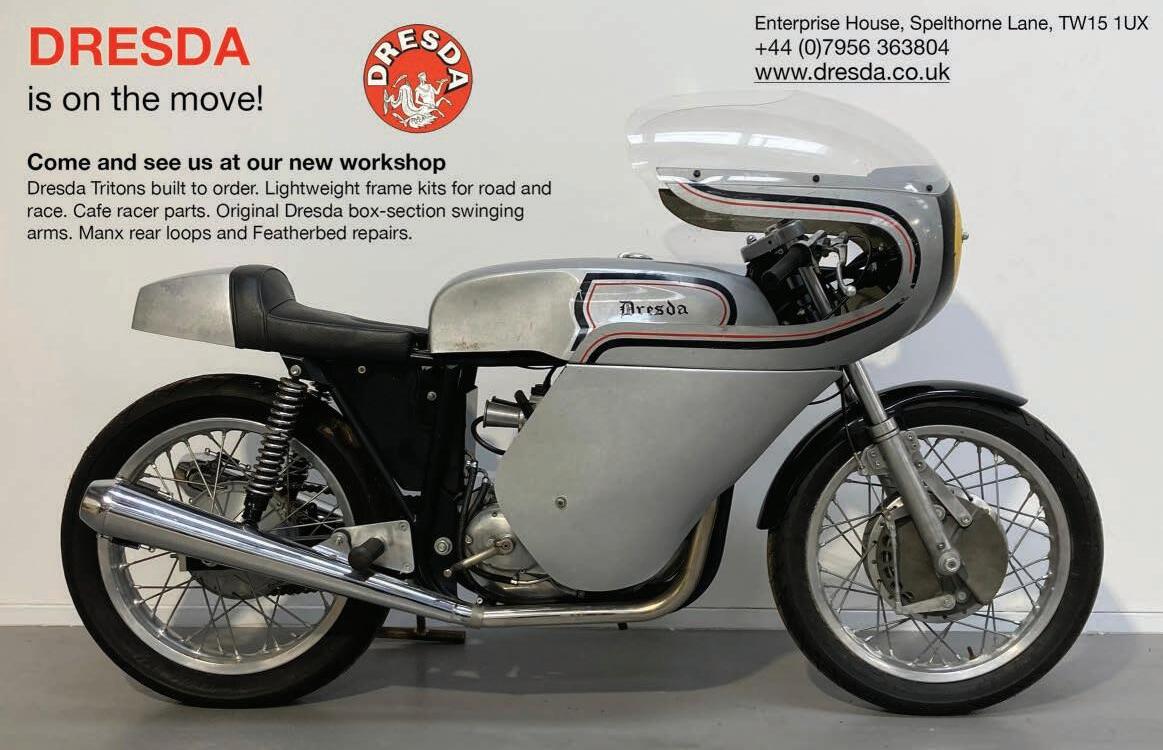

AIME Las Vegas –

The Motorcycle’s Industry’s Showcase
contracting domestic motorcycle market, grand displays of the industry’s latest wares have all but disappeared – until now, that is. The American International Motorcycle Expo (or AIME) moved to the spacious Las Vegas Convention Center where some 875 retailers displayed the latest two-wheeled rides and accessories to dealers and the media. From
Benelli, whose 500cc Leoncino scrambler we tested last issue. For 2023, the Italian/ Chinese conglomerate is serving up the tasty Imperiale, a 400cc, air-cooled single aimed directly at the growing middleweight retro market. The styling is based on Benelli’s singles of the 1950s, right down to the spoked wheels, solo seat with separate
well. Likewise, China’s QJ Motor are heading down the cafe road with a new 550cc parallel twin retro ride known as the SRV550. Powered by a fuel-injected parallel twin very similar in design to the Benelli Leoncino’s mill, the 550 offers radial front brakes, inverted forks and a six-speed gearbox, but will retail for a very reasonable $6,100.
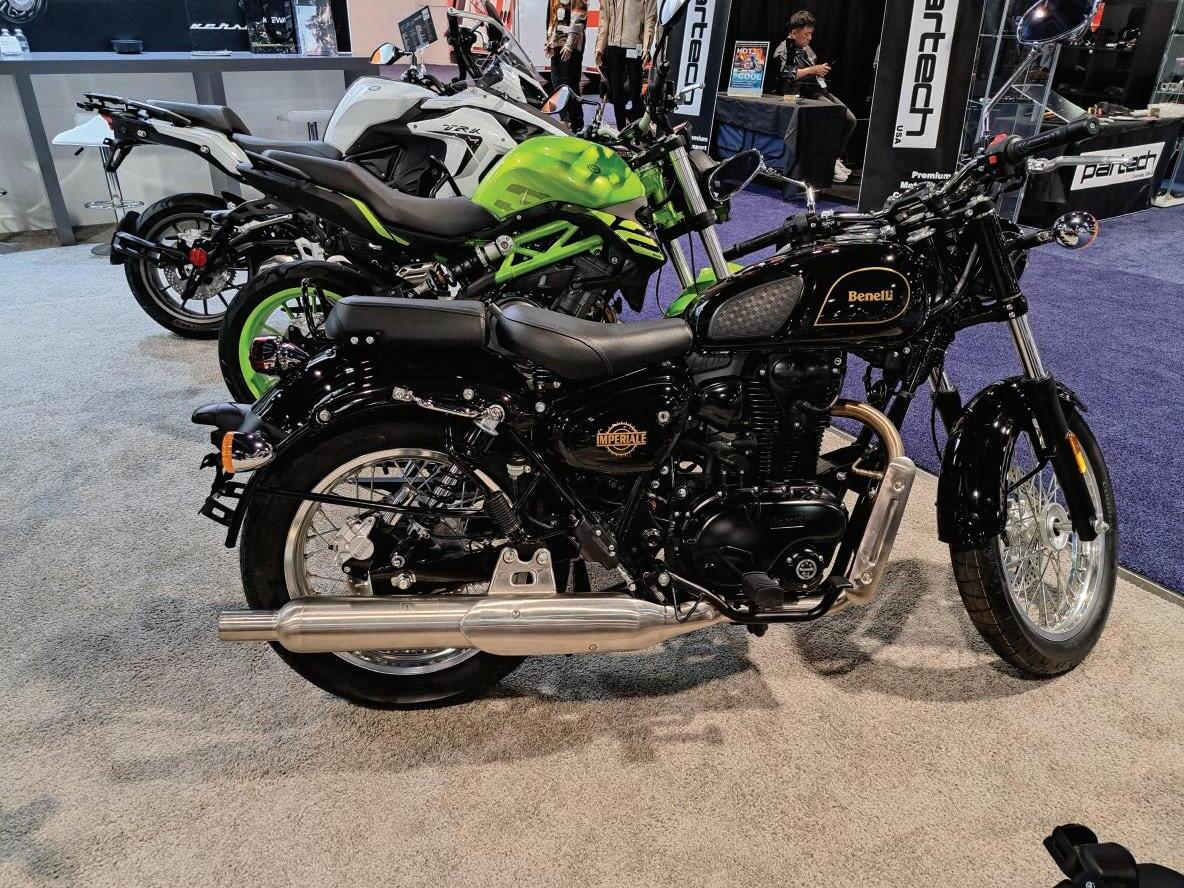
fastlane NEWS
10 www.caferacermag.com
Benelli’s Imperiale 400 single borrows from the Italian firm’s past and looks the business in all black.
their first 700cc model, the sporty SRK700. Clearly inspired by Kawasaki’s Z1000 naked speedster, the eight valve liquid-cooled twin pumps out a respectable 72 horsepower and 48 foot-pounds of torque. The sales team stressed the reliability of the QJ lineup, having run several high-mileage endurance test rides before offering their seven-bike range to a growing list of US dealers.
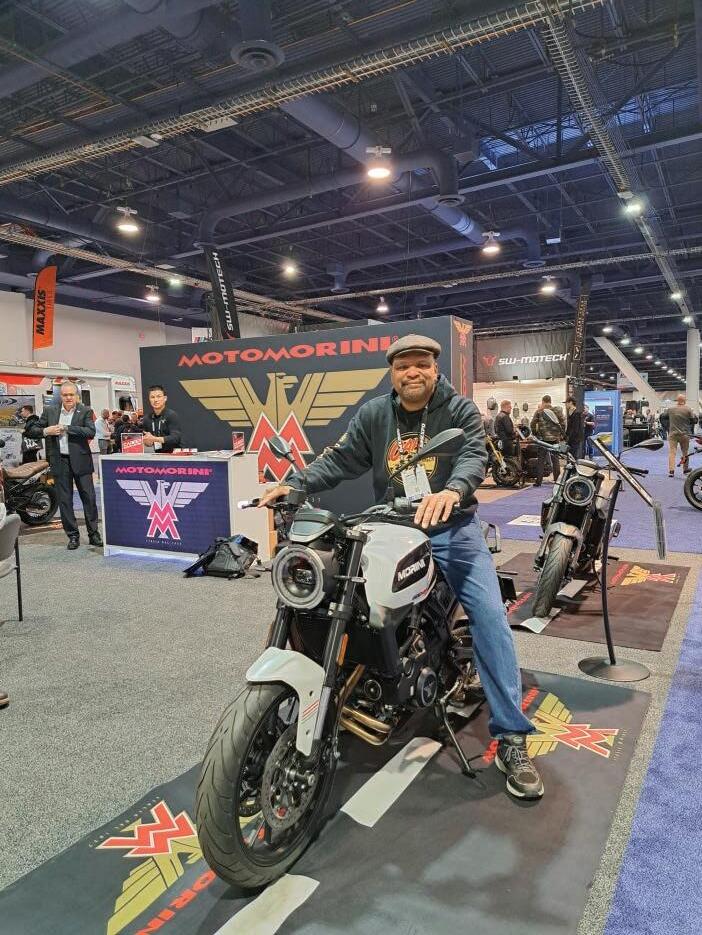

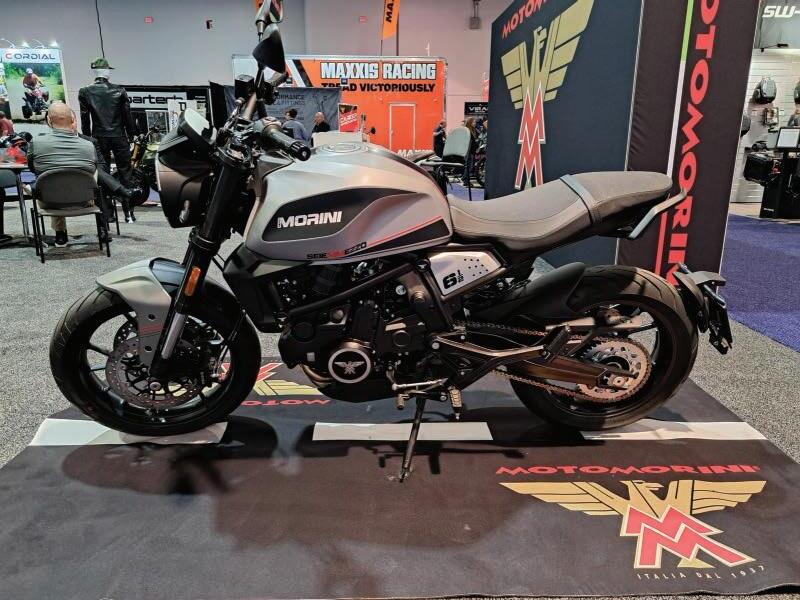
In addition to several new brands from the
rooms. The flashy and quite capable Street Triple 765 was on display, bristling with the sort of high-tech electronics their Chinese counterparts are yet to offer. Our fave turned out to be an all chrome and black version of the sporty Thruxton 1200RS, a limited edition release. The venerable Speed Twin 900 sports new paint and graphics this year and was joined by several Tiger adventure bikes, representing a growing share of Triumph’s lineup. However, the really big

Cafe Racer • APRIL/MAY 2023 11
Sweden’s Husqvarna have reduced the size of their futuristic Vitpilen neo-cafe from 701 to 401cc to attract more novice riders.
Sorry, Honey, it just followed me home and I had to keep it….
news for the British firm was on the smalldisplacement and off-road front where representatives hinted that a line of sub500cc streetbikes along with a serious foray into the motocross competition market was on the way for Triumph. Details were unavailable at press time, but it’s only at industry shows like these that longstanding industry rumors can be confirmed.

Suzuki were on hand, showing off their latest versatile streetbike platform, the parallel twin GSX-8S. The first all-new naked roadster from Suzuki in years, the 8S promises to be a game-changer with the capabilities to compete with Ducati’s venerable Monster and Triumph’s Street Triples for market share.
We were mightily impressed with the return to the American market of Italy’s Moto Morini, who revealed a broad range of streeters all powered by a 650cc, watercooled V-twin engine. Their professionally arrayed display included well-branded riding leathers and casual wear all embossed with the distinctive Morini logo from the 1970s , while the trellis-framed bikes were offered in cafe retro, standard and a funky, X-Cape version that resembled a smaller Honda Africa Twin.

Japan’s Over Racing is an aftermarket firm we’ve been hearing about for years, as we’ve been amazed by their technical excellence and perfect finishes. Over is now available in US dealers offering – among rearsets, handlebars and other hard parts –complete machined chassis for Honda’s popular Grom and Monkey Bike, and bodywork kits and suspension to transform these small cc wonders into full-blown track or road sportsters. The machining on Over’s Grom chassis was simply dazzling and they’re a great addition to the US market.
In addition to plenty of new riding gear and accessories, we were encouraged to see the show filling up with dealers, vendors and media types (like ourselves) though it would be a real plus to see AIME add a day for public attendance. This sort of interaction between industry and public is sorely missing with the recent demise of the Progressive International Motorcycle Show series, which ended last year. With plenty of new brands and new players in the recovering streetbike market, the future looks bright for two-wheeling. CR
12 www.caferacermag.com
fastlane NEWS
MV Agusta’s marketing and dealer network has been merged with Austrian heavyweight KTM who are bringing in the new, Superveloce 1000 later this year. Sweet.
QJ Motor’s SRV550 is a twin-cylinder retro with inverted forks, radial brakes and 50 horsepower. Yours for just $6,100.


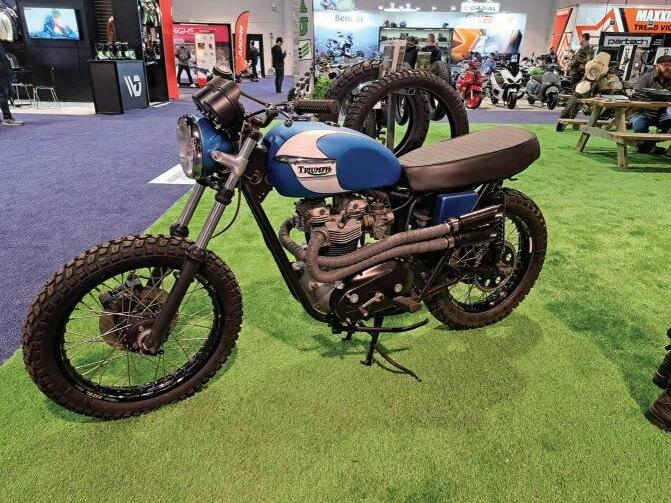


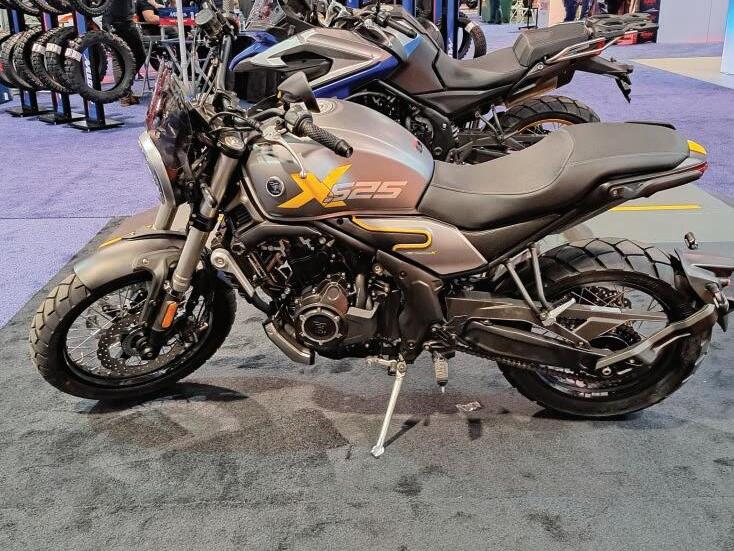

 The Voge 525 utilizes the same running gear and engine as Benelli’s Leoncino that we reviewed last issue. Copyright laws are few and far between with the Chinese manufacturers.
The Voge 525 utilizes the same running gear and engine as Benelli’s Leoncino that we reviewed last issue. Copyright laws are few and far between with the Chinese manufacturers.
New Owners For Dresda Tritons
After building the most successful cafe racer shop in British history, Dave Degens has handed off the reigns of Dresda Tritons. We recently heard the news from Russell Vann and Guy Fithen, who have been working alongside Degens for years. Now in his mid-80s, Degens has retired to a family farm in Wales while the shop is now located in the village of Ashford, near Heathrow Airport. It was Degens who popularized the Triton special in the early 1960s, creating a template for the Norton/Triumph hybrids that changed motorcycling in England and beyond. After spending his late teens as a fast-riding Ton-Up Boy, he switched to racing where he won British titles and perfected the art of tuning classic British twins and singles. By 1965, his race-tuned specials were so popular that Degens operated a small assembly line, churning out several made-to-order Tritons per month from Dresda Autos in London. Two of his
prestigious Barcelona 24 Hour Endurance Race in the mid-sixties and seventies.
We’ve visited Degens several times over the years and his fiery determination to be the world’s best specials builder never waned. Still roadracing into his 70s, the loveablebut-gruff engineer’s work will continue as the new owners will be offering sales of the extensive Dresda parts line, service and complete Triton builds going forward, said Vann, who has served as Degen’s chief welder and mechanic in recent years.

Most special of all, several of Degens’ racing motorcycles will be on offer at the Spring
ham’s come April 22-23 in England. Among the historic treasures being offered is the blue and silver 1965 Barcelona race winner, an original, 1965 Paul Dunstall-equipped Norton Domicacer 500 and a rare 810cc Dresda Honda CB750 racer, complete with bold 1970s paint on the full fairings and a re-worked featherbed replica chassis. Estimates for the bikes are not outrageous at $9,000 to $30,000, which is quite reasonable for some of cafe racing’s most treasured machines. CR
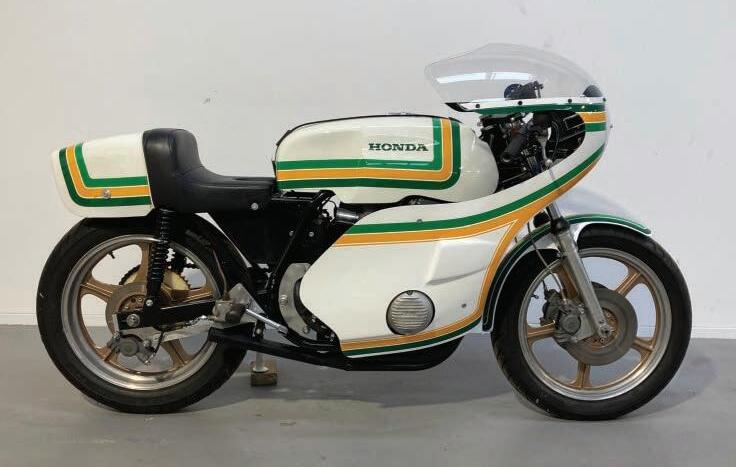

Resource: www.dresda.co.uk
www.bonhams.com
14 www.caferacermag.com
fastlane NEWS
Shop owner Dave Degens has retired to a farm in Wales while Dresda Tritons lives on under new management.
Dave Degens built this 650cc Triton and beat the factory teams in endurance racing in 1965. Now it could be yours.
In the 1970s, Dresda built a small batch of Honda CB750powered specials, with big bore engines and featherbed replica chassis. It should fetch around $15,000 at auction.


The Paddock
Iron Lilly Film Seeks Funding
As one of American motorcycling’s earliest female sheroes, Lilly Farrow proved her toughness by competing in the males-only world of motorcycle racing during the 1920s. With her husband, she founded several races and road rallies, all while raising a family, and when her husband passed away in 1927 she took over Farrow Harley-Davidson, which is still in business. If this sounds like a ready-made feature film, it may be soon, as independent film producers City of Peace are seeking funds to bring Farrow’s incredible story to the big screen. A strong team of industry heavyweights are behind the project that you can learn more about at www.ironlilly.com.

Tom Hardy Makes “Bikeriders” Flick**

British actor Tom hardy is a keen rider, frequently seen around Hollywood aboard his customized Honda CB550 cafe racer. He’s finally combined his love of biking with his screen career, filming an adaptation of photographer Danny Lyon’s seminal photography book, “The Bikeriders.” The black and white photo collection was a document of life among early 1960s motorcycle clubs, riders and racers in the Midwest, which means the plot is anyone’s guess. But this being a Hollywood movie, expect plenty of sex, violence and even actor Austin Butler from last year’s hit “Elvis” to accompany your popcorn. We interviewed a member of the film’s crew who tells CRM there are as many as 100 classic British and American bikes in the field meet scene, while painstaking detail went into reproducing the weathered leather and greasy denim costumes. Look for it in theaters this summer.
Valhalla Returns for 2023
The first Valhalla Custom Builder’s Challenge brought a new, talented crop of motorcycle designers to Chicago’s Motoblot festival last June and chief organizer Kevin Dunworth tells CRM the show will go on, bigger than ever, at this year’s event. Motoblot will bring its wild and woolly mix of custom bikes, hot rods and noisy punk bands back to Chicago come June 23 to 25th, while organizer Kevin Dunworth says there will be several more Valhalla rounds during the year. Look for an announcement on dates next issue and on our website blog.


Honda Sales Skyrocket
Honda, the world’s leader in motorcycle sales showed how it stays at the top of the two wheeled game by upping their global sales a whopping 12.5 percent in 2022. Some 17 million Honda motorcycles were sold around the world last year, after a disappointing 2020. By comparison, Italy’s Ducati sold 65,000 two-wheelers in 2022 and Royal Enfield around 1.6 million. Great to see the numbers on the upswing across the board.
Iron and Air Magazine Folds
With over 245,000 Instagram followers, the artsy motor culture quarterly publication certainly had developed a broad reach in its 12 years, but the costly ($15.00) cover price and esoteric content failed to garner a big enough fan base to keep it on the newsstands. The company had also purchased the popular custom bike website Bikeexif in 2021 which remains in business.
Our Favorite Jokes
A man hit the lottery for half a million dollars and immediately looked into penis enlargement surgery.
He consulted a surgeon, and asked how many inches he could get for $500,000. The doctor replied, “It’s about 100 grand per inch.”
The lottery winner went home, excited to discuss the procedure with his wife.
The doctor called to follow up, and asked how many inches the patient decided to purchase.


“Granite counter tops, ” the man sheepishly replied.


 Contributed by Lee Patterson
Contributed by Lee Patterson
14 www.caferacermag.com Custom and Classic Bike News
29023 Cafe Racer Bike Show Date Set





Sunday, August 13th is the date for this year’s Cafe Racer Magazine Ride-In Bike Show, the 15th running of the only outdoor show of its kind. Dedicated to running, roadworthy cafe racers both new and classic, plus custom streetbikes of all sorts, this year’s event returns to Sewickley’s War Memorial Park just outside of Pittsburgh for a full day of two-wheeled fun. Our expanded vendor’s row will see some top-shelf parts and accessories on display while food trucks, microbeer vendors and some $3,000 worth of prizes from our sponsors make for six, hotly-contested trophy classes. Learn more this spring by visiting www.caferacermag.com/bike-shows.
National Motorcycle Museum To Close

After 22 years of displaying an eclectic mix of period customs and rare vintage street and race machines, Animosa, Iowa’s National Motorcycle Museum will be closing its doors in September. The collection was the passion of late J&P Cycles founder John Parham who passed away in 2017. The vast displays covered everything from wild handmade bobbers from the post-WWII era to British and Japanese cafe racers and fabled competition machines from the likes of Daytona 200 winner Dick Mann. Many of the over 500 motorcycles on display will be returned to their owners, but the future of Parham’s personal collection remains unknown. Curator Mark Maderski says he hopes a new investor will step in and keep the museum’s mission rolling, which would be great news for classic bike fans everywhere.
Still No US dealers for BSA




Ton-Up TV Season II Starts Filming
With the first season of seven episodes now available for streaming, Ton-Up TV, our video streaming series, is gearing up to begin filming season II in May. The series chronicles the custom and classic motorcycle builds going on inside the CRM garage and our travels to rallies and events around the world. This season will include a build by prolific cafe racer shop MotoPGH who’ll crank out a Honda CB350 custom while our own Honda CB750, Norton Atlas and other project bikes are put under the microscope. See the series that viewers are calling “the best – if not only –custom motorcycle series currently available” by clicking on www.tonptv.com.

Irish Roadracing Season Avoids Cancellation

The entire 2023 season of real roads racing in Ireland was nearly shelved thanks to a very American problem – insurance underwriting. The current cost of insuring a major road race like the annual North West 200 runs just under $500,000 organizers said, which prompted the entire season’s cancellation in February. However, at presstime, the Motorcycle Union of Ireland had received a more reasonable insurance quote which means the Northwest and a several additional competitions will still be held.
The revamped, re-engineered BSA Gold Star is finally reaching showrooms in the United Kingdom, with prices for the fuel-injected 650cc singles starting at 6,600 pounds (or roughly $7,100 US.) The Indian-manufactured brand is standing on its reliability, offering two-year warranties on the retro Goldie, which is yet to appear in Stateside showrooms. A company spokesperson assures CRM the bikes should reach our shores by year’s end with prices yet to be determined.
Cafe Racer • APRIL/MAY 2023 17
The Paddock


The beefy muscle bike has long been the Italian firm’s misfit toy, being neither cruiser nor sportbike, falling somewhere in between the two. For 2023, Ducati have tilted the Diavel towards the sporting end of the scale, adding a more dynamic new chassis, a de-tuned version of the 1,158cc V4 powerplant from their Panigale superbike, uprated suspenders and sexy new bodywork. Voted the Most beautiful Bike at the recent EICMA industry showcase in Milan, Italy, the revamped bike features massive side intake ducts, quad exhaust ports and a full roster of electronic rider aids to help contain the 168 horsepower engine. Weighing 491 pounds wet, the Diavel is said to handle like a far lighter machine thanks to its superb engineering and balance. In showrooms now, starting at $26,695.
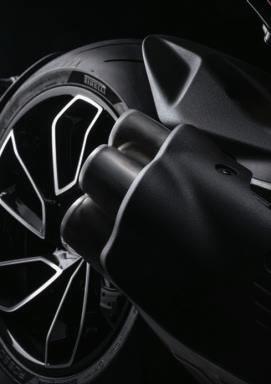
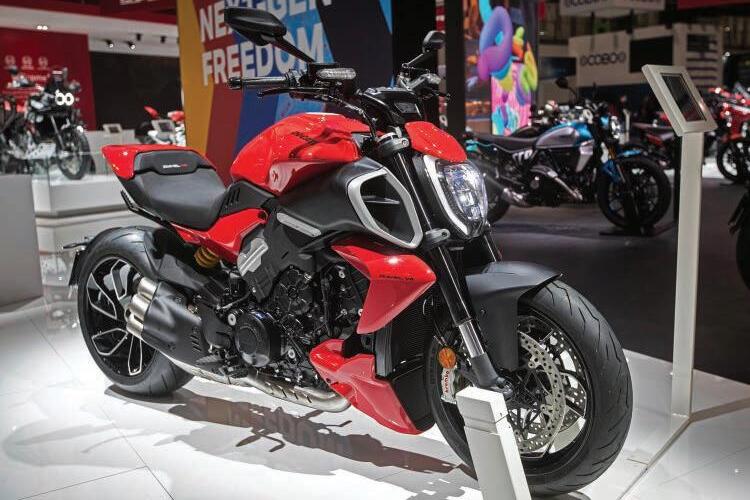
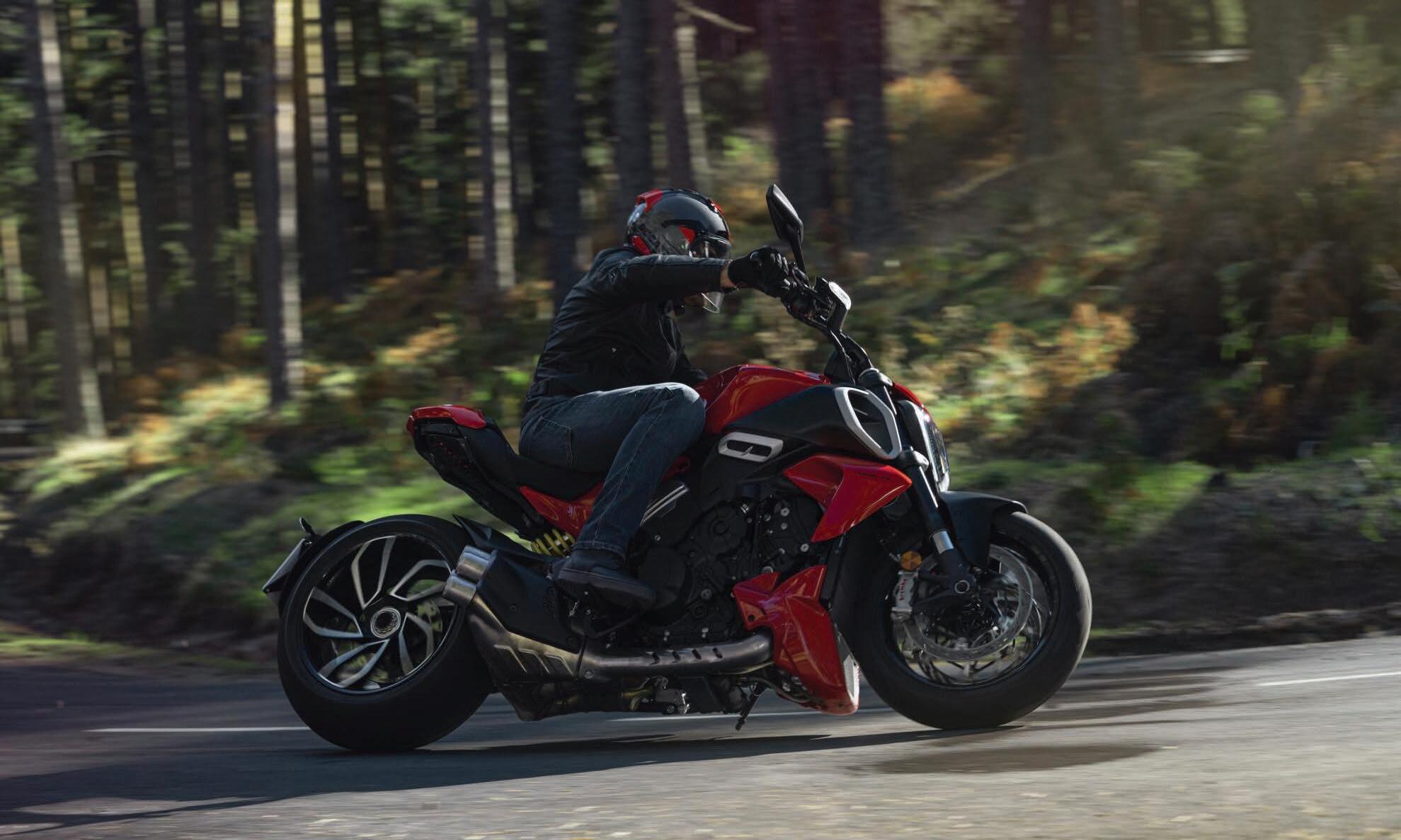
18 www.caferacermag.com
As the biggest-selling Moto Guzzi ever, the retro-flavored V7 is at once adaptable and easy to ride. The Italian manufacturer expands the line – which is actually powered by an 860cc engine – to include the special edition Stone for 2023. Done up in timeless black and red livery, the Stone features specially colored red shock absorber springs, graphite valve covers, special tank detailing and anodized throttle body covers. The power and handling remain as superb as always with the six-speed gearbox hitched to a clean-running, maintenance-free shaft final drive. A new Arrow canister exhaust is standard, taking horsepower from 60 to 65 at 6,700 RPM while 54 foot-pounds of torque kick in at just 4,900 on the tachometer. Still aircooled and easy to maintain, the Stone is just $9,990 on the road at your Guzzi dealer.





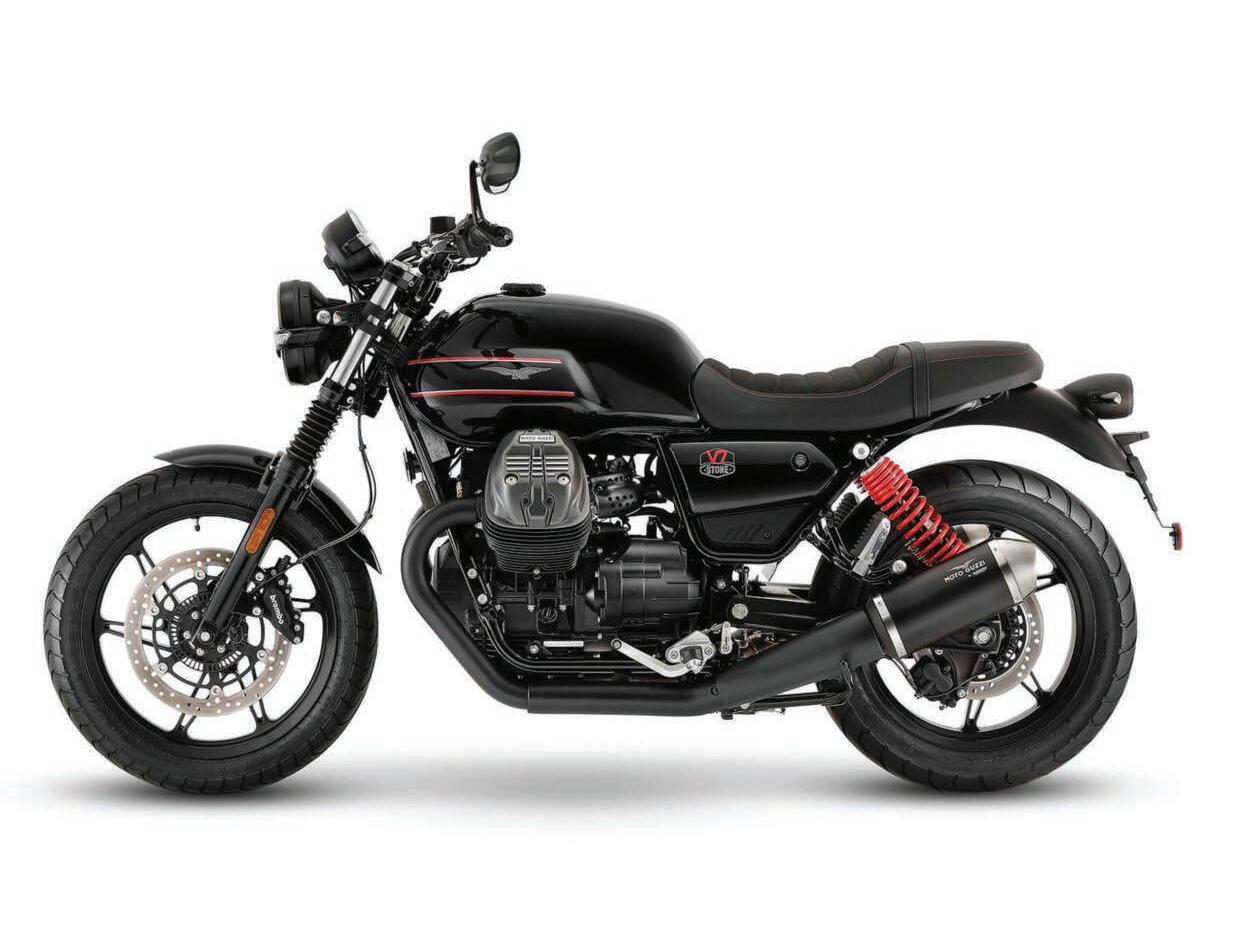

Cafe Racer • APRIL/MAY 2023 19
The PaddockNew Motorcycles 2023
Indian FTR 1200

The world’s only big bore factory street tracker is back with an expanded four-bike lineup for ‘23, making Indian’s tasty FTR 1200 even more attractive to buyers. The welded trellis frame remains, though the addition last year of 17” wheels, replacing the oddball 18” rear and 19” front set-up of earlier models, is gone. This makes cornering and direction changes more accurate while that wonderful thrumming eight-valve, water-cooled V-twin engine is as pleasing as ever. The FTR’s new models include the R Carbon edition that’s generously sprinkled with the light-
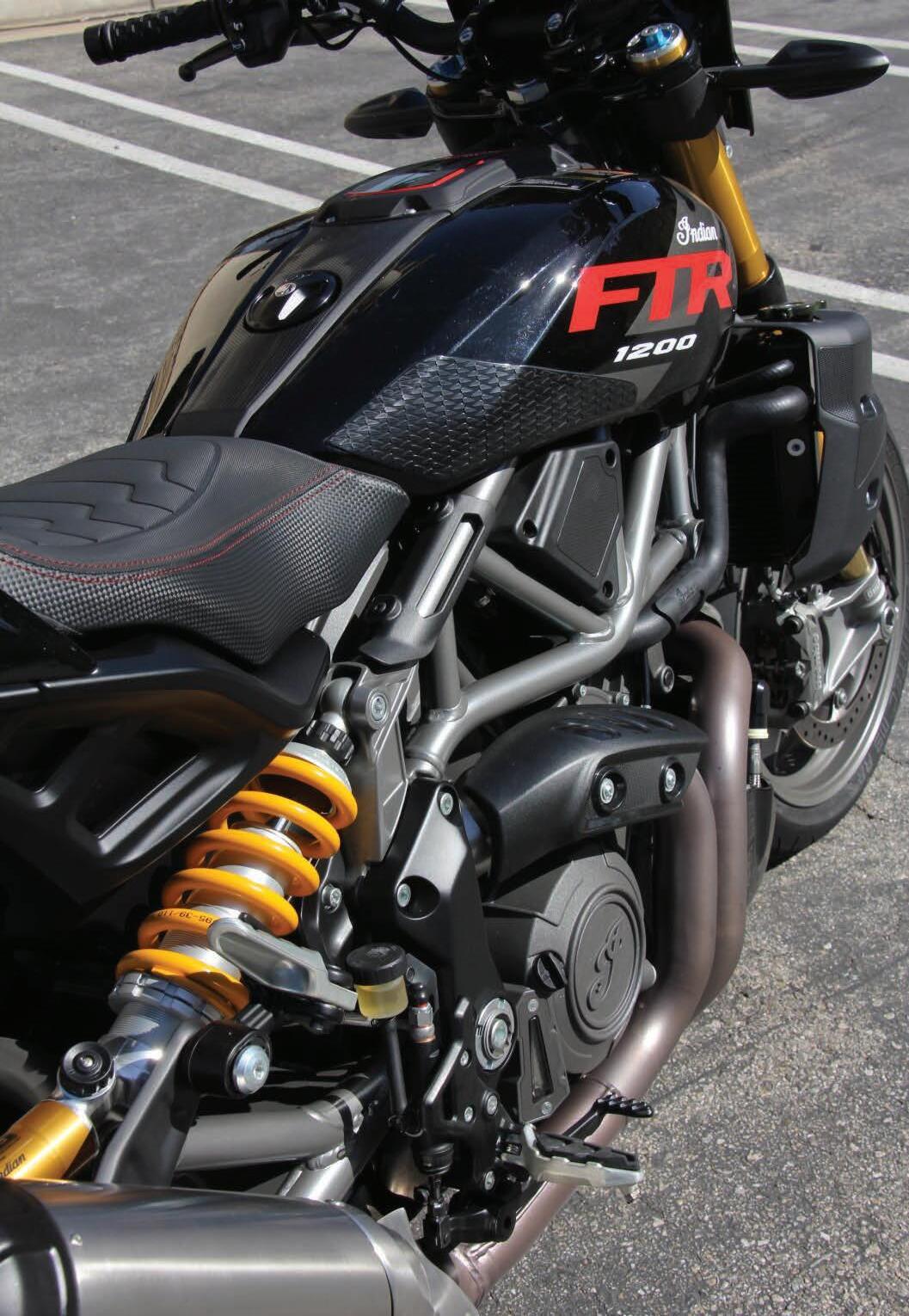
20 www.caferacermag.com
BMW R 1250 R
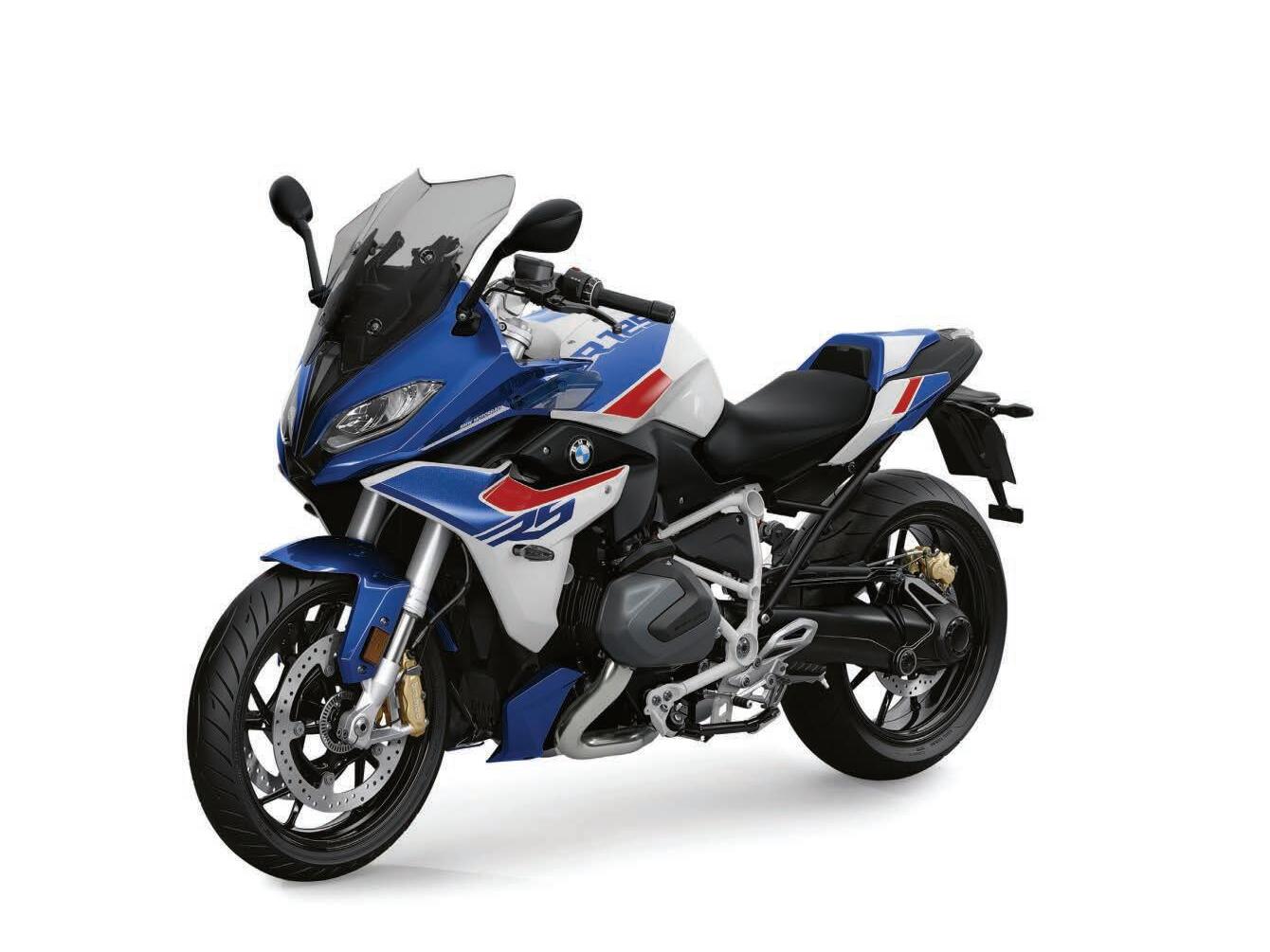
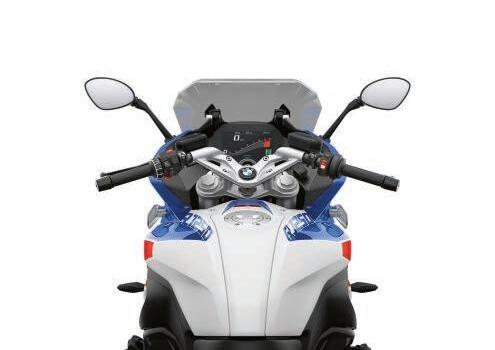


We were blow straight away by BMW’s blisteringly fast S 1000 R super naked (issue #83) but for those seeking a less frantic, demanding slice of German technology, look no further than the sporttouring R 1250 R. This versatile machine features BMW’s venerated aircooled Boxer twin engine cradled in a spare combination steel trellis and stressed-engine chassis. Bristling with the latest tech that helps the Boxer run smooth and very powerfully, the 1250cc twin pulses out an impressive 136 rear wheel horses, but manages to do so while being environmentally clean and seriously fuel efficient. Integral ABS is standard as are traction control and racy blue and white paint reminiscent of BMW’s World Superbikes. There’s USB charging for rider and passenger, a Bluetooth-enabled full-color dash plus heated seats and handgrips. Handling is typically BMW inch-perfect thanks to lightweight 17” cast aluminum wheels with Brembo radial stoppers, inverted 43mm front forks and a Paralever rear shock with 5.5” of travel. From $14,995.

Cafe Racer • APRIL/MAY 2023 21
Prac tical Per formance
Aquick pre-ride walk-around of Triumph’s 1200cc Speed Twin proves the crew at the Hinckley, UK plant did all the proper research before building this modern Bonneville. The rounded lines of the 3.8 gallon fuel tank date back to the original late 1930s Speed Twin while the upright stance of the parallel twin motor is classic Triumph. There’s a small radiator for this watercooled machine, which makes the engine cooling fins an aesthetic exercise and even the fuel injector throttle bodies are crafted to resemble 1950s Amal GP carburetors, though this styling touch may be lost on customers too young to remember something called carburetors.
Look further forward and it’s clear that the Speed Twin is a fully 21st century motorcycle. The inverted 43mm Marzocchi forks could easily work on a Street Triple naked sportbike and the left handlebar switch has more buttons than your average cable TV remote. As its looks suggest, this hybrid roadster perfectly straddles the retro factory cafe racer world while keeping a boot firmly in the performance naked camp, a rare feat for any motorcycle.
Triumph have had plenty of practice designing bikes that evoke nostalgia while being fast enough to keep hooligans happy. Their early Speed Triples pleased both racers and rockers and while first-gen Bonnevilles weren’t exactly fast, after increasing capacity to

22 www.caferacermag.com
Story by Mike Seate • Photos by Jose Gallina
??? FIRST RIDE Triumph Speed Twin 1200
Personified
1200cc in 2016, the new twins were (nearly) as performance-minded as Triumph’s triples.
As expected, the ST is comfy to sit upon, with a flat roomy seat and low tubular handlebars. Footpegs are also at a reasonable position, just slightly rear set, but not too tall. The flat(ish) orange paint manages to be both attentiongetting and subtle at once and guests at the hotel where these photos were shot frequently stopped to ask, “When did they started making cool-looking Triumphs again?” proving the brand’s instant recognition factor.
The Triumphs they imagined were never this capable, as the Speed Twin turns over with an audible cam gear whine and a lumpy, eager exhaust note. Spot-on fuel injection mapping and ride-by-wire throttle actuation mean low gear meandering to the interesting roads is neither jerky nor abrupt. As the former owner of a 2017 Thruxton 1200, I know the engine’s characteristics well and the Speed Twin is very similar on the go.

Feeling lighter than its 475 pound weight, the ST easily transitions from side to side, a bit of countersteer is all that’s needed to change lines. A 160mm rear tire and a steep 22.3 degree rake angle aids the light feel and keeps the Triumph poised through the next corner. The bike does carry its weight low down in the tubular steel cradle frame, prompting you to employ more pressure on the pegs than expected, but there’s a fluidity to the way this big twin moves that’s downright surprising. Torque is where it’s at with the 1200 Bonnevilles, so shortshifting between the gears supplies all the go you’ll ever need. Want to challenge a 200 horsepower hyperbike from the stoplights? The 98 horsepower Speed Twin is up for it (for a while, anyway). Want to whack the throttle and feel the 17” front radial get light under the bars? Those kinds of highjinks are all in a day’s ride for the Triumph’s 83 foot-pounds of torque, a grin-machine if ever there was one.
Even the notoriously notchy Triumph gear changes are absent on this cable-actuated, six-speed transmission, though I’m surprised there’s no up-down quickshifter in place.
Cafe Racer • APRIL/MAY 2023 23

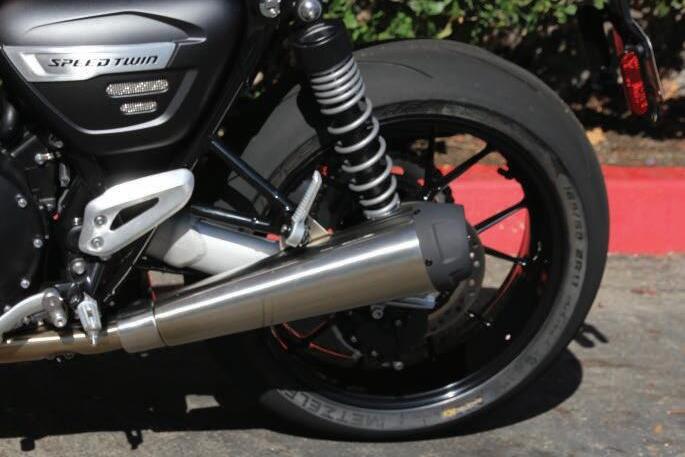

24 www.caferacermag.com
FIRST RIDE Triumph Speed Twin 1200
No, Ma, no quickshifter. None needed with the fairly smooth six-speed transmission.
Those ordinary-looking mufflers emit a cacophony of lovely noise, just like Bonnevilles of yore. Metzeler Racetec radials are capable of serious lean angles.
Too many stern-looking CHP speed traps made me leery of pushing the Triumph much north of 90 MPH, but even on windswept Kanan Dume Road, the Speed Twin held steady at the ton and felt as if there was plenty more on tap. Over a couple of road bumps that felt like prostate exams, the rear shocks did bottom out, but it’s fair to assume Triumph’s engineers didn’t design the preload-only adjustable dampers for 250-pound Yanks. That’s a shame as the Speed Twin’s racy inverted forks, very sticky Metzeler Racetec radial tires and downright unruly engine are able enough for a track day fast group, though the budget rear shocks seem like an oversight. Still, there’s too much fun to be had – and
too deep an aftermarket for late-model Triumphs – to let slightly soft dampers ruin the outing.
Even though this bike sits too low and is far too comfortable to be mistaken for a sportbike, there’s plenty of practicality (remember that concept?) with a seat that’s flat enough to bungee packages to, a two-year warranty, rear-view mirrors that actually work and 41 MPG fuel economy.
As a true heir to the classic cafe racer mantle, the Speed Twin is just about the perfect mount: the painless riding position doesn’t cause aches or cramps, there’s more than enough power on tap, the looks are retro-groovy and the line of Bonneville

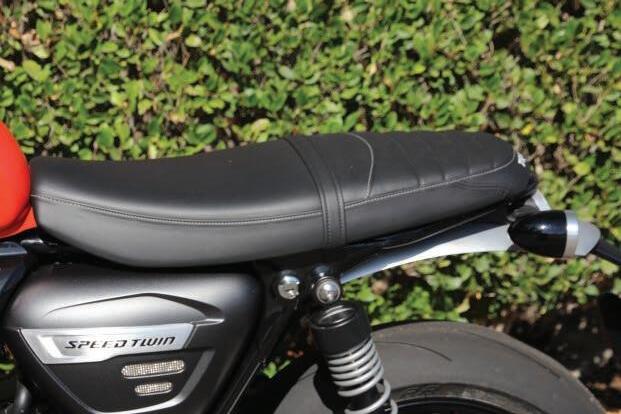
1200s is popular enough – and affordable enough – that the Speed Twin will hold its value over several years.

We Dig: The classic looks and massive lowdown power
We’d Ditch: The budget rear shocks CR
2023 Triumph Speed Twin 1200
MSRP: $12,895
Engine: 1200cc water-cooled, eight valve parallel twin
Transmission: Cable-actuated six-speed
Brakes: Dual Brembo radial monoblock four-piston calipers with 320mm rotors, front; single 220mm rotor with two-piston Nissin caliper, rear
Wheels: Cast aluminum 12-spoke 17”x 3.5” front: 17” x 5” rear
Tires: Metzeler Racetec radials

Suspension: 43mm Marzocchi inverted forks with 5” travel preload adjustable; Fox twin shocks, preload adjustable with 4.7” travel
Weight: 475 pounds
Fuel Economy: 41 MPG
Electronics: Ride-by-wire throttle, three riding modes, traction control and ABS
Power: 98 horsepower @ 7,250 RPM; 83 foot-pounds torque @4,250 RPM
Cafe Racer • APRIL/MAY 2023 25
Same as it ever was, the Speed twin’s bulbous fuel cell dates back to 1938.
The Speed Twin’s flat, long saddle ain’t sexy, but boy, is it practical.
Radial Brembo monoblock four-piston front stoppers work their magic, aided by ABS.
MV Agusta Superveloce 800 A Wolf in Tight-Fitting

Sometimes contributor Blake Kelly was the first to eagerly grab the keys to the 2022 MV Agusta Superveloce, having raced many an ergonomicallychallenged 600cc supersport back in his AMA and WERA days. Blake is accustomed to the triple’s demanding, almost two-stroke-like powerband, a rev range with a stratospheric redline of 13,000 RPM. Pulling a massive power wheelie after less than five minutes on the MV, he came back from an initial test ride full of praise for the hot-selling machine.

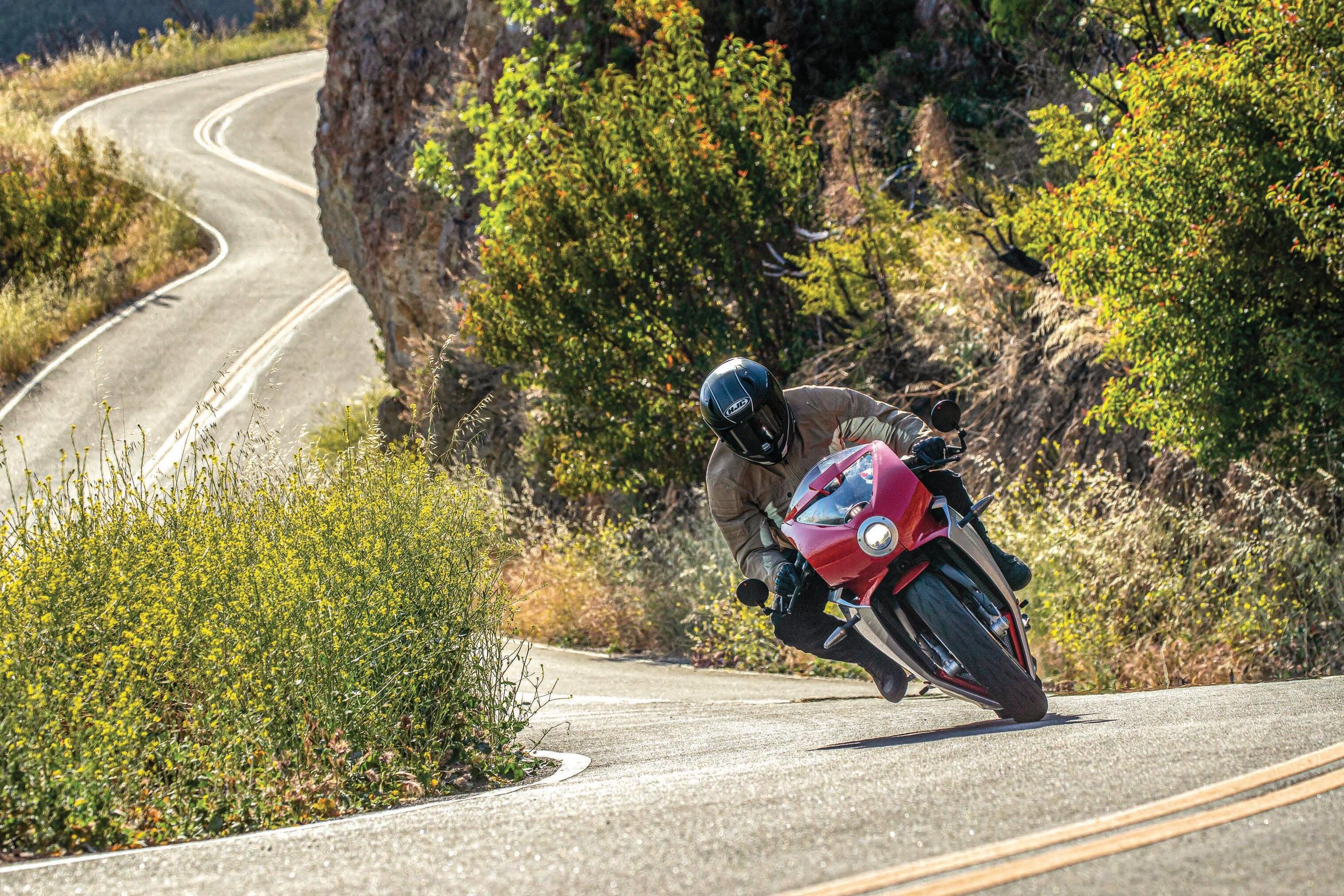

Italian Clothes
“I rode your old MV F4 1000 and it was just too much power for the street. This thing has a load of power, but you really have to go after it, revving it like a 600 until the thing just goes ballistic and takes off like a rocket,” he said breathlessly. Blake also praised the MV’s light weight and pinpoint handling, its feeling lithe and flickable like an old 250cc racebike in the corners.
We all expected this sexy imported toy to be a corker when pushed hard, but what’s the Superveloce like to live with on a regular basis?
26 www.caferacermag.com
Compiled by The Staff
??? LONG TERM RIDES
After our first year with the bike, which we’ve slowly been modifying for an upcoming episode of Ton-Up TV, here’s our collective verdict:

1. Not Roomy, But Not Horrible.
In our initial test ride, expert racer Joe LaCroix complained that the MV was too uncompromising and difficult to ride to really get the best from. And while he was correct in some respects – the bike is narrow and the angular bodywork can jut into one’s soft bits – we’ve found the Superveloce to be no worse on the knees and neck than any other middleweight sportbike. A few minutes of pre-ride stretching helps a great deal, as did lowering the footpegs 2” by installing a set of extended pegs, found on eBay for just $49. Riders over 6’ can forget about ducking behind the low windshield for relief from the wind, but nobody buys a bike like this for touring.
2. The Engine – Mechanical Bliss
The water-cooled 12-valve 800cc powerplant is a revelation, pure and simple. It sounds like a dryer full of wrenches at low revs, but on the move, the short-stroke design develops a fierce, animalistic growl that grows more addictive with each twist of the ride-by-wire throttle. Free-revving with well-regulated fueling, it’s a blend of modest bottom-end torque and a screaming top end that’s goosebump- and traffic citation-inducing. It will easily hit 150MPH in sixth gear and CRM photographer and MV expert, Jose Gallina, says tuners have unlocked an additional 25 horses and 12 MPH, in case you’re somehow not satisfied with what’s already on offer. We needed more noise so we added an SC Project three-into-one exhaust ($799), which sounds glorious. Throw this baby in fourth, aim the front wheel at a series of bends and feel the magic.

3. Agile Handling
More agile than Spud Webb in new Nikes, this motorcycle is the tool for track day addicts and cornering-crazed cafe racers. As agile as an Olympic sprinter, the 481-pound triple is blessed with a steel trellis/aluminum chassis (how Italian!), Marzocchi inverted forks and an adjustable Sachs shock that create a symphony of perfection when roads become bendy. In an age when manufacturers no longer make poor handling bikes, this is one of, if not, the best.


Cafe Racer • APRIL/MAY 2023 27
LONG TERM RIDES
4. Usability...or Lack Thereof
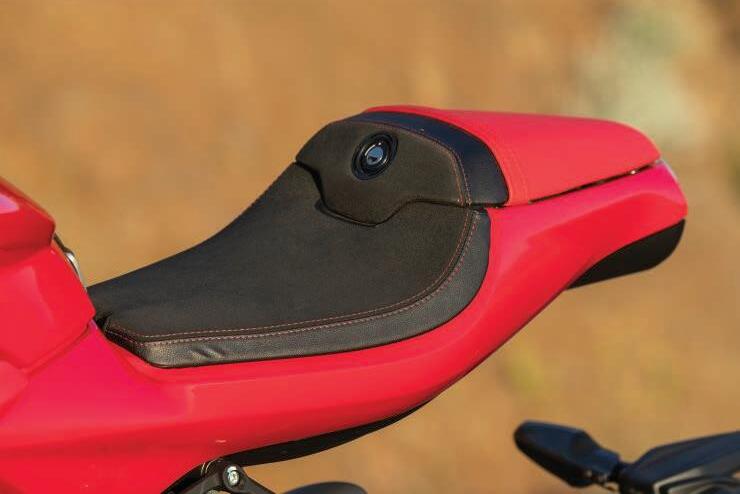
With a composite material fuel tank (read: plastic) magnetic tank bags aren’t an option. This left us struggling to carry anything larger than a fanny pack. At one point, our tech Jeremy Haynes even bunjeed a tank bag to the tank in desperation. The pillion pad, which is too small for an actual human passenger, is covered in a tactile, mock suede which means you can (with luck) strap a six-pack or your lunch there. As expected, the brakes are world-class and fuel economy is decent at 40 MPG, giving the 4.4-gallon tank a range of 158 or so miles. Unless you’re A) three feet tall or, B) work as a yoga instructor or gymnast, you’ll be stopping long before then. Despite Blake and Jeremy’s’ throttle abuse, the MV never burned any oil but the chain did become very slack at just over 500 miles.
5. Details To Please
Everyone seemed to dig the (purely decorative) brown leather strap that spans the fuel tank and the careful (and deliberate) branding exercise MV undertook with the SV, which places their distinctive logo on every available surface from the handgrips to the fuel cap rim and engine covers. The engine’s designer even signed the motor, which is very House of Gucci. There are functional bar-end mirrors, a singlesided swingarm and curvy alloy wheel spokes that are sharp looking, though getting the rear wheel off the pavement for a chain adjust or lube requires an outlay of $519 for MV’s own race stand, although knockoffs are available at $200. The full-color dash is programmed with everything from a lean angle sensor to Bluetooth and GPS settings, but it requires a 300-page owner’s manual (included) to sift through. We still can’t find the engine temperature gauge.
Overall Impression
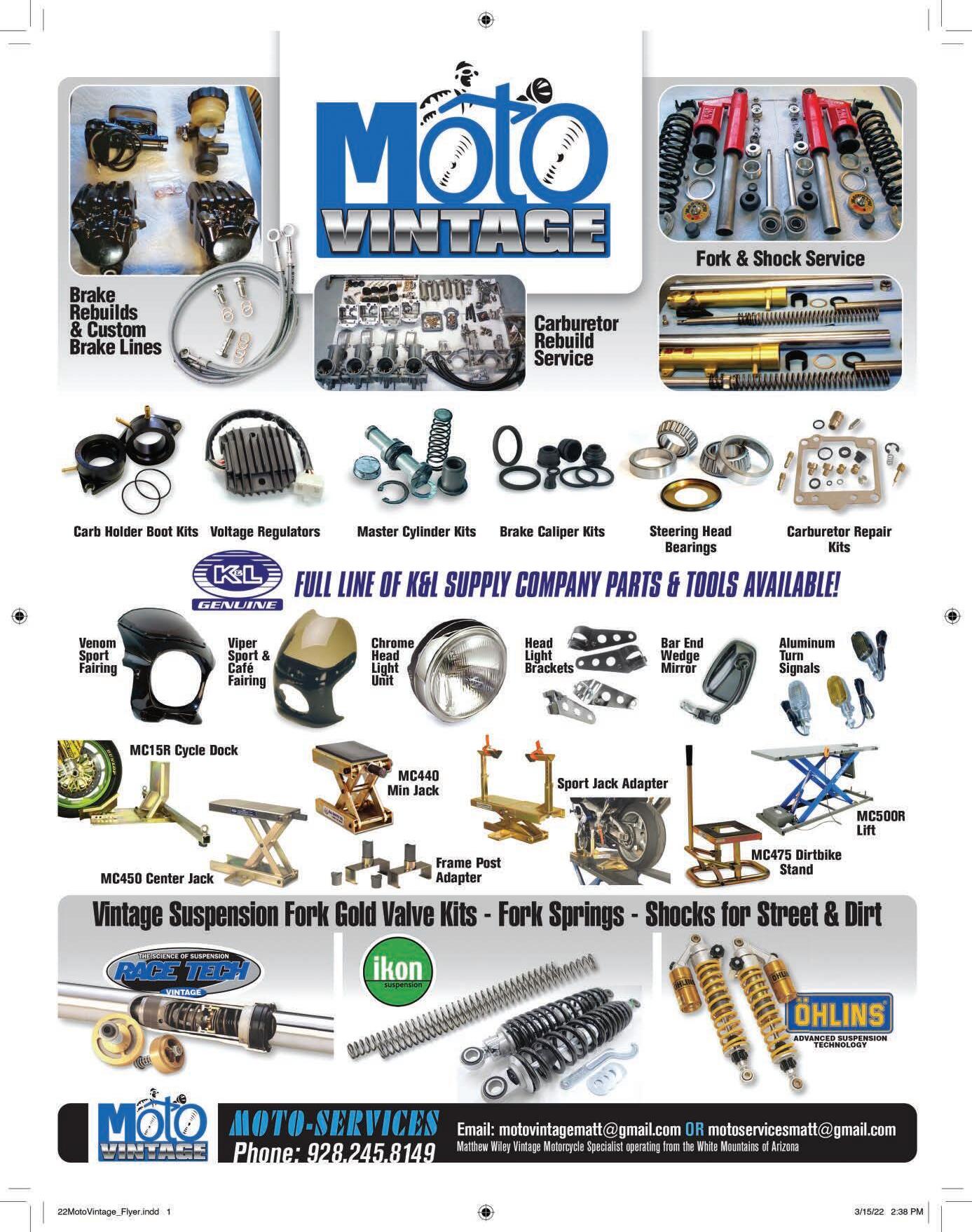
The MV Agusta Superveloce is built upon a proven platform, simply being the F3 superbike in retro bodywork. It’s reliable and satisfying and gives a pride of ownership that, for some, only exotic small-batch motorcycles can. MV’s spotty dealer network was a definite drawback, but a recent merger with KTM means that’s all about to change for the better. Service intervals come at 600 miles (around $475) and a major service at 9,000 miles costs a bit more.
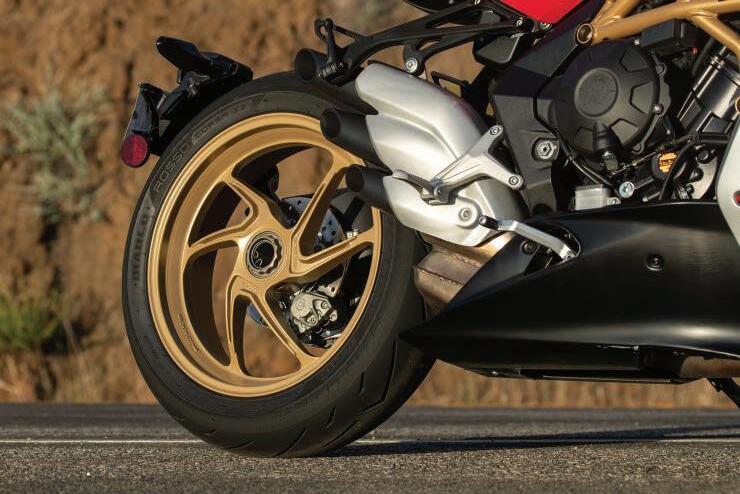

Short of building your own Italian cafe racer, the Superveloce is custom in a crate with the performance to back up its looks.
Verdict ***** (five out of five stars)
28 www.caferacermag.com

Top Gear
Choice Accessories for the New Riding Season
FEATURED PRODUCT
Ridevision Motorcycle Alert System

We caught a demonstration of this brilliant new electronic safety system for streetbikes at the recent AIME expo. Designer and CEO Uri Lavi says the Ridevision system utilizes two camera sensors mounted at each end of your bike that measure potential hazards like cars following too closely behind, a bike’s distance to vehicles in front and dangerous overtakes of your bike from all angles. The compact kit fits any motorcycle and offers 360 degree surround sensors to alert riders when cars may be entering your lane space by activating bright red lights in a set of connected rear-view mirrors. Brilliant, safe and affordable for just $700 from www.ride.vision.
Woodcraft Universal Clip On Adapter

This handy CNC-machined handlebar mount will solve all your custom cafe racer’s handlebar issues regardless of year, make or model. The Woodcraft universal clip-on adapter mounts up easily to your ride’s top triple clamp thanks to an easy-to-drill adapter plate. The clip-ons are available in either 1” or 3” rise versions to suit your personal riding style and the kit includes everything you need to accurately measure, drill and install the plate. Retail prices start at $299.99 from www.woodcraft-cfm.com or a call to (978) 297-2977.
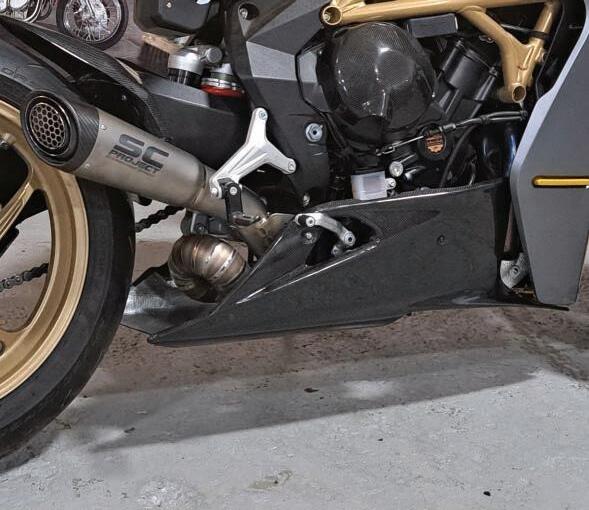
Motocomposites Carbon for MV
MV Agusta’s 800cc Superveloce is arguably the most alluring Italian motorcycle in decades and Canada’s Motocomposites has created carbon fiber accessories to further beautify this Mediterranean thoroughbred. There’s a rear fender, undertray and other bits for sale, but our fave is the gorgeous two-piece bellypan that bolts on in minutes and removes a couple of pounds of unsprung weight and costs just $649 from www.motocomposites.com.
30 www.caferacermag.com
Sandflex Sanding Blocks

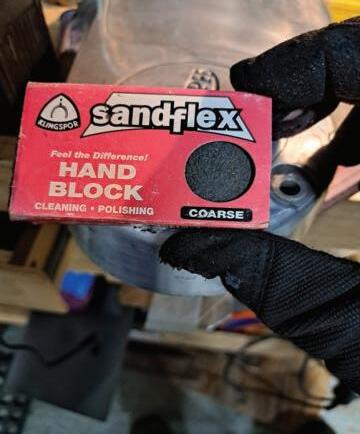
Tired of sandpaper that wads up and wrinkles when smoothing and contouring bike parts? These Sandflex blocks take the hassle out of the process. The convenient 3”x2” blocks are pliable enough to work on convex surfaces and a three-pack includes coarse, medium and fine compounds for refinishing metal surfaces of all types. A workshop must at just $20 from online retailers and hardware stores.
Royal Enfield Book
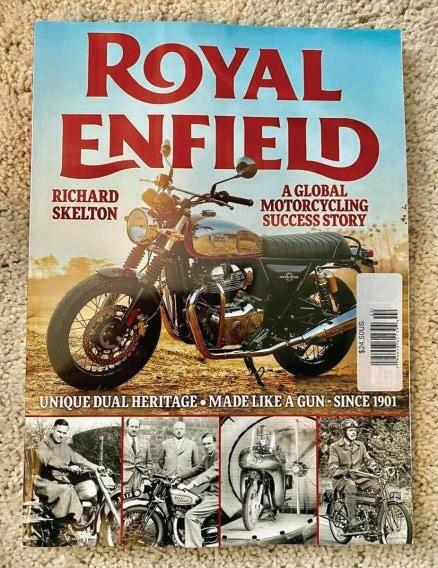
If you’re among those who wonder how Royal Enfield became just one of several formerly British bike brands to find unprecedented success under Indian ownership, you should point your peepers at Richard Skelton’s book, “Royal Enfield, A Global Motorcycling Success Story.” The illustrated 132-page book explores the technological and economic factors that made Enfield one of the industry’s leaders, forging a path towards the future with innovative, practical machines beloved the world over. Just $20 from online booksellers.
Over Racing Rearsets and GROM Chassis Kits

Slick actuation, incomparable machining quality and race-proven effectiveness are all part of Over Racing’s rearset controls. Previously available only in Japan, these billet aluminum foot controls fit most modern and some vintage machines and are available in polished alloy or black anodized finishes. Prices start around $500 US. Also on offer are these beautifully-made alloy chassis kits for Honda’s popular GROM commuter bike. The adaptable 125cc mini-machine has developed a global cult following and Over is offering complete perimeter frame kits that transform your GROM into a pocket sportbike, complete with inverted adjustable forks, upgraded rear suspension and racy fiberglass bodywork. Check out a world of new bits at www.over.co.jp.

Cafe Racer • APRIL/MAY 2023 31
Rev Up and Embrace Spring with These Choice Biking Events
Classic Motorcycle Day When It Happens:
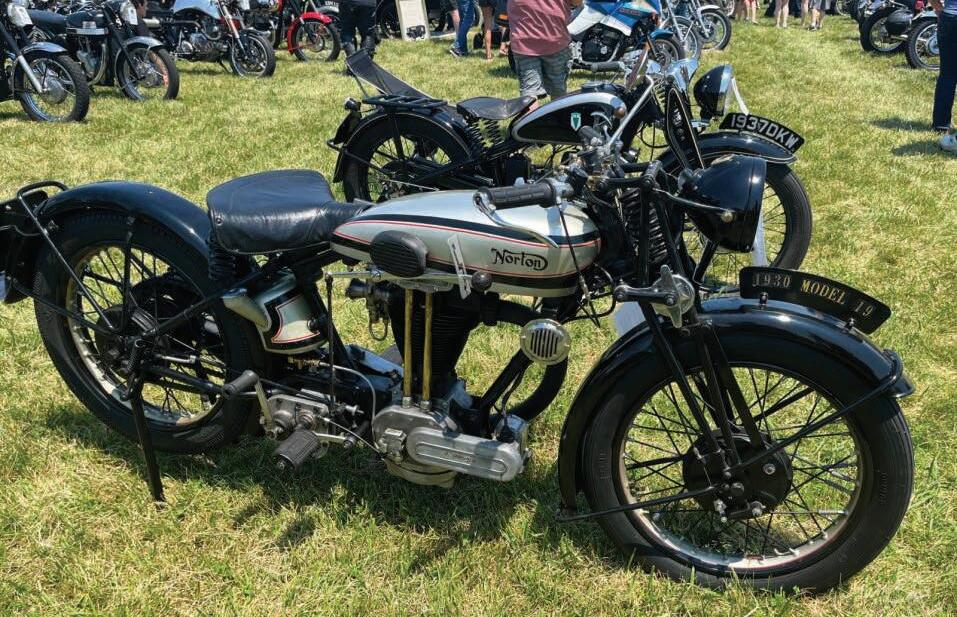
Sunday, May 21 Where On The Map: Mount Airy Maryland
The Mid-Atlantic region’s premiere vintage bike celebration has grown thanks to a new location that’s a brief ride from the biking Meccas that are Baltimore and Washington, D.C. Every garage, barn and vintage repair shop in the Northern Appalachians empties out its stock to buy, sell, trade and basically celebrate motorcycling’s oily, kickstart-only past. Enter your prized ride in one of several trophied bike shows, grab some home-cooked grub or just dig on the assembled displays. In recent years, Classic Motorcycle Day has been bathed in glorious sunshine, so it’s worth a ride. Bring a truck as you’ll be tempted by the sprawling swap meet.
Moto GP, Austin Texas When It Goes Down:

Sunday, April 14 to 16
What’s The Place: Circuit of the Americas
If watching screaming, flame-belching 200 MPH racebikes whip down the track has not yet made your list of motorcycling must-sees, the annual Texas Moto GP round at the nearly perfect Circuit of the Americas is a great place to start. “MotoGP riders are pure mutants, able to ride faster and achieve things us mere mortals can only dream of,” is how CRM contributor
Alonzo Bodden described the physics and gravity-defying spectacle laid down by these 140-pound acrobats on two wheels. It pretty much sums up the awe-inspiring spectacle of motorcycle racing’s highest echelon. Book your seats early as the series’ only US date is growing more popular each year. Bring ear plugs – and a fat wallet – this is not a cheap date.
DESTINATIONS
32 www.caferacermag.com
Handbuilt Show, Austin Texas
What Day: April 14-16

Where: Austin
American Statesman
Sure, it’s yet another hipster-oriented indoor custom bike show and if you’ve seen one knobbytired CB550, you’ve seen 300. But put aside the jaded approach to these look-alike, twentysomething invitational events and revel in the astonishing craftsmanship and out-of-thebox engineering on display. For every bike that’s never had gas in the tank and oil in its engine, there’s some genuine finds at the Handbuilt, including painstakingly restored antiques, heavily modified racebikes and, as we’ve found, plenty of interesting rideable metal parked outside in the general admission parking area. Bring a trucker cap and/or neck tattoos.
The Bike Shed Moto Show
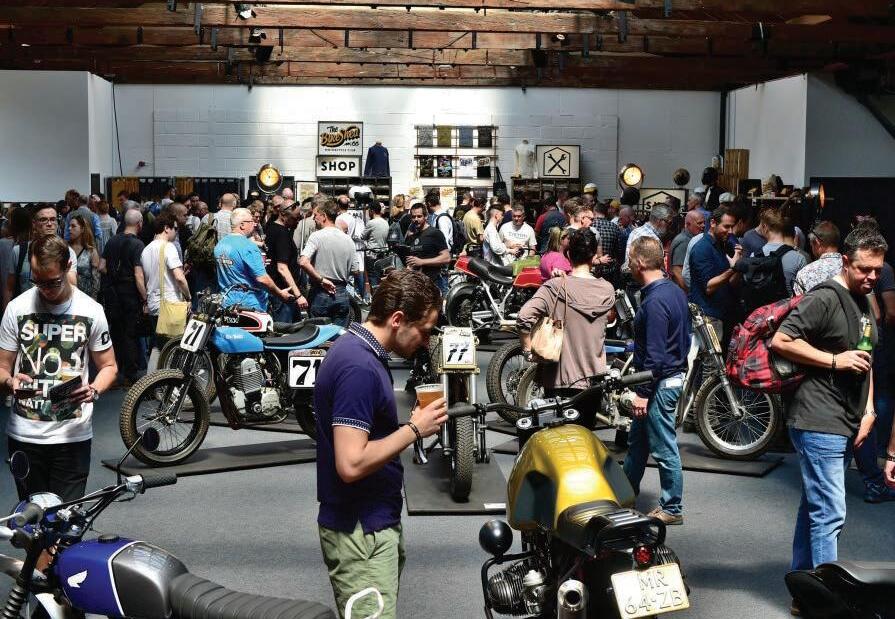

When: May 26 to 28th
Coordinates:
Tobacco Dock, London, UK
Proof that the British custom bike scene is about more than just the past, the collection of new school motorbikes on display at the annual ‘Shed show reveal a genuine creative depth and funky, international flavor. In addition to the motorcycles, there’s the usual array of tattoo artists plying their trade, two-wheeled art and artifacts, blueberry-flavored beer and live music. Bring a beard.
Cafe Racer • APRIL/MAY 2023 33
Handmade Specials Done Your Way

Triumph College Class



Al Heckman digs classic Triumph twins and sent this pic of one of his world-class handiwork. This bike is a 1967 Triumph TR6R 650 with an engine that’s been upgraded with hardened valve guides and springs, a ported and polished head, oversize pistons and lapped cylinder walls. “We installed a Boyer electronic ignition and are running a 34mm Mikuni flatslide carburetor,” Al told us. “We tried to use all original hardware where we could and there’s a new wiring harness.” The bike is repainted in original Triumph factory colors of Mist Green and Alaskan White while a set of Norman Hyde M handlebars were shortened 1 ¾” on both ends for a more aggressive riding style. All gauges are rebuilt Smiths. Al says his father, Todd, a professional aircraft mechanic, purchased the TR6 from a friend in 2013 and the restoration was carried out alongside his college studies over four long years. “We met tons of great people in the motorcycle scene who gave us advice and I tried to be a part of each process as much as possible to learn basic mechanics, and restoration techniques.,” he said.
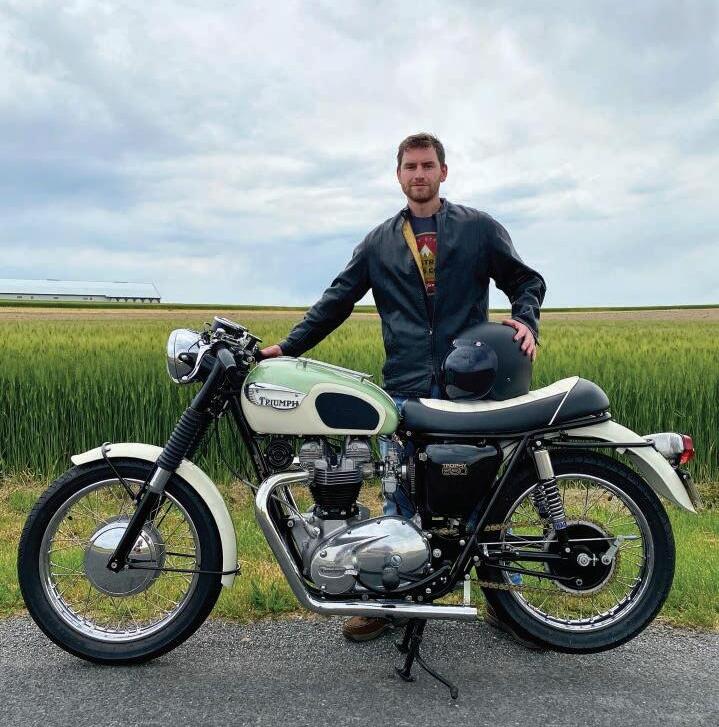
961 Commando Scrambler

Progress has been slower than January molasses at the newly-purchased Norton Motorcycles in England, but this customized 961 Commando shows what dedicated engineers could someday create from the air-cooled parallel twin. This Commando Scrambler is the result of several months hard work from Down and Out Customs, the blokes responsible for the classy BMW bobber from last issue. The stock 961 was extensively modified to be light and agile enough for a flattrack race but reliable enough for everyday street use, says Down and Out’s Carl Portlock. The rear subframe has been replaced by a smaller hoop that’s incorporating the horseshoe-shaped LED taillight and holding a narrow stainless steel fender. The airbox is now gone, replaced by open aluminum bellmouths sucking air into the fuel injection system while the high-rise exhaust system is a sheer work of art, requiring dozens of hours of pipe bending and welding to complete. An 11”
off-road tires and Kineo spoked
Compiled by The Staff
rear sprocket helps the torque curve, not top speed, while seriously knobby Hidenau
wheels combine for a dirt-or-show appearance. Look for a full feature in an upcoming issue.
34 www.caferacermag.com
Baker’s Duc
In So Cal, few Ducati enthusiasts are as dedicated as George Baker. In addition to a sprawling custom shop specializing in Italian twins, he runs a successful motorcyclethemed cafe and rider hangout. This breathtaking take on Bologna’s traditional air-cooled 900 Supersport is proof of his love of the brand as the build was spared no expense or technical detail. The carbureted two-valve engine was carefully rebuilt with new Mikuni carbs, Cone Engineering stainless steel mufflers and the airbox replaced by a set of velocity stacks. “To lend the Ducati a more traditional shape as seen on early SS models, he ditched the clunky stock fuel cell and replaced it with the more traditional-shaped tank from a 1980s Honda CBX six-cylinder. This required having the frame’s top rail cut away and a new piece welded in place, but the results speak for themselves. Other frame mods include grafting on a single-sided swingarm and five-spoke Marchesini rear wheels from a Ducati superbike, along with a custom rear subframe to hold the slim humpback cafe seat. Custom side panels in silver contrast nicely with the bright red paint, which magically makes every Ducati even faster.
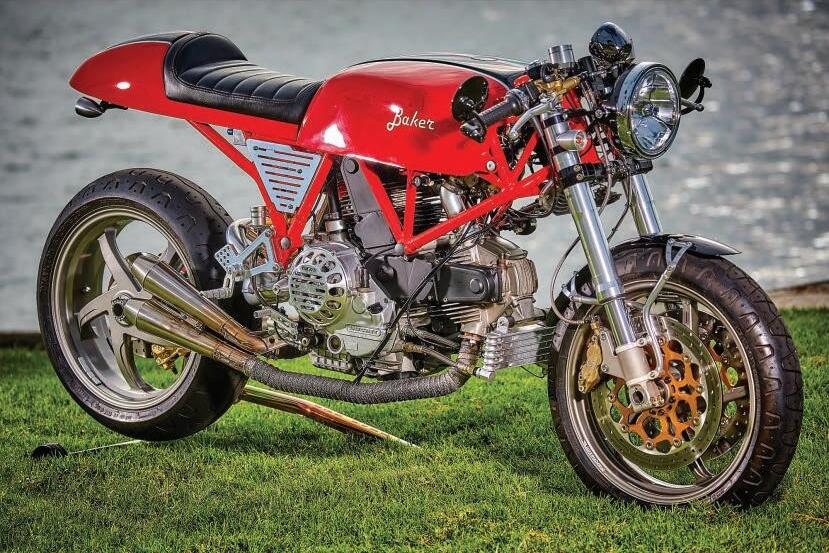
Motodoc Moto Guzzi




Davide Paradiso of Umbria, Italy’s Motodoc Classic put together this retro take on the 90-degree shaft drive cafe custom that we spotted at last summer’s Moto Guzzi 100th Birthday celebration. Built from the remains of a worn-out 1986 Guzzi 1000 SP3 sport touring bike, Motodoc saw a classic, race-inspired streetbike lurking inside. To achieve their goals, the three-man team cut the steering head and reconfigured the neck to decrease the rake angle 3.5 degrees for faster steering and rebuilt the air-cooled engine from crankcase to heads. On came a set of Foggy aluminum spoked wheels and rebuilt 1980s Brembo brake calipers. More grip comes from the Continental Road Attack tires on both 18” wheels. Tiny aluminum fenders are barely legal in safety conscious Italy, but neither are the reverse megaphone mufflers that are welded to the sleek stainless steel header pipes and boom out sound from the overbore 1100cc engine. The
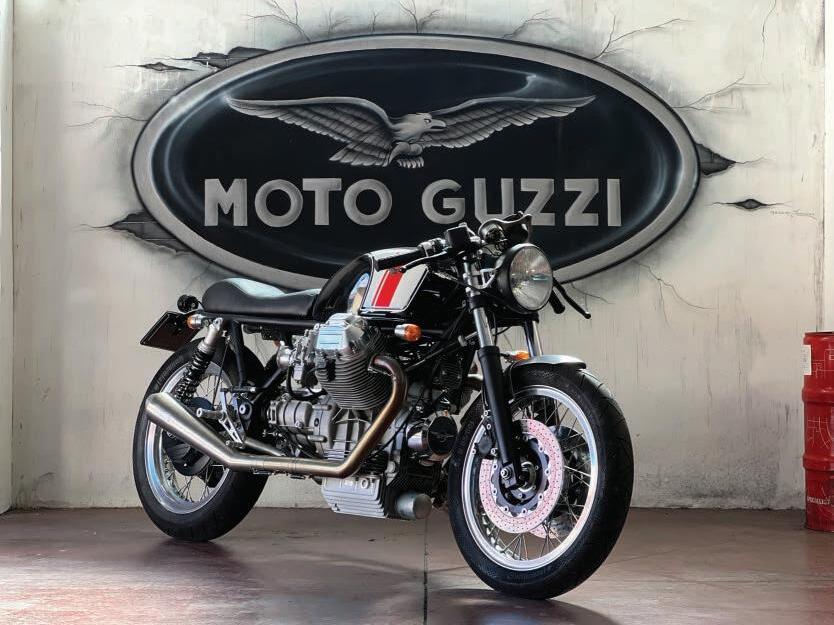
from an old

Cafe Racer • APRIL/MAY 2023 35
Guzzi revs as freely as a single thanks to lightened flywheels and ported heads. The fuel tank hails
Suzuki 500GS with knee-indents pounded in and black paint with red stripes finishing her off.

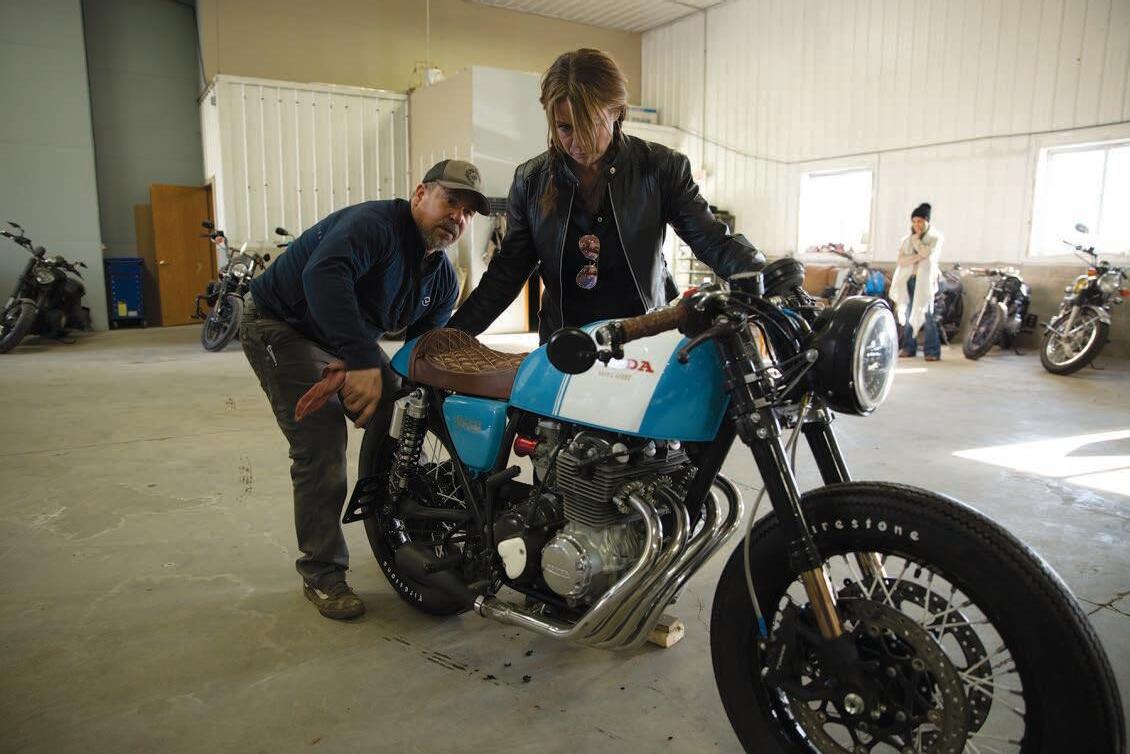
– Women’s Issue Special –Jessica Lucchesi
Never Ending
of
Cycles
this nifty
Jess and husband Ben Schattschneider customized her Kawasaki 400 cruiser
into
cafe custom
While many biking couples have trouble finding the time to ride together, Jessica Luchesi and partner Ben Schattschneider have teamed up to create a rare husband and wife custom motorcycle shop. Chicago’s Never Ending Cycles designs and builds custom cafe racers and scramblers and Jessica’s role is quite a departure from her earlier career, she admitted, but the two very different jobs have similarities “It turns out that 30 plus years in the beauty industry overlaps quite nicely in motorcycle design,” she said. “I’m also quite often the tear down department and I’ve found it quite satisfying to pull off the old stuff and get ready for the new. Needless to say, I don’t have very girly hands!”

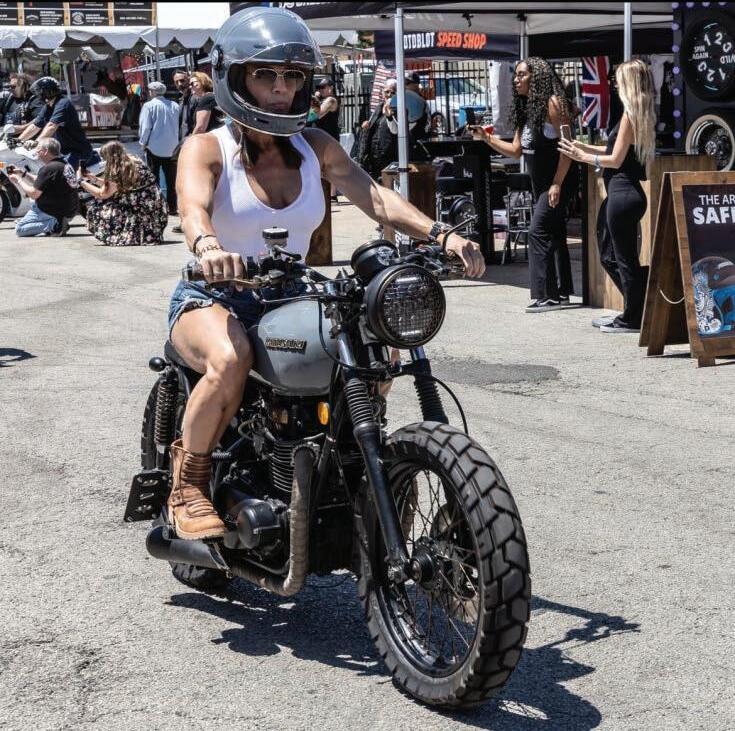
 Photos by Manny Pandya and Never Ending Cycles
Photos by Manny Pandya and Never Ending Cycles
Cafe Racer • APRIL/MAY 2023 37
Jess designed and built this 1980s Kawasaki 400 twin into a sweet, retro cafe racer displayed at last year's Motoblot festival.
Her path to a career as a bike customizer started as a little girl in the family garage. That’s where her father spent weekends tinkering with cars and motorcycles, allowing Jessica to help out with various jobs. “We were never without an old car or bike dad was tinkering on. I loved the vintage world from a very young age,” she said.
Husband Ben began building a couple of cafe racers in the garage during the first Covid shutdown as something to pass the time. Never Ending Cycles began in 2020 as a good reason to smoke cigars, drink whiskey and tinker in the garage while coping with its the world being closed due to Covid, Jessica said. Then she got involved and saw what she describes as “an incredibly talented man with a whole lot of passion,” in Ben. “I’m also a passionate person with 20 years of entrepreneurship and (with) the roots of my dad, I knew what we had could be huge.”
With the shop up and running and offering mechanical repairs, custom fabrication and refinishing of parts and accessories, Never Ending Cycles became known throughout the greater Chicago area. With a background in cosmetics, Jessica says she was immediately drawn to aspects of the shop involving colors and finishes.

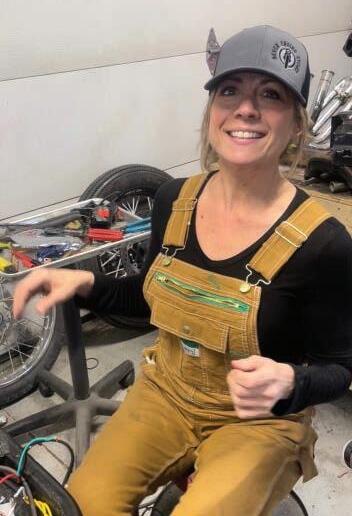
“I consult with Ben and clients quite often on color thematics. I also do much of our powdercoating,” she said. Her expertise in those fields is evident in the builds where contrasting colors and textures give Never Ending’s bikes a cool, almost factory-design look and feel. Her Kawasaki KZ400 debuted at last summer’s Motoblot festival and received much props from the crowed for its subdued and classic appearance. Ben has displayed a keen two-tone Honda CB400 Four fitted with superbike forks, and his classic BMW R65, also rolling on modern suspension and featuring a one-off subframe and trick blue paint.
A relative newcomer to motorcycling, Jessica, with Ben, built the KZ400 while she was still enrolled in motorcycle safety classes. In the coming months, she plans to add her own classic BMW Boxer twin to the stable, and both will share customizing duties.
Utilizing social media feeds, Ben soon found a community of many other lovers of vintage custom bikes and people began reaching out to him to build for them. At the end of 2020 a couple of tinker bikes grew to a little more than half dozen. By the end of 2022 the team had commissioned roughly 35 more custom bike builds, proving their
combined skills were definitely in demand.
“We began attending shows like Mama Tried in Milwaukee, The Hand Built show in Austin, MotoBlot in Chicago and Glory Daze in Pittsburgh. Then we decided to jump into a couple of local parades and hang out at Road America. Before we knew it, our local community began reaching us to repair bikes and scooters. Then our powdercoating word got out and we took on a few sets of wheels here and there,” Jessica said.
Late last year, the business had grown enough to abandon their original 450 square foot shop for a bigger, roomier location with room to grow even further. “Since then we could work 24/7…if I let Ben,” she
joked. The Never Ending team is grateful for the response they’ve received from Chicago’s large and diverse motorcycle community and thankful they’ve latched onto a career that allows them to work sideby-side while having a ton of fun at the same time.
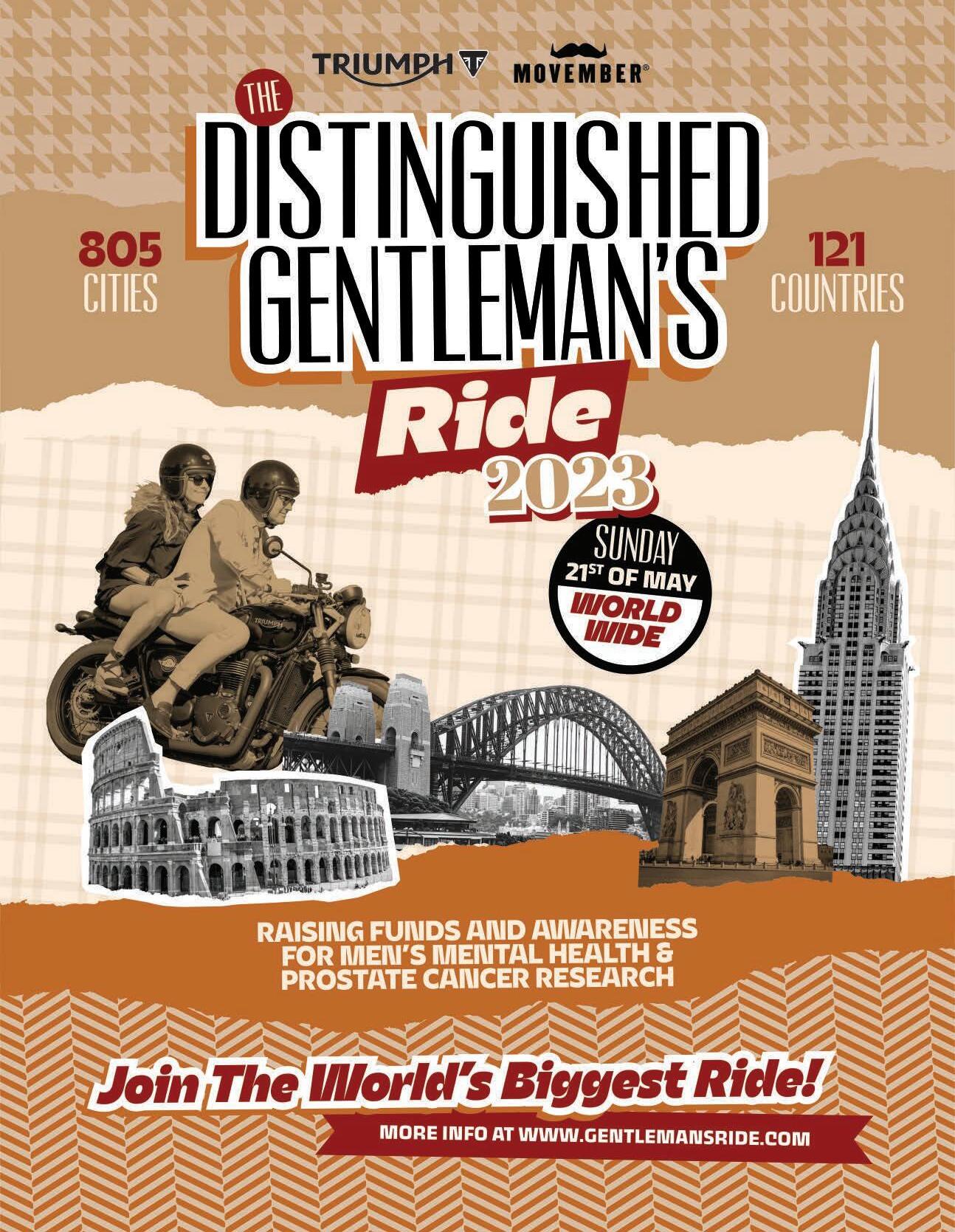
“We feel we connect people to a root… whether it’s their family or just a time we hope to preserve in our ever-changing world,” she said.
Jessica is quick to say the smiles of both her partner and their clients are the most rewarding parts of her job, while the hardest bit is finding balance between her personal and professional life. “Collectively, Ben and I have five children all launching into adulthood as well as three dogs. Our business and our dreams are growing so fast, so we have a lot to juggle. We’re sure to spend time connecting with each other and choosing our battles well. We’re so lucky that we share what we love so that much our working time is still together time,” she said.
As a woman, Jessica says she didn’t experience any considerable barriers to taking on a career in a male-dominated field – or if there were, she rode right past them. “I don’t believe in barriers, so if they are there, I don’t see them. I think what I’ve brought to the industry is that “too old” isn’t a thing and “can’t” isn’t really in my vocabulary.”
Never Ending Cycles
262-804-7133
www.NeverEndingCycles.com
38 www.caferacermag.com

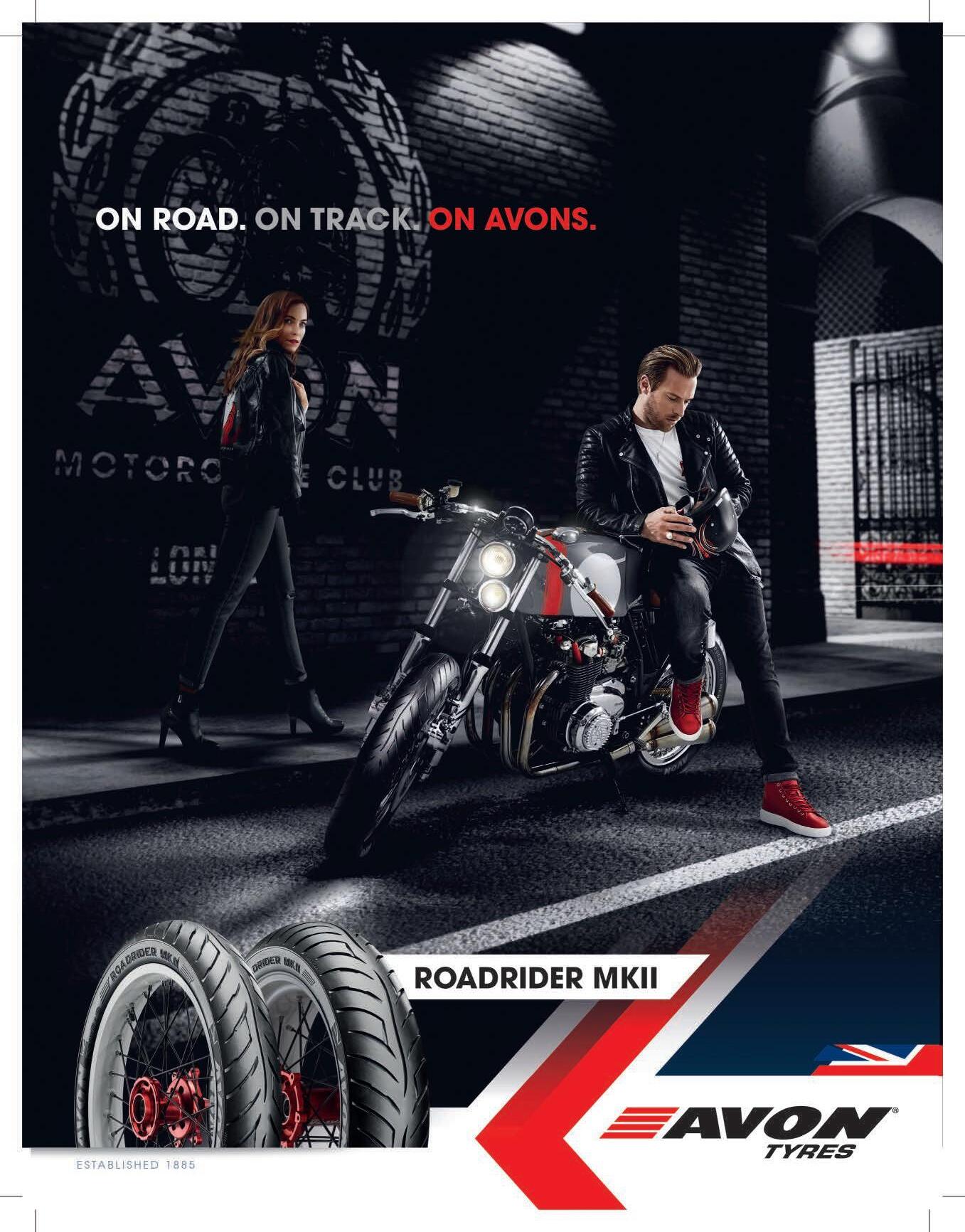



Quarter Mile
The High Speed, High Stakes
World of Professional Drag Racer Megan Hill
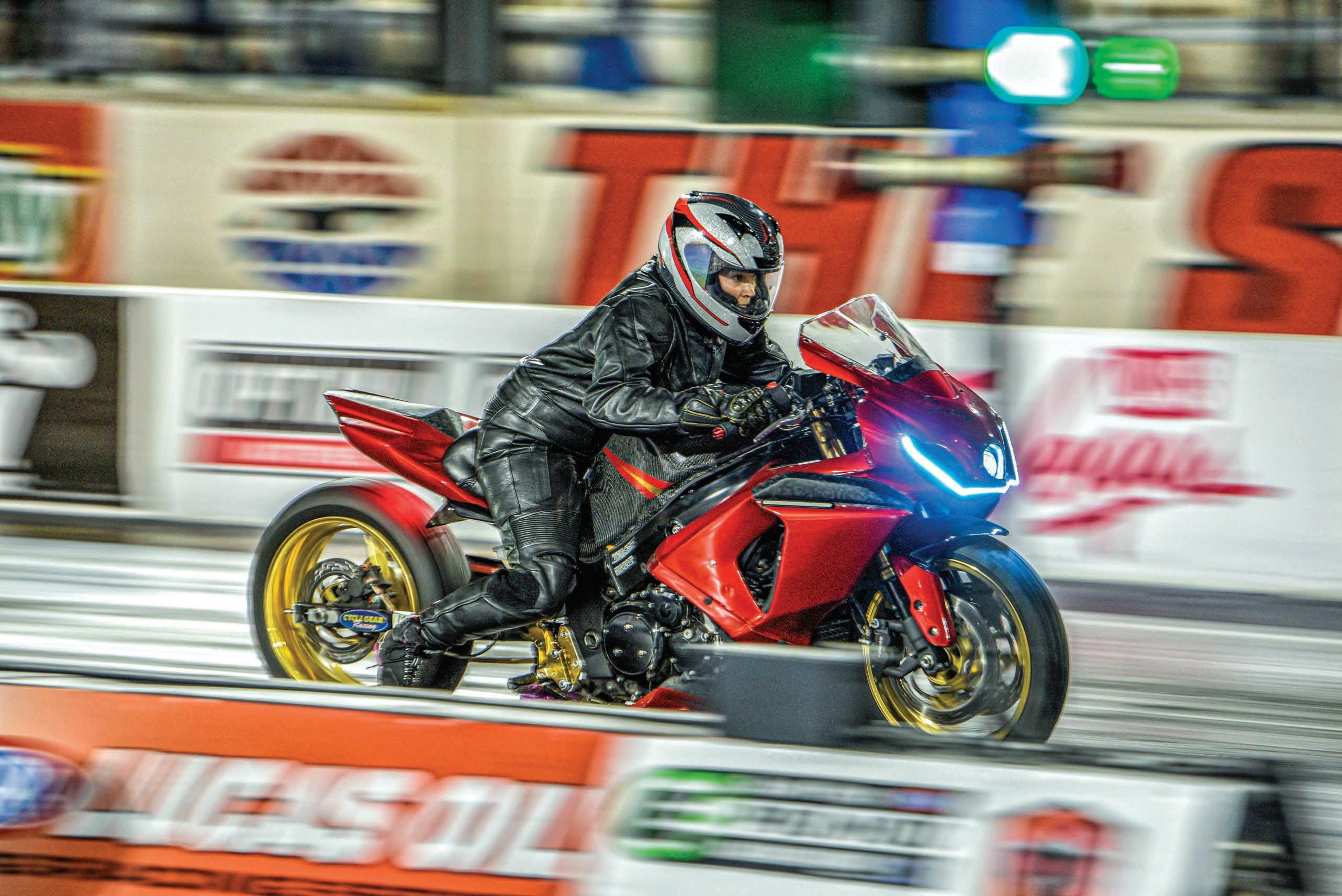
42 www.caferacermag.com
Queen

as Vegas residents Mike and Megan Hill, like many motorsports couples, share a deep affection for two wheels. After dating Megan in college, Mike decided to invest in a motorcycle and things have never quite been the same, Megan said. “Mike had a truck that got broken into and that prompted him to get a motorcycle; he wanted something he could put inside a house or garage after the theft. Eventually I became a rider, not just a passenger.”
That first two-wheeler was a serious performance bike in the form of a stretched 1993 Suzuki GSXR750 with an 1100cc engine shoehorned in it. Mike has been riding for two decades and taught Megan what he knew about biking back in 2015. She picked up additional tutoring by reading her partner’s bound collection of Rider Skills articles from “Sport Rider” magazine. Feeling confident and desiring her own slice of serious speed, her first purchase was a 2001 Honda RC51, of all things.
Predictably, those super-powerful wheels led to the frequent appearance of flashing lights in their rear-view mirrors, Megan said. “Mike was getting too many tickets racing on the street. His first time on a drag strip was on a 2006 Honda CBR1000RR.” Megan’s first foray into quarter mile competition had been in a car, but she soon felt comfortable enough on the V-twin Honda that she soon had it lined up at the Christmas tree lights.

The transition from street to strip was a logical one, Mike says.
“If you own a high-powered vehicle, it’s a waste if you can’t exploit it fully. Drag racing allows you to exploit a car or bike safely. Las Vegas is not a friendly motorcycle commuting city – there’s a lot of bike accidents – so we try to keep our motorcycling on the track,


 Story by Mike Seate Photos courtesy the Hill Family
Story by Mike Seate Photos courtesy the Hill Family
Cafe Racer • APRIL/MAY 2023 43 e
Cat-like reaction times are a requirement in the world of high-stakes drag racing. Here Megan rockets off the line on one of her Suzuki dragsters.
and encourage all of our peers to join us. But by going faster, we get faster bikes, so eventually both of us landed with fast Suzukis,” he said.
In addition to competing in motorcycle drags, Megan has ventured into roadracing in recent years, enrolling in the “Taste of the Track” roadracing school at Las Vegas Motor Speedway. She learned the intricacies of cornering aboard a Suzuki Hayabusa, which she described as “kinda heavy for the endeavor.” What the big four-cylinder ‘Busa is perfect for is reducing Megan’s elapsed times at the drag strip. Since purchasing the bike, she’s radically modified it with a turbocharger that’s propelled rider and bike to a top speed of 230 MPH in the quarter mile, crossing the finish line in just 6.3 seconds. The turbocharger has upped the Hayabusa’s already impressive power output from around 180 at the rear wheel to a crank-stressing 750 ponies.
Both Megan and Mike are involved with prepping their Suzukis for racing, a process that includes making radical changes to the bike’s running gear, fueling and chassis. “First, we added an extended swingarm, which we’ve been building since 2014,” Mike explained. “Second, we [work with] various sprockets for gearing. Third, is some sort of fuel management, whether it’s a stand-alone ECU or piggyback tuning system to help exploit the engine’s abilities.”
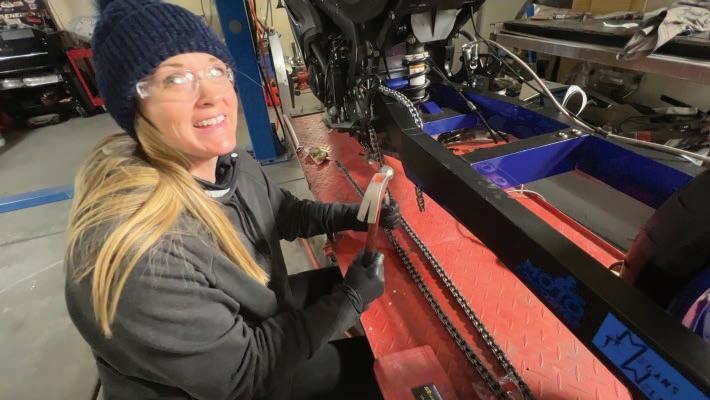
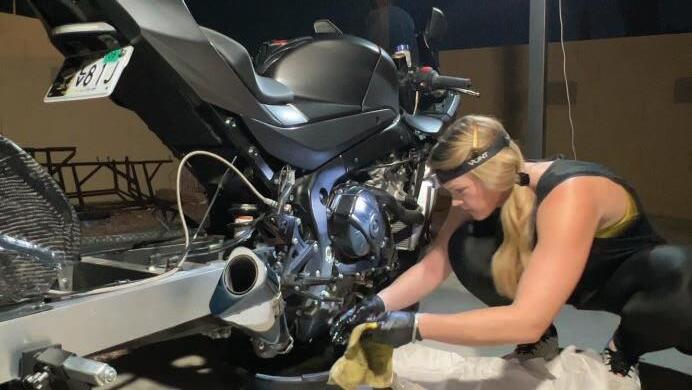
The most difficult part of the family sport is, naturally, engine dynamics, a complex, technical science with plenty of room for error. “Engine tuning; that’s the most difficult aspect of any form of racing,” Megan said. “There’s a constant push and pull of more horsepower versus engine reliability.”
With both riders racing the turbo Suzuki, Megan says the complex realm of dragbike tuning is further complicated by the differences in rider weight. “There’s two stages for this bike: the first stage is with piggyback fuel management [a Dynojet Power Commander]; the second stage is a full stand-alone with an aftermarket Maxx ECU. In the first stage, Mike at 270lbs, will race using no boost control. In the second stage, where boost numbers go up, we’ll use the Power Commander to have full management of the built engine and boost/power levels. In the first stage with piggyback fuel management, the bike should get into the mid 8 second elapsed times; after tweaking the suspension and clutch tuning, we will transition to the stand-alone fuel management which will allow the bike to get into mid-7’s.”
For her efforts, Megan has roared down the 1320 foot strip in a blistering 8.9 seconds aboard a turbocharged 1st generation Hayabusa running 6lbs of boost, making 250hp to the bike’s rear wheel. She currently has a stock Suzuki GSX-R1000 and is getting down the asphalt in nearly the same time just two years later. “She has taken over as the jockey of the family so her numbers are currently best, doing a 9 second pass with bad track prep and a bad start,” Mike says. “The bike is capable of a mid-8 second pass at least.”

The high-octane pair say drag racing can be an exhausting sport that’s potentially draining of both time and money. A steadfast DIY approach and earning cash through taking checkered flags is definitely the way forward. “If you can monetize the hobby you put yourself in the position to be paid for what you play with. Everything that’s modified on these bikes is done ourselves, from TIG welding to paint. We’re currently learning how to do our own tuning from a few full time professional racers,” she said. CR
Quarter Mile Queen

44 www.caferacermag.com
Megan hard at work on one of the family team’s extended Suzuki dragbikes.




 The family that races together stays together. Megan and Mike Hill compete in a drag race in Las Vegas.
Covered in delectable Motocomposites carbon fiber bodywork, the turbocharged Suzuki Hayabusa can zip down a drag strip in under nine seconds. Hold on tight!
The family that races together stays together. Megan and Mike Hill compete in a drag race in Las Vegas.
Covered in delectable Motocomposites carbon fiber bodywork, the turbocharged Suzuki Hayabusa can zip down a drag strip in under nine seconds. Hold on tight!
~ SPORTBIKE CHIC ~ Riding Gear Made by Women For Women
Story by Mike Seate
Photos by Mike Seate and Sportbike Chic
LaShundra Rucker has been riding highpowered sportbikes for years, but she always had a problem finding the right riding gear. “There’s always lots of jackets and jeans and things available, some of it for women, but when you try it on, most of it didn’t feel right,” said the North Carolina resident.
About six years back, Rucker decided to remedy the problem of women riders forcing their feminine bodies into riding gear that was never designed to fit them properly. She launched Sportbike Chic, a revolutionary line of riding wear and accessories aimed specifically at the growing female rider population. “I just wanted to get more options out there for women riders and all the passengers riding on the backs of bikes,” she said. To date, the original SC lineup has grown from a few jackets to cover all the essentials for either rider or passenger. The women’s riding jeans, for example, are cut to accommodate a woman’s body with stretch fabric in several areas and spandex “for extra forgiveness,” Rucker said. In addition to tough Kevlar lining to withstand abrasions from contact with the pavement, SC jeans also feature removable knee pads for added protection. “There’s an extra lip in the back at the top of the waist so when you’re leaning over to ride, you’re not exposed,” she said with a laugh.
Acknowledging that women’s bodies come in all shapes, heights and sizes, the knee pads in Sportbike Chic’s jeans can be adjusted to adhere to large, internal Velcro patches while the pockets have been designed to offer real-world carrying capacity. “These aren’t tight little pockets you can’t fit much into, but pockets that actually mean something,” Rucker emphasized.
Focusing on offering the gear through a popular internet site and some direct-to-retail marketing at some of the country’s predominantly African-American and women’s motorcycle rallies, Rucker said she’s encouraged by the number of female riders who’ve been searching for custom-fitted riding gear. “If you look at most of the leather or textile jackets out there, very few are cut to allow room for a woman’s bust or
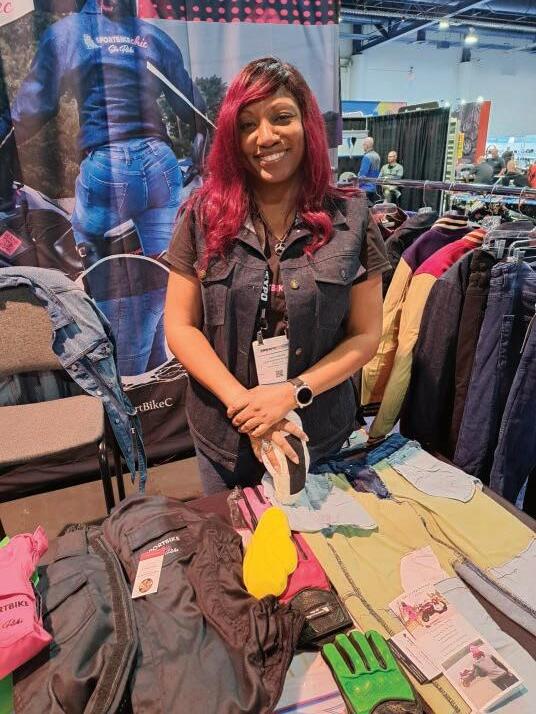
hips,” she said. Similar tailoring considerations went into the creation of the popular denim riding coat and a new line of leather gloves in a variety of high-visibility colors.

Her signature pink and black Yamaha R-1 sportbike is a serious road machine, having covered 58,000 miles in recent years.
Recent additions to the catalog include armored sweatshirts and denim vests. A topseller has been the brand’s armored varsity jacket, a stylish, retro-flavored piece combining leather and fabric reinforced by Kevlar protective panels. “Women’s riding gear doesn’t have to be all in pink but it doesn’t have to be all black leather either,” Rucker said. “Women want to be stylish and protected at the same time when they ride.”
Rucker’s most recent, patented design is a detachable tank purse, a cleverly designed alternative to traditional motorcycle lug-

gage. “It’s a one of a kind design that you won’t find anywhere else and it’s unique because it attaches directly to a steel gas tank with magnets inside two flaps and you can fold these away when off the bike and carry it as a cross-body purse that has all the compartments and storage of a purse, but is tough and durable for riding,”
A Marine Corps veteran, AMA member and longtime motorcyclist, Rucker said her company’s mission is to be the preferred clothier of women motorcycle riders, regardless of size. As the number of female riders on American roads increases – the percentage has grown from 10 in 2008 to 19% today, according to the Motorcycle Industry Council – Rucker plans to expand the
46 www.caferacermag.com
LaShundra Rucker, owner of Sportbike Chic, women’s riding gear provider.
Rucker grew tired of forcing herself into riding gear designed by and for men. Sportbike Chic padded jeans have stretch material to accommodate the female form.
The detachable magnetic tank purse combines the convenience of a tank bag with a carry-all purse.

THE GIRL BOXER Cheyenne’s Retro Ride

48 www.caferacermag.com
You don’t get to meet too many people in your life named Cheyenne. Therefore, I knew there had to be a backstory. And who doesn’t love backstories? I asked Mark Keogh, of Redditch, South of Birmingham, UK, how he came to name his daughter Cheyenne. He said, “I love Westerns. My father introduced me to Clint Eastwood movies and my grandfather always admired John Wayne,” he said.

 Story by Steve Pospolita l Photos by Simon Everett
Story by Steve Pospolita l Photos by Simon Everett
Cafe Racer • APRIL/MAY 2023 49
During his wife Karen’s pregnancy, Mark saw a western with a female character named Cheyenne. “I suggested it to Karen and it just clicked straight away,” he said.
Cheyenne is 22 years old now, and Mark says, “I always put everything I could in front of her and if she picked it up, I just encouraged her all the way. It took no convincing to start building bikes as she desperately wanted to explore the lifestyle her mum and I had enjoyed until life, and child, changed priorities.”
Cheyenne had seen magazine features and photographs of things Mark had done back in the day and genuinely wanted to discover that side of life for herself. Cheyenne started wanting a motorbike at 15, and Mark showed her many sport bikes (his favorite) but the only thing she was attracted to was a bobber 125.
“We made it my own, much to dad’s dismay at times, but I got second place in the National Kickback Show in 2019. What a start!”
Cheyenne says.
She then built a GS500 Suzuki given to her in boxes of bits from her Uncle Dan. It earned first place in its class at Kickback 2021 and was featured in a Classic and Back Street Heroes magazines.
Mark is chief mechanic, tutor, fabricator and human jack, as he puts it. Or as Cheyenne puts it, “Dad teaching or doing the heavy stuff.” But he’s also an inspirer. “He set about finding out what I wanted. He showed me some styles and the BMW looked really unusual to me,” Cheyenne says. Thus, the BMW was to be her vision of how she thought a BMW should look. Not scrambler, not really cafe racer, more classic Triumph but with a massive engine, and quirky looks, as Cheyenne puts it.
They weren’t going to build anything else for a while, but the competition is like an addiction with meeting so many nice people each time. Mark agreed to fund another bike and the 1984 BMW R80RT came their way as a tatty Scrambler, although it was a “well-maintained pile of rubbish” as Mark puts it. For example, it took him two weeks of patient work to get a frame bolt out of the engine, but that’s one of the advantages of having an engineer as a father. Moreover, a “proper engineer that does things,” as he puts it.
The build was a 10-month project. Mark’s Photoshop skills allowed him to render images of what Cheyenne wanted, so she could make decisions. Best of all, at 800cc this bike was another step toward bigger bikes. Cheyenne was seeing what some people were doing. The BMW looked great and she wanted to put her own mark on it.
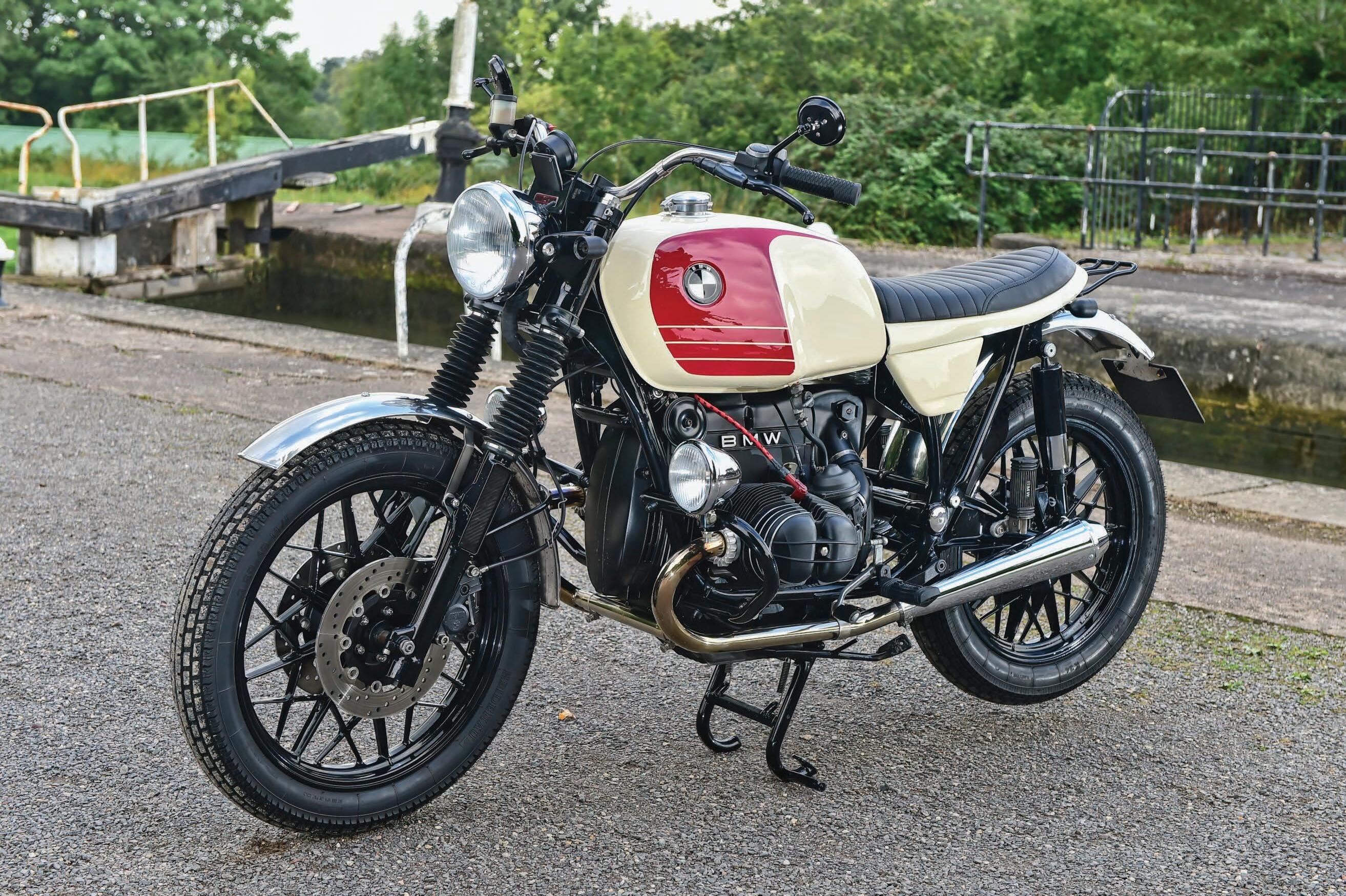
50 www.caferacermag.com

Like most custom bike projects, there was no lack of humorous instances. Cheyenne tells CRM: “Dad was trying to get the propshaft bolt out of the swingarm without taking it all apart. He was doing the bolts while I held back the rubber cover, and the very first bolt went ‘ping’ and down the tube. I mistakenly asked if he was sure, which met with a round of words no young lady should hear. Then, like a surgeon, he got out a long bolt retriever, and with me holding this endoscope he’s got for checking tank and bore conditions, he found it right down at the bottom and managed to get it back. Took about an hour to get the propshaft done but only once did he drop the bolt.” The exhaust is throaty and less boy racer sound, as Cheyenne puts it.

The electrics of the bike include a heavily modified loom to suit new parts and some layout changes. And the engine wears aftermarket tappet covers as well. The suspension on the BMW was upgraded up front with progressive springs and thicker oil. However, the rear shocks were a bit more of a challenge. They hail from a vintage British AJS because Cheyenne preferred old-fashioned covered styling. They had to work out the weight on an old bike to find a suitable pair. BMW snowflake wheels wear Heidenau K34 tires front and rear.
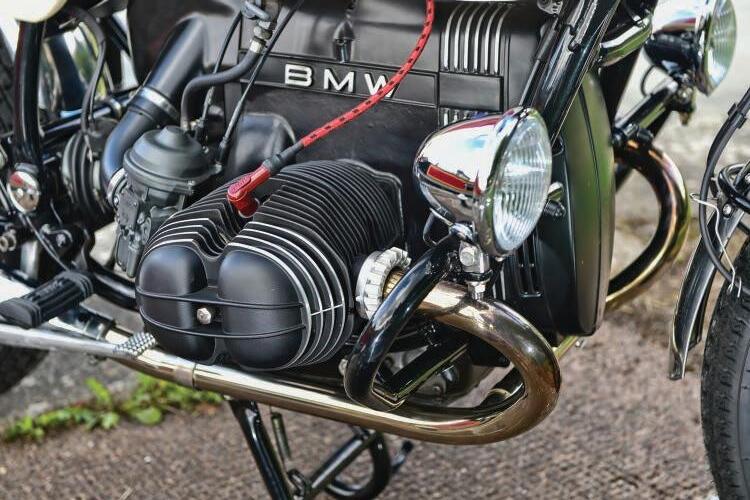

Triumph T120 (US model) handlebars rest on Kevils Speedshop top yoke and risers. While the rider rests on an aftermarket BMS Cafe racer seat cut down 5-inch modified by Mark. Vital signs are monitored with a Daytona Velona 60 speedo. Out back there’s a hand-fabricated license bracket made from a leftover mudguard that’s been cut off and modded. Combined 3-in-1 indicators, brake and taillight came from Alchemy parts, as did the billet mirrors. Fuel tank is stock with a Monza fuel cap and light ivory/purple red paint job by Wobbz. All other finishes are a mixture of gloss and satin black powder coating applied by Redditch Shotblasting Co. Ltd.
Currently, Cheyenne is a university student studying forensic psychology in her second year. She was at school when this journey of building bikes began. Cheyenne beams, “My mum and dad are my best friends, so spending time riding with them and in their company, I really enjoy. I had a thing called Work Experience in school at 15 in my last year and mum’s old boss let me spend time in the classroom of his motorcycle training school, which my mum used to be chief instructor at for many years until I came along.” Karen and Mark hadn’t ridden for some years but Cheyenne came back wanting to ride motorcycles. She had done well in her studies and Mark was happy to fund her dreams. Cheyenne says, “We’ve got such a bond through doing this.” CR
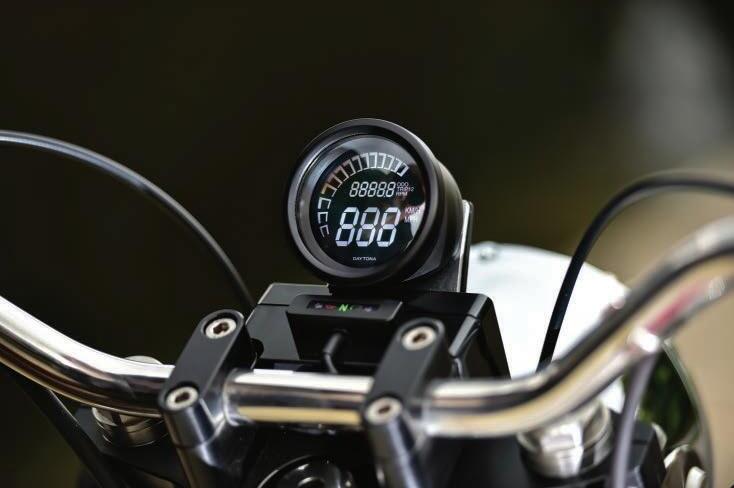
52 www.caferacermag.com
Cheyenne’s BMW may be classic, but the modern Daytona Velona digital speedometer is a nice, practical addition.
The BMW shaftie pumps out a respectable 47 horses. The chrome spotlamps are necessary in foggy old England.
A born tinkerer with bike-builder parents, Cheyenne proved that age and gender are no deterrent to creating show-winning, roadworthy motorbikes.

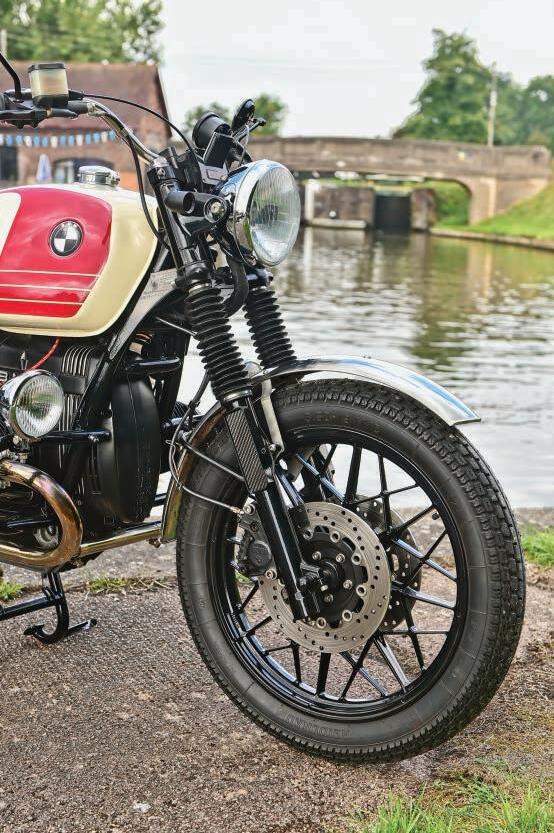

Cafe Racer • APRIL/MAY 2023 53
The mag wheels are handsome in black powdercoat while duel disc brakes and Hidenau tires help aid roadholding.
Shrouded shocks not only look period, they’re from a classic British AJS roadster. The bobbed rear fender sports combined rear indicators and taillight from Alchemy.


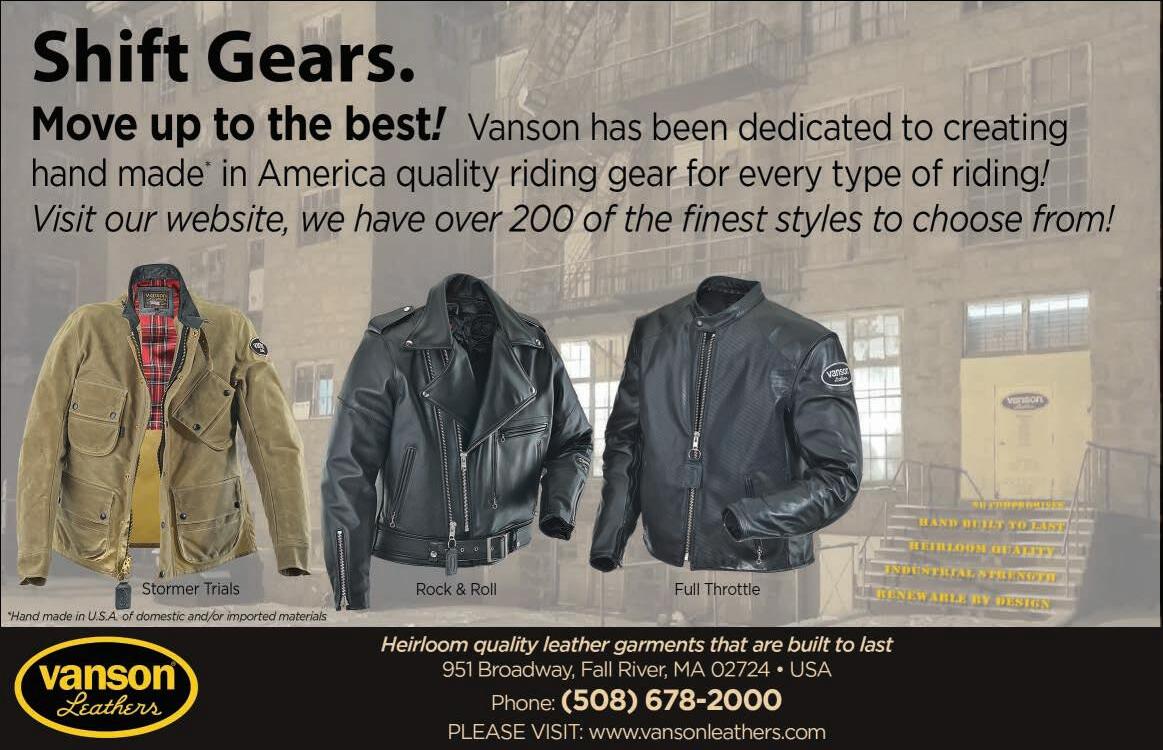
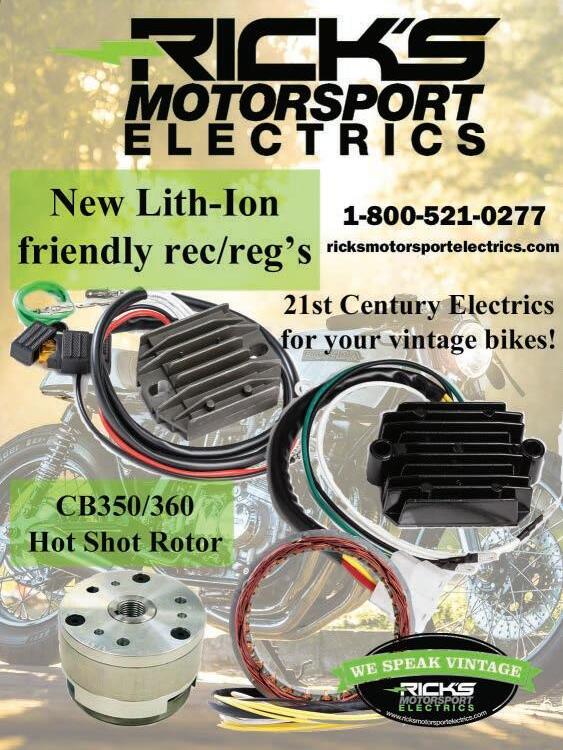
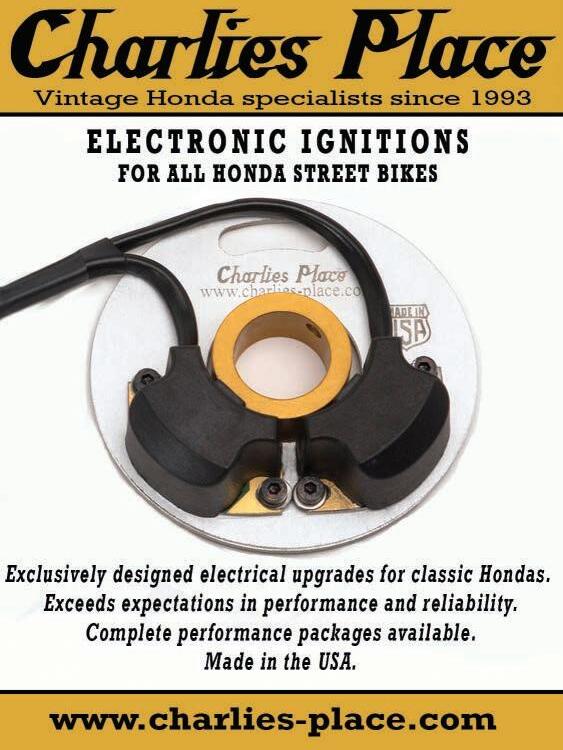
Legacy Women In Motorcycle History


 Compiled by The Staff
Compiled by The Staff
The storied history of motorcycling is mostly a chronicle of male riders, who have distinguished themselves in travel, competition and custom biking. Far less is known of the strong, fearless females who have made their own marks on two-wheeling over the past decades. Though not comprehensive by any means, our timeline highlights just a few of these biking visionaries. Ride on, sisters.
Bessie Stringfield
In 1930, a time when Black travelers could seldom rent hotel rooms or eat in restaurants, Bessie Stringfield, a dedicated motorcycle enthusiast, set off for one of many cross-country solo rides. The charismatic Stringfield continued the Van Buren sisters’ quest for government recognition, becoming the first Black female Army courier during WWII while serving as an ambassador for motorcycling with her friendly demeanor. Often forced to sleep aboard her Harley-Davidson FL Panhead when no rooms were available to her, Stringfield remained optimistic about twowheeled travel.

1916 when Adeline and Agusta Van Buren made a decision that would raise eyebrows – and expectations of what young women could achieve. The pair, descendants of President Martin Van Buren, embarked on a cross-country motorcycle adventure that summer, riding a pair of 750cc Indian PowerPlus twins from New York to San Francisco. Enduring rough unpaved roads, unpredictable weather and hostile police (they were arrested in Chicago for wearing “men’s” leathers) the pair reached their destination in early September. Though their goal of proving that women were capable of serving as US Army dispatch riders was unsuccessful, their journey has inspired countless women riders ever since.

When harassed by a redneck sheriff while riding through the Jim Crow South, she staged in impromptu stunt-riding exhibi-
During the late 1950s, German rider Anke Eve Goldman became the first woman to pen riding tests of new machines for motorcycle magazines around the world. From “Cycle World” to her native Germany’s “Motorrad,” the former schoolteacher’s byline became familiar and respected as did her work founding the Women’s International Motorcycling Foundation in Europe. Striking at over 6’ tall and dressed in a onepiece black leather racing suit, Goldman became a frequent topic of magazine features and photo essays while working as a test rider and brand ambassador for BMW. She provided the inspiration for Marianne Faithful’s character in the 1968 film “Girl on a Motorcycle” and later designed and rode the first 100 horsepower MV Agusta cafe racer custom in Germany.
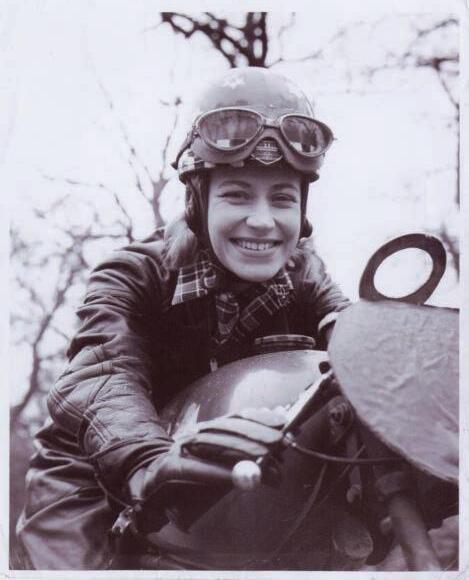
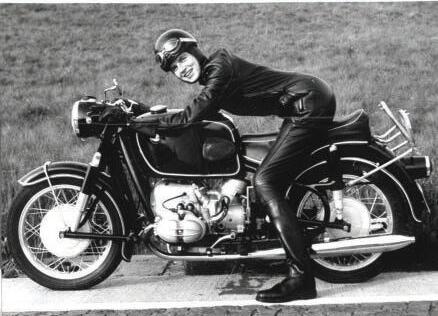
56 www.caferacermag.com
Anke Eve Goldman
1910-1925
1926-1940
1941-1965
wife of a motorcycle dealership owner, Swain was the first woman to qualify for the Isle of Man TT in 1962. After breaking a lap record in the 50cc class at Britain’s Brands hatch raceway, she entered the TT riding an Italian Itom single. Serving as her own tech crew, she built her own engines and finished 22nd of 25 entries, which emboldened Swain to race again in 1963. However, race organizers deemed the risk of having a female racer killed while competing in the TT too much to allow and her racing license application was denied. A fan favorite, an exhibit of her career is now on display at the Isle’s Manx Museum.
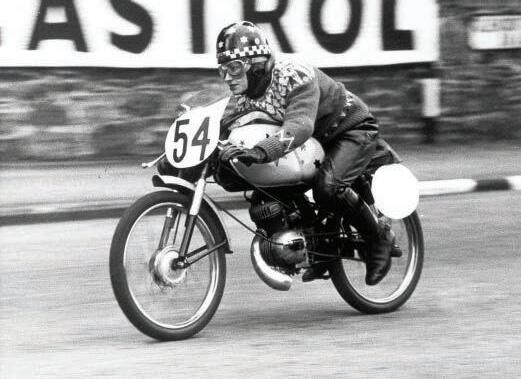


Often referred to as the female Evel Knievel, Debbie Lawler was the world’s most famous female motorcycle stunt rider and often joked that Knievel was the male Debbie Lawler. The former fashion model began competing in motocross with support of her father and racer Ben Lawler at age 14 and was soon performing jumps over as many as 76 parked cars. In 1974 she broke one of Knievel’s records by vaulting her Suzuki TM250 over 101 feet, catching the nation’s attention when the feat was broadcast on ABC’s “Wide World of Sports.” A genuine rebel, Lawler combined fierce competitiveness with irreverent spirit, water-skiing in her spare time while refusing to wear a bra (unless jumping) and smoking two packs of cigarettes per day. A generation of kids laid tire in their living rooms with her toy stunt bike which, for a time, outsold Kneivel’s.

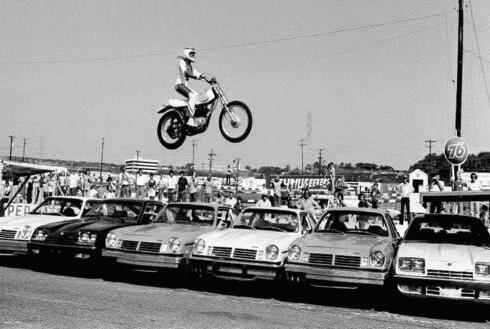
Following in the tire paths laid down by Beryl Swain and others, England’s Maria Costello set her sights on competing at motorcycle racing’s highest levels. After winning several regional club racing meets, she was drawn to the Isle of Man TT where she competed for the first time in 1998. A serious crash the next year saw her recover to attain a Guinness World Record for the fastest woman to lap the 37.75-mile course at an average speed of 114.73 MPH. In a daunting career where Maria has broken some 24 bones, she’s persevered, becoming the first women to stand on the podium during the 2005 Manx Grand Prix, obtaining the title of member of the Order of the British Empire from the Crown while being named the BBC Sports Personality of the year in 2005. Still racing in her th year, she also works as a journalist for several motorsports news outlets.

Cafe Racer • APRIL/MAY 2023 57
Debbie Lawler
Maria Costello
1966-1980 1996-2005
The co-founder of top-fuel motorcycle drag racing team Alp Racing, since 2009, Gaskin has also served as crew chief for husband Alp Sungurtekin’s annual record-breaking runs at Bonneville Speed Week in Utah. When she’s not engineering vintage air-cooled Triumphs to achieve speeds in excess of 170MPH, Gaskin, who holds several master’s degrees in several fields including psychology and cultural anthropology, works as a professional fashion model and part-time motorcycle drag racer and speed tester. Inspirational doesn’t even begin to cover it.
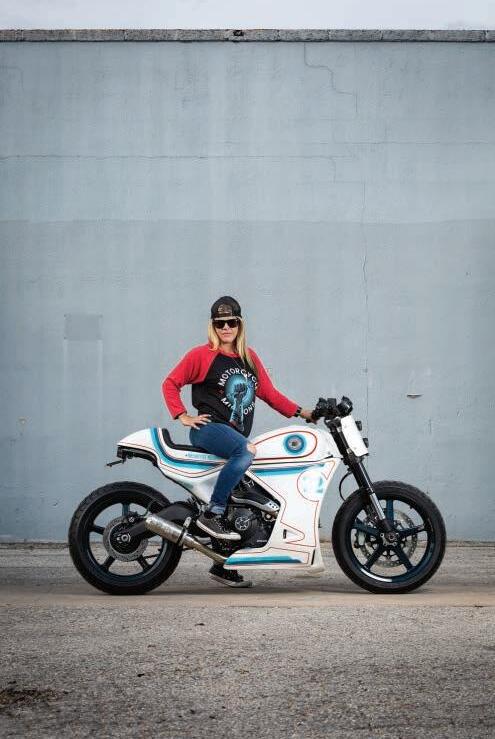
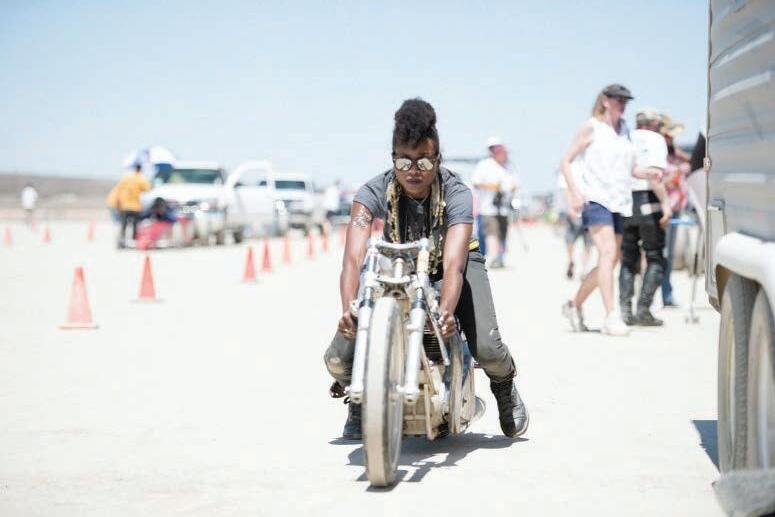

Throwing off Indian society’s strict conventions concerning women’s roles, Esha Gupta has proven adventure riding knows no boundaries. After meeting a group of motorcyclists during a backpacking vacation in 2012, she soon abandoned her corporate career and began riding cross-country full time. Her first trek was a formidable one – taking on the Indian version of the grueling Iron Butt rally, known as the Golden Quadrilateral. Piloting her Bajaj Avenger streetbike over 3,700 miles to visit the Indian subcontinent’s biggest metropolises, she drew international media attention and the admiration of millions. Her initial journey was undertaken at a dangerous time for Indian women after highprofile attacks had made much of the country nervous about female safety. “I wanted to send a message that was contrary to everyone’s belief, that India is definitely a safe country for women,” she said.
veteran’s affairs outreach work since founding Motorcycle Missions in 2017. The former nurse who graced the cover of issue #63 aboard her self-built Ducati Scrambler cafe racer, first explored customizing motorcycles as a form of therapy after an abusive marriage. Today Hess has won trophies at some of the country’s top custom bike shows and helps US service vets tackle PTSD through Motorcycle Missions where group bike builds provides camaraderie and stability to dozens of members nationwide.
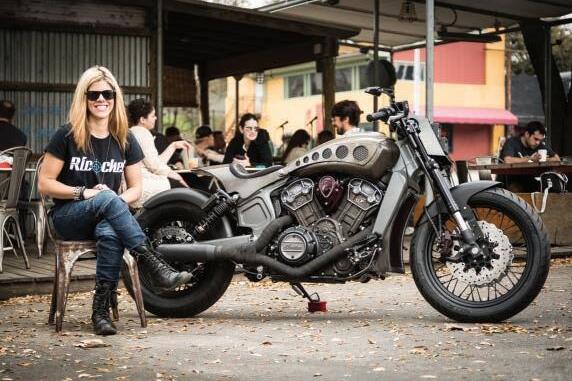
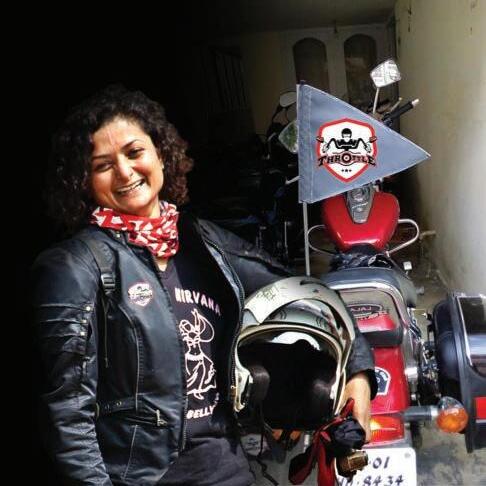
58 www.caferacermag.com
Jalika Gaskin
Esha Gupta
2006-2010 2011-2015 2016-2020
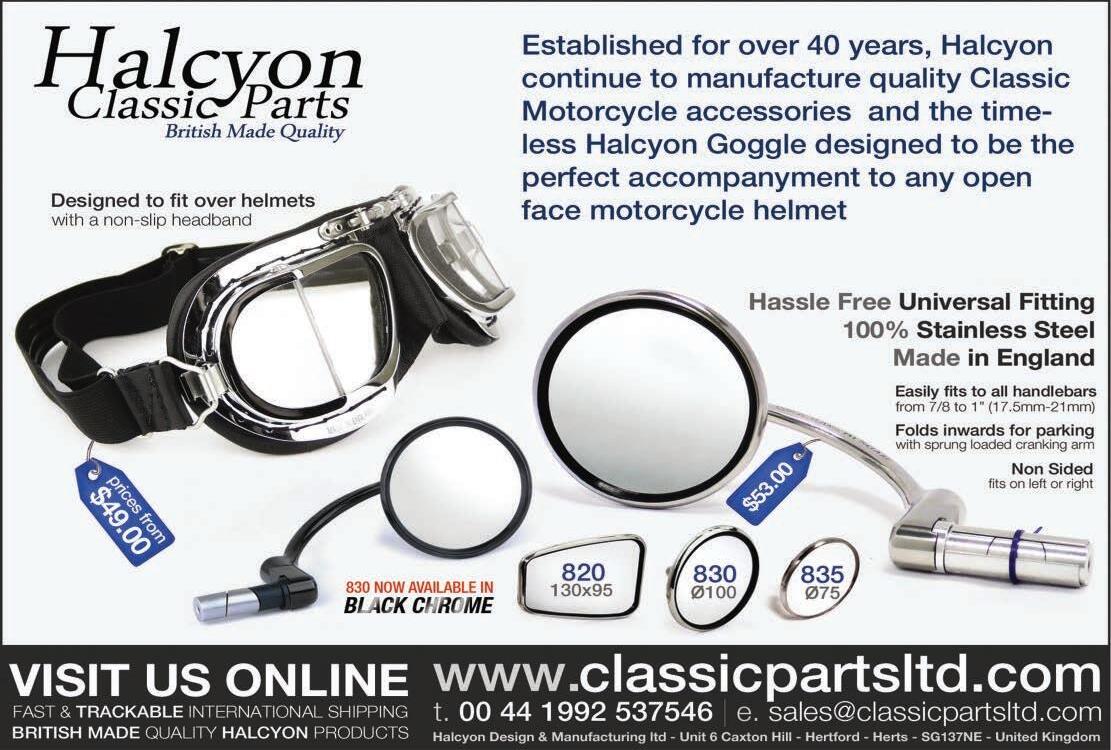
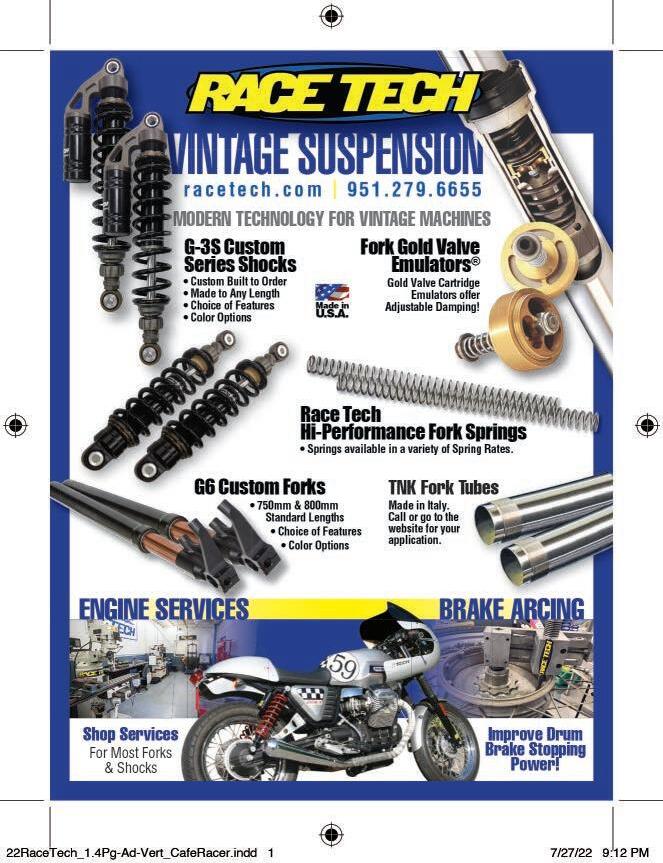


Like most classic bike enthusiasts, Jeff Hanes has unused parts lying about. Back in 2018, he picked up a frame and engine from a pair of dismantled BSA twins, with no real plans for their immediate future. “Before my tenure, my friend Mark Oldham and his brother Ron collectively owned the frame since about 1998 and motor since 2009. When I picked it up, the bike was mocked up, with the motor just sitting in the frame, a non-installed Moto Guzzi front end, old mismatched wheels and a bastard tank. Nothing was going to fit or work with the frame, so it was taken down to motor and frame only,” the owner recalled.

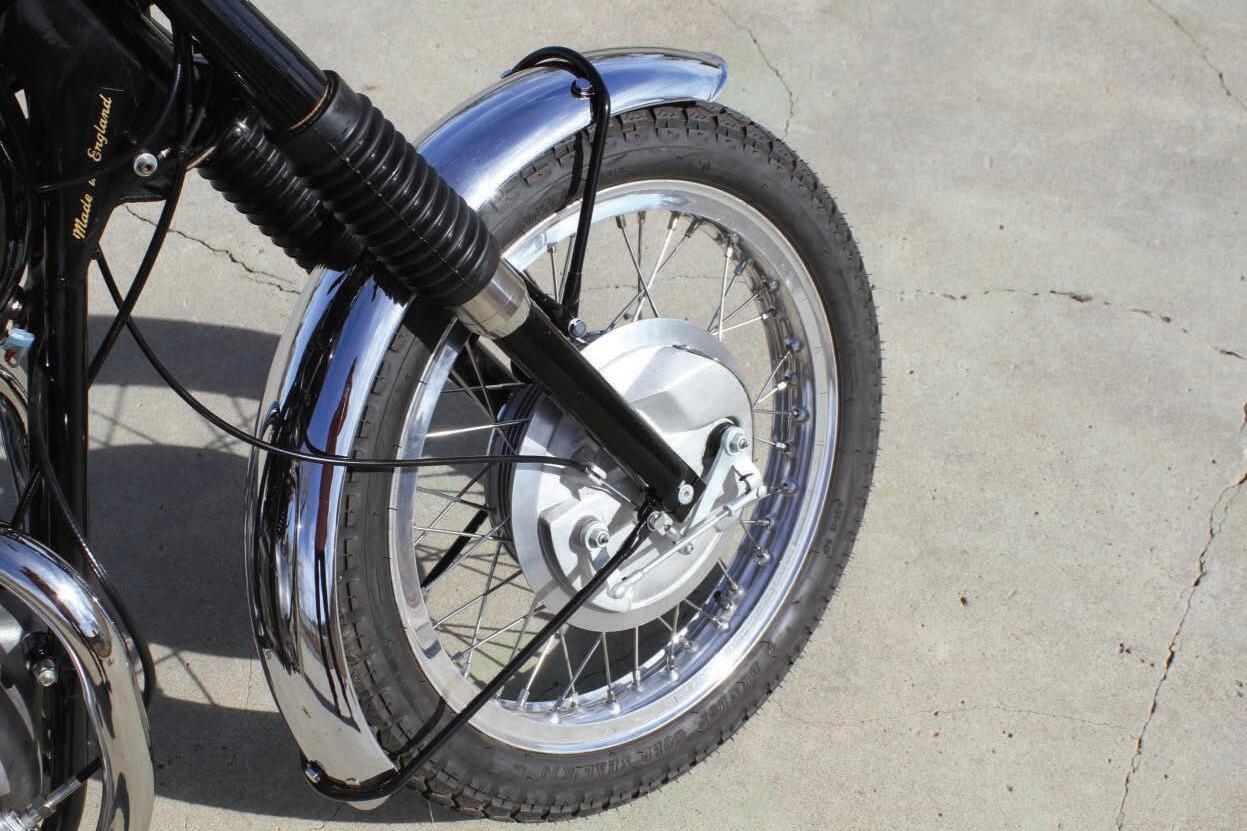




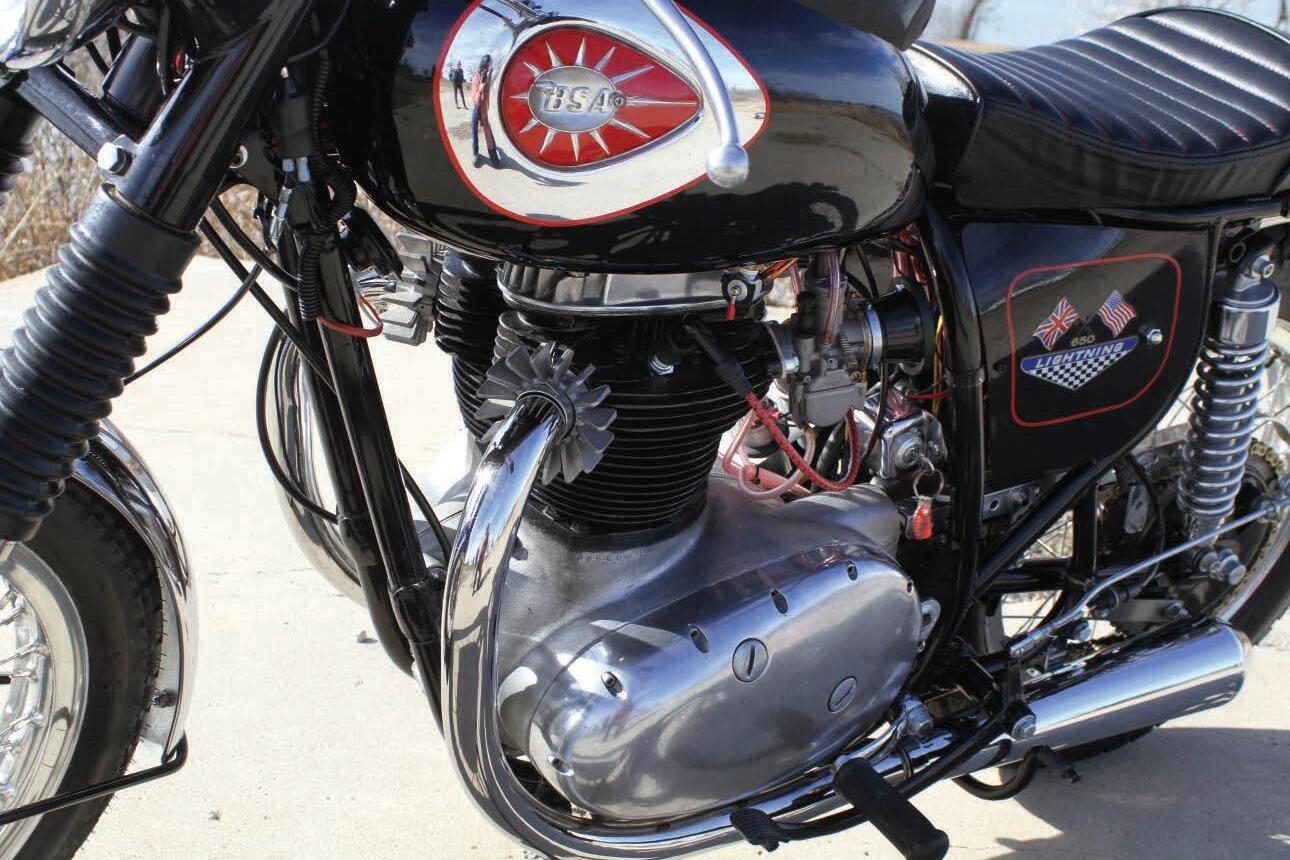 Triumph’s late 1960s twin leading shoe front brake is more period-perfect than the disc set-up that Jeff replaced.
Derisively called the Power Egg due its rounded crankcases, the unit-construction BSA twins are quicker and more reliable than early versions. Note odd ignition coil location.
Triumph’s late 1960s twin leading shoe front brake is more period-perfect than the disc set-up that Jeff replaced.
Derisively called the Power Egg due its rounded crankcases, the unit-construction BSA twins are quicker and more reliable than early versions. Note odd ignition coil location.
Jeff admitted picking up the basket case ride on a whim, being generally unfamiliar with old British twins and the BSA brand in particular. However, he was convinced to perform some online market work for his buddy’s car sales business in return for the pile of parts, which sounded like a great


“Before the build I had very little knowledge regarding British bikes,” he said. “I have always been intrigued with European cars and bikes and I’ve owned old BMW airheads and K bikes in the past. One of my favorites was a 1982 R100 I rescued from a friend’s estate in 2017.”
Like many Yanks, it was the mystique of the British motorcycle industry along with the history and the culture surrounding it that attracted Jeff to the BSA.


The problem Jeff faced concerned what direction to go with the pile of non-matching bits. “When I first got the bike I was all over the place with what style to build. Would it be a bobber, tracker, brat, or cafe?” he wondered aloud. Due to the disparate collection of parts he’d amassed, a full-on restoration wasn’t in the cards. “Original was out of the question, as there was not one original piece with the bike, quite literally a 1963 frame and
 Shocks hail from a late-model Triumph T100 Bonneville while shouldered wheel rims are classic Borranis.
Fuel cell is from a 1967 BSA Lightning. Teardrop-shaped chrome insert was kept intact.
Shocks hail from a late-model Triumph T100 Bonneville while shouldered wheel rims are classic Borranis.
Fuel cell is from a 1967 BSA Lightning. Teardrop-shaped chrome insert was kept intact.
1966 motor. After much debate, I decided to go for a hot rod custom. So basically it turned out to be a special blend,” Jeff said.
Lucky for Jeff, BSA’s A50 chassis – also known as the 500cc Royal Star – and the A65 – or 650cc Lightning – motor were fairly adaptable pieces of kit. The Birmingham-based manufacturer may have adorned their broad lineup of twins with different letter and number designations and an intriguing roster of names, but the company’s roadbikes share a similar platform and basic mechanical DNA. The unit construction twins were introduced in 1962
and their unusual crankcase shape, dubbed the Power Egg by detractors, was shared throughout the lineup.
Jeff’s Lightning engine would prove an easy mate to the Lightning chassis which utilized many identical parts from swingarms to front ends and running gear components.
However, before the melding of machines could begin in earnest, Jeff still faced the considerable hurdle of locating “a British bike guru to get the build started. After contacting many local mechanics with my vision, no one was interested in tackling the
project,” he recalled. As a result, his British dream bike concept was shelved for a couple of years. Fortunately, an uncle who has been a motorcycle and car enthusiast for over 50 years told Jeff of an old friend, mechanic and drag racer by the name of Chris Weldon. It turns out Weldon had built classic British motorcycles for a collector in town. “Best of all, he actually lives only five blocks from my house!” Jeff said.
After a few meetings Weldon was convinced to take on the custom build project. Soon thereafter the twin cylinder motor was churning out its Birmingham melody.


64 www.caferacermag.com
Smiling is apparently illegal in Texas where builder Chris Weldon (left) and bike owner Jeff Hanes do their thing.
Having focused on creating an everyday re-
high-output stator, fresh wiring and a new
Jeff says Weldon was in possession of a sizable BSA parts stash which helped things along, though a few unobtainable bits had to fabricated from scratch. During the rebuild, the Beeza was fitted with a front end from a Japanese bike for its disc brake stopping capabilities, though Jeff later swapped it out for a Triumph Bonneville fork which utilizes a twin leading shoe drum unit with nearly as much stopping power.
“My performance goals were to have a practicable daily rider,” Jeff said. “Easy starts and dependability were top of the list. Of course it had to sound great, and wake up a few neighbors on those early Sunday morning
rides. Speed was not much of a concern as the bike would not be ridden on the interstate where 100MPH is standard these days.”
With no concerns about by-the-book authenticity at stake, Jeff felt free to adapt parts from other BSA models as he saw fit. That explains the four-gallon fuel tank culled from a 1967 BSA Lightning that was stripped down before being custom painted with the sprayer, careful to leave some of the original chrome teardrop side panels.
The stock seat loop was shortened 3.5” and the seat built by combining a one-off metal pan and handmade, cowhide (this is Texas, after all) upholstery. Other Brit bits include 21st century Triumph Bonneville shocks, a lowered vintage Triumph rear fender and a set of polished aluminum Borrani rims. The Triumph twin leading shoe front hub and rear conical unit were both painstakingly re-
stored originals laced with polished, stainless steel spokes. And those with a keen eye for these things will notice the Norton headlight bucket fitted with a modern LED light from Revival Cycles. And after sampling several pair of what Jeff calls “non-functioning vintage instruments,” the bike now runs reproduction gauges that work quite well.
Jeff said the completed bike “is a gas to ride. It handles really well through the twisties and I’ve clocked about 75MPH so far. I believe it could go faster but I don’t want to push the old girl too hard yet.”
The uniqueness of owning and riding a vintage BSA is a large part of the reward for a lengthy, often uncertain project, he said. “The bike harkens back to a simple way of life for me. Many younger people have never heard of or seen a BSA and motorcycle and gearheads offer a bit of a perplexed look, then a noble thumbs up.” CR


Cafe Racer • APRIL/MAY 2023 65

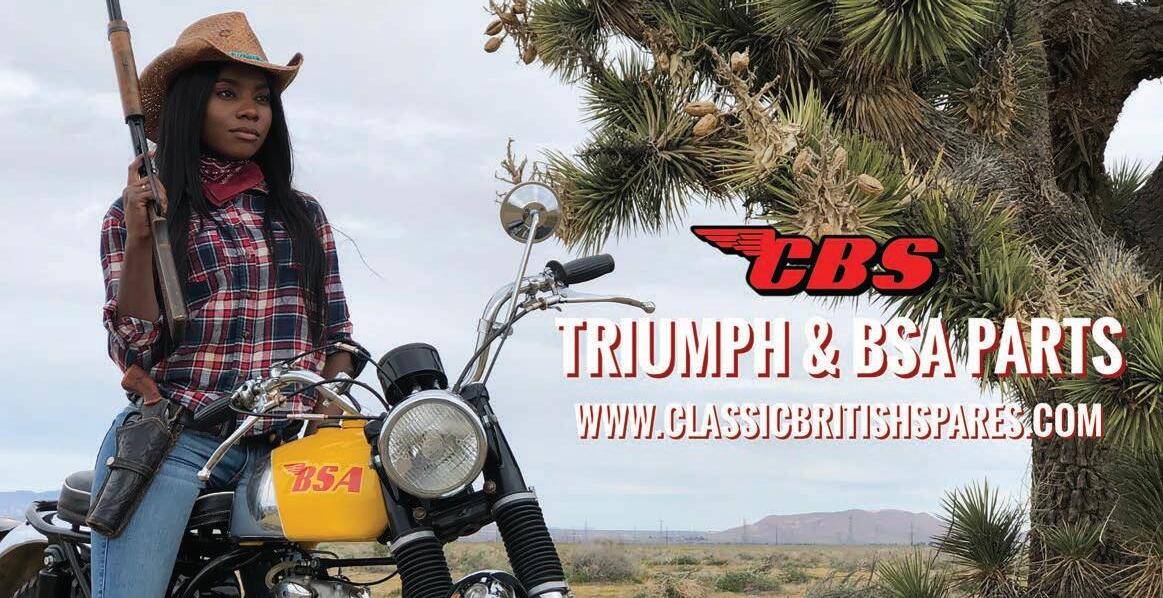
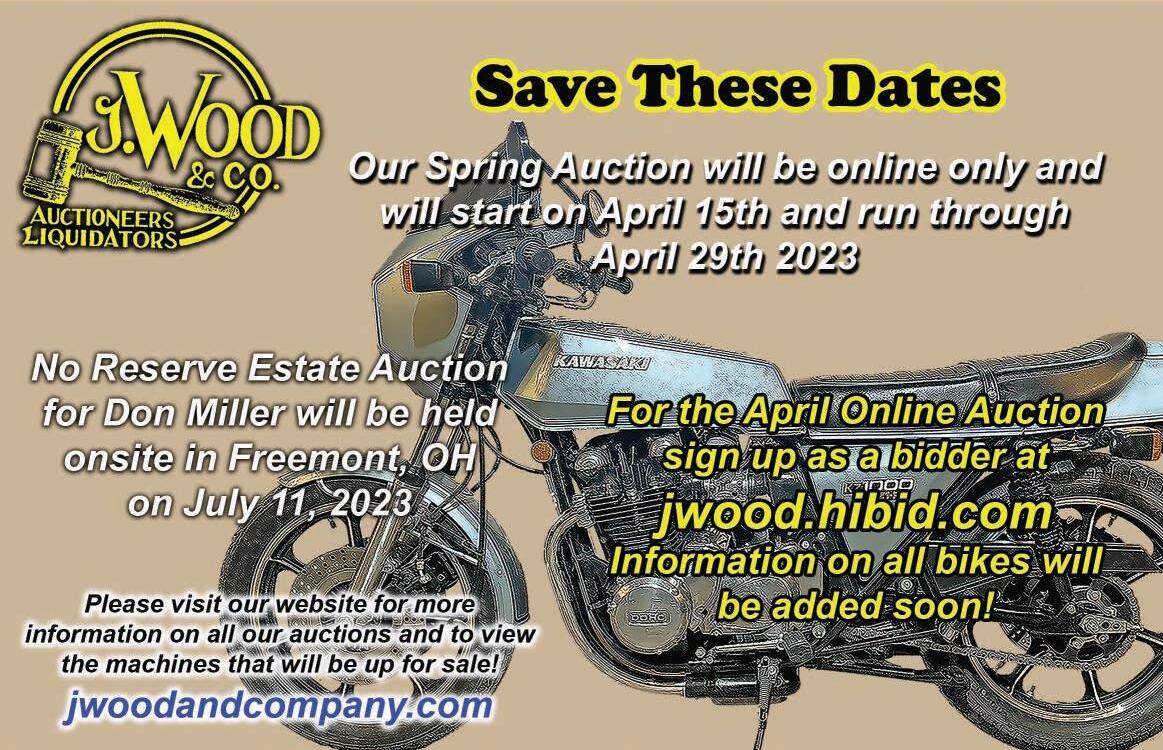
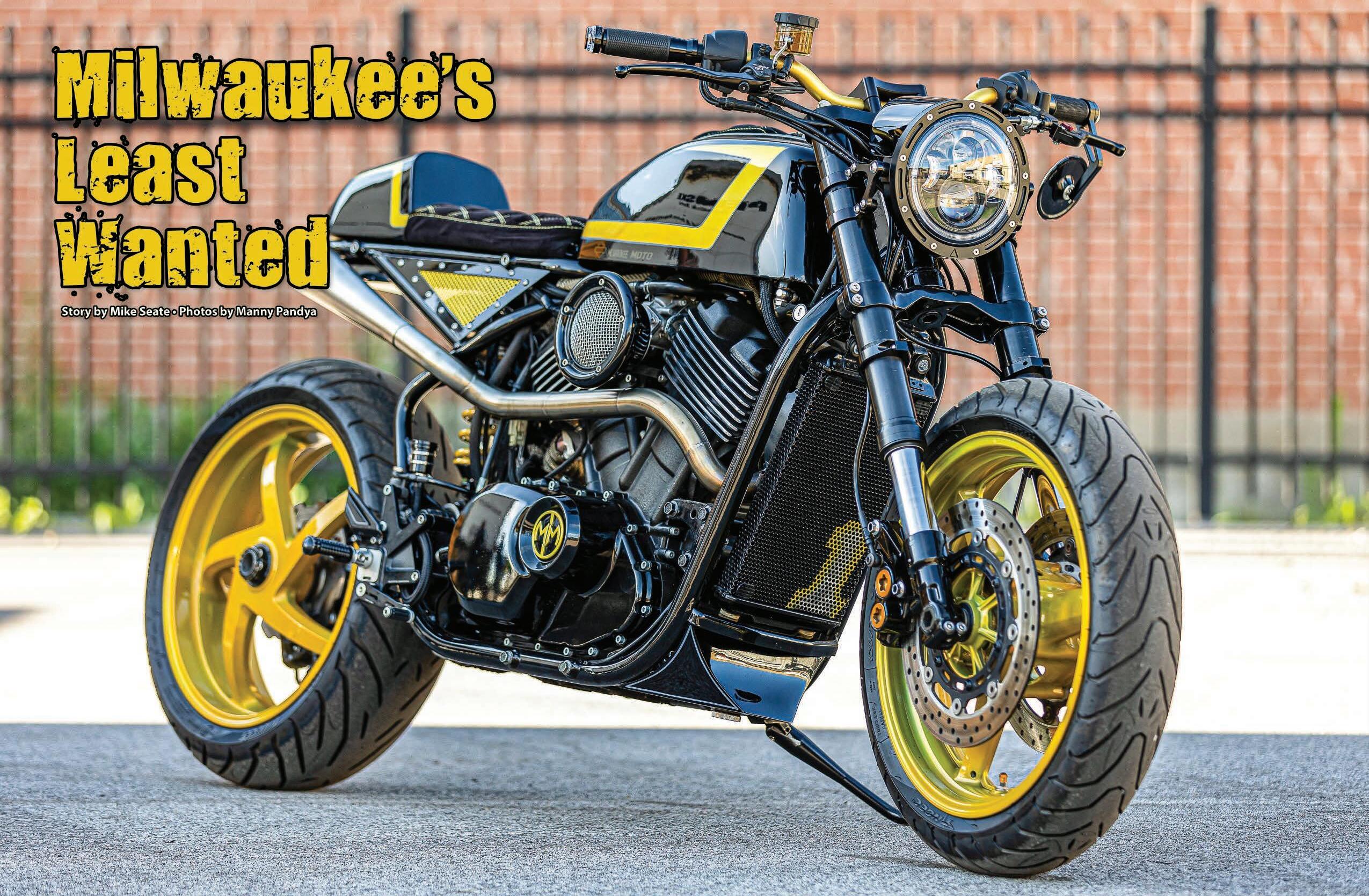
Dan Torres has unusual tastes in motorcycles. When selecting a donor bike to customize as his entry into one of the nation’s biggest custom shows, he didn’t make an obvious choice with a Triumph Bonneville or a Honda CB750. Nor did he select a motorcycle with a thick aftermarket parts catalog that would make his task much easier. Instead, he picked Harley-Davidson’s short-lived Street 750, a misfit machine if ever one existed.

“I was excited when I heard H-D was putting out a 750, but I hated the bike when it first came out. It was so ugly I couldn’t understand what they were doing, but not long after, I saw one for sale really cheap and picked it up thinking I could definitely improve it,” said Torres, owner of custom shop Milwaukee Moto. Being just a few blocks from the Harley-Davidson factory and corporate HQ, Torres sees plenty of Hogs rolling by his shop. However, the Street 750 is never among them, he says.

“That’s why I called the bike Indy because it’s made in India and I bought it in Indiana,” he said of the bike that was dropped from
Harley’s lineup after three short years.
Dan’s original vision was simple: he just wanted to make the water-cooled Harley look cooler than the factory designers had. And since there were no parts to bolt on, he had to find a means to adapt bits from other makes and models bikes to do so.

Lucky for Dan, he happened across a singlesided swingarm from an early 2000s Ducati 748 superbike. While most builders would simply opt for an easier rear end option, Dan, a machinist by trade, envisioned fitting it to the 750’s rear end. As luck would have it, the Italian wheel carrier was a simple
bolt-on job, with only a few spacers needed to make the fitment complete. Well, that and some help from modern technology. “In order to get the Ducati shock linkage to work, I had to notch and reinforce the Harley frame, Dan said. “It took a lot of trial and error and some 3D printed parts to finally get it to work. Once I chopped most of the Harley frame away, I had to make a simple subframe which led to a cool, all-aluminum seat and seat hump.”
That meant the Street 750’s dual shocks were carted off for the recycle bin, replaced by a Showa adjustable monoshock unit from the Ducati.
How’s this for confidence in a custom build? Dan not only offered to let us ride his bike, he pulled a wheelie to prove how powerful it is.
The long, low fuel tank was another prominent aspect of the original 2016 bike that irritated Dan eyes. The profile was all wrong for the neo cafe racer look he had in mind, and from an early 1970s Honda commuter bike came the answer. The CB200Tgas tank

had the right lines and width to fit the Harley’s frame, only there was no room for the fuel injector pump and hardware. Dan, not being afraid to experiment with radical modifications, realized he could fit the fueling hardware elsewhere.
lines running a good 18” from tank to seat hump. “The CB200 tank wouldn’t fit the stock Harley fuel pump or a skinny Sportster fuel pump so I had to turn to the hot rod world and fitted the bike up with an external fuel pump under that back seat hump along with braided fuel lines and a fuel regulator,” Dan said. In the end, the relocation proves seamless as the bike starts easily and has suffered no fueling issues to date.
Though the 750 came equipped with a decent set of forks and a single front brake rotor, Dan’s vision was bolder, incorporating the cutting-edge braking and damping qualities of a sportbike front end. He

Cafe Racer • APRIL/MAY 2023 71
The use of a traditional air cleaner makes the Street 750 look like traditional air-cooled V-twin. The stock airbox has actually been eliminated.
Gold stitching on the black suede seat is all part of making Milwaukee’s least popular bike a trend-setter.


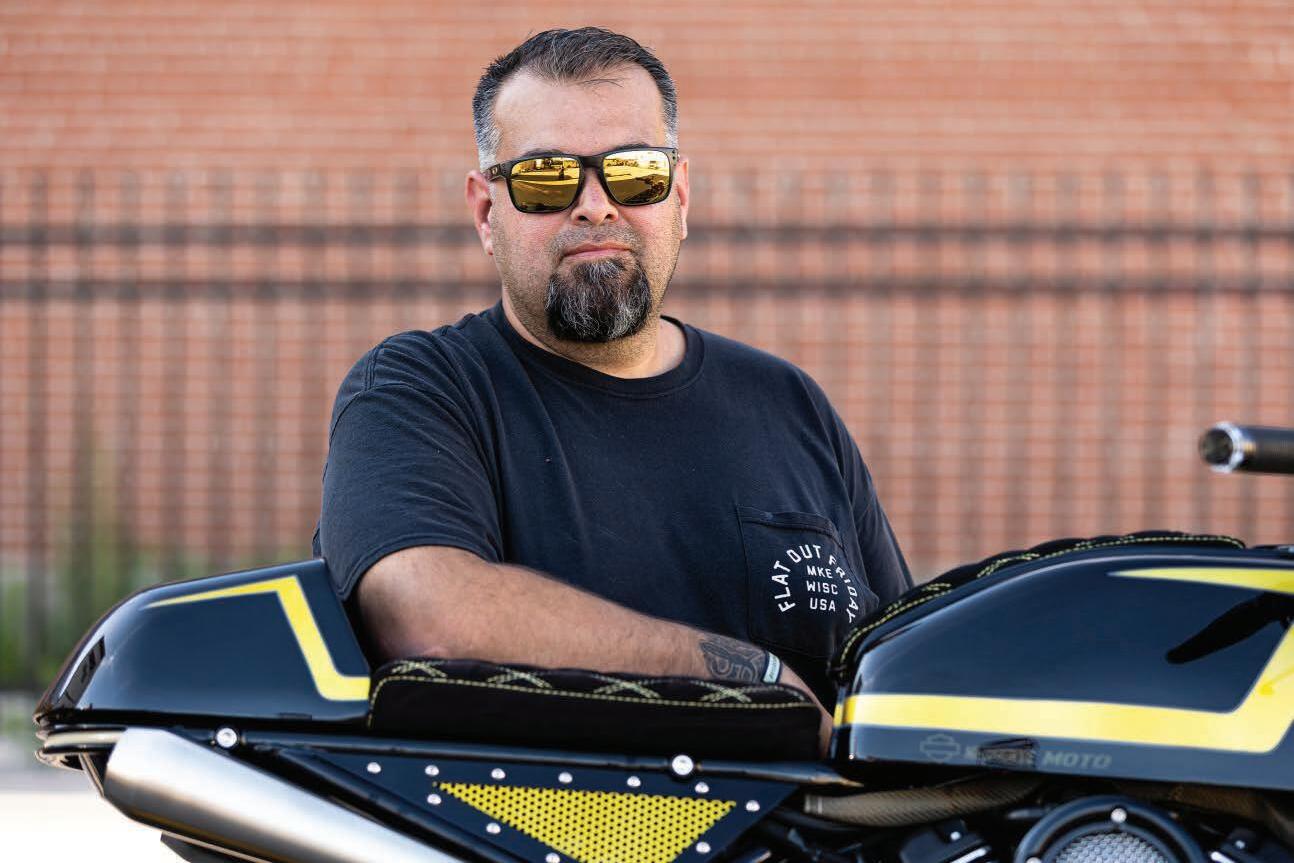 Unafraid to face the unusual, Dan Torres mounted a Ducati 748 single-sided swingarm to his Harley Street 750 for amazing results. Homemade headers sport Cone Engineering mufflers.
Unafraid to face the unusual, Dan Torres mounted a Ducati 748 single-sided swingarm to his Harley Street 750 for amazing results. Homemade headers sport Cone Engineering mufflers.
adapted a complete fork from a Yamaha YZF-R1 to fit, including the lightweight mag wheels and twin four-piston brake calipers in the mix. A set of custom machined triple clamps from Virginia’s Cognito Moto helped secure the front end to the Harley chassis, while those are Rizoma adjustable rearsets providing rear brake and shifting duties.

The hand-fabricated parts on the 750 are so plentiful, Dan neglected to mention them all. However, after staring dumbfounded at the bike for several minutes, we caught sight of most of his incredible work. That wacky dual exhaust system with the upturned Cone Engineering megaphone mufflers was created in-house on the pipe-bending jig at Milwaukee Moto, and caps off the bike’s racy tail end perfectly. The triangular side covers with gold screening not only look
boss, they’re in place to conceal the fuel pump lines and hardware. They mate nicely with the black suede seat with diamond stitching – all details that make Indy look like a factory Harley-Davidson custom, not a motorcycle the factory would rather forget.

When asked how many hours are invested in the bike, Dan laughed and said, “Don’t even ask. Probably about three years and I have little kids running around so I was doing the family thing at the same time. I don’t even think about the time, I just enjoy doing it,” he said. CR

Cafe Racer • APRIL/MAY 2023 73
Here’s a man who can see beauty where others see only homely. Maybe Dan Torres should work as a matchmaker.
Compact dash includes Motogadget digital gauge and knurled grips and Rizoma bar-end turn signals.
STYLIN’
To: Editor Mike Seate Re: Motorcycle safety

I’m not suggesting your staff is getting older, but I think I rode past your esteemed editor and his left turn signal was on for five, maybe ten miles. Just wanted to let you know.
A Reader Who’s Very Observant East Liverpool, Ohio
Dear Sirs or Madams,

I stridently object to the inclusion of modern fuel-injected multicylinder motorcycles in a magazine titled Cafe Racer. From my perspective, a true ‘Caff’ racer is an air-cooled British single or twin with alloy tank, a magneto ignition, a proper kickstarter and swept-back exhausts, period. If I wanted to spend my precious Pound notes to read about the latest traction-controlled this or 170 horsepower that, I’d subscribe to Popular Science.
Yours, Ted “1950s Forever” Sanderson
Dear Cafe Racer,


What’s the deal with all the rickety oilspewing kickstarter-only British bikes you run? I’m 22 and would never, ever, under any circumstances pay for print magazine, but I read my Dad’s copies of your magazine whenever I’m visiting the folks to borrow money to customize my bike. At any rate, stick with the road tests of the latest fuel-injected traction-controlled 170-horsepower naked retros and superbikes and leave that old rickety stuff to Classic Bike. Ride on, bruh.
A Millennial Williamsburg, Brooklyn
Me and some buddies were riding along the New Jersey Thruway recently when I noticed a flash of light every time we blew through the toll booths. Does this mean some sexy toll-taker girl digs fast bikes and the guys who ride them? If so, she can hit me up on Facebook or Instagram under sexyfastHondaguy4409@gmail.com. Otherwise, what’s up with the flashing lights?
Studley Doright



Patterson New Jersey
like so many throw pillows on canopy beds?
Just wondering, Larry Flynt, Bob Guccione and Hugh Hefner
Still Pervy in the Afterlife
Dear Cafe Racer Magazine,


By now, you may have heard about the absolute travesty that is the cancellation of the entire 2023 Irish Roadracing calendar. The bureaucrats claim the Ulster Grand Prix, Northwest 200 and other events have been axed due to escalating insurance costs, but I’m calling bullshit on that. The real reason the races – which are run at speeds exceeding 200 mph on narrow public roads fraught with all sorts of potential hazards – are canceled is because they race organizers have grown afraid that the racers might injure themselves. Nonsense, say I: at those speeds, even the slightest slides or crashes would result in instantaneous death, so on with the festivities, our group says.
Paul Bearer, President Irish Undertakers and Funeral Directors Association
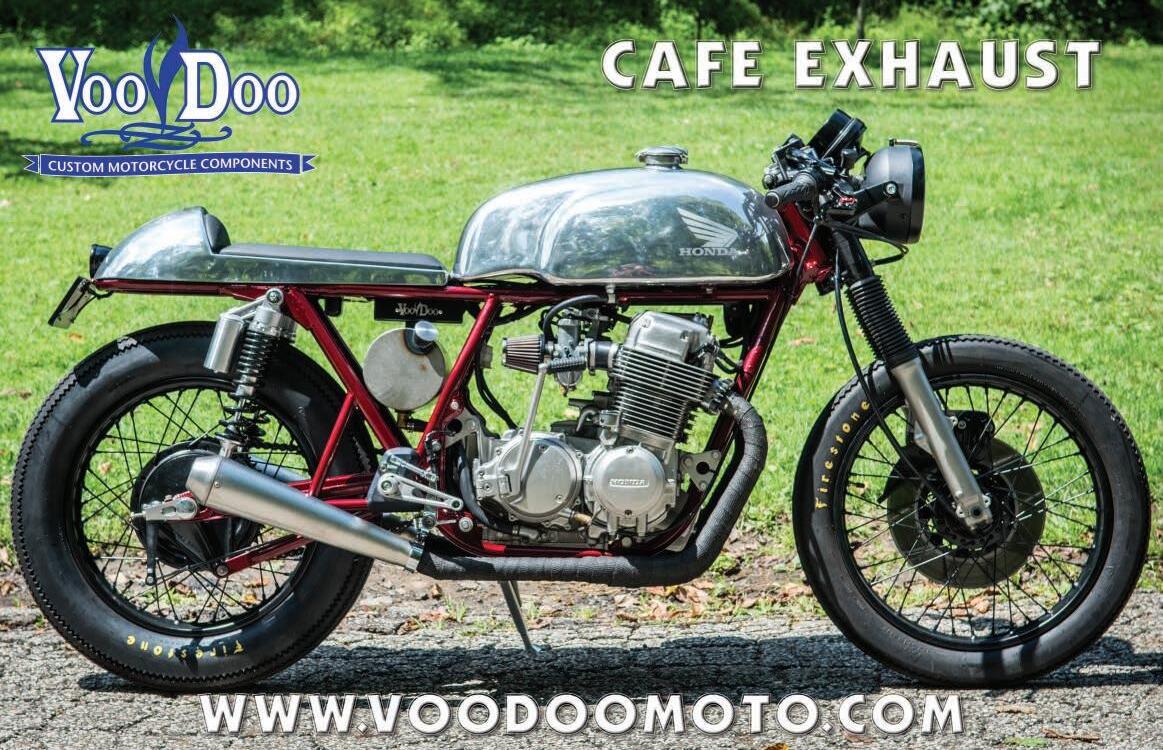

The Market AUCTION WATCH J. Wood & Co. Goes Virtual
Story by Gary Hallobeck
Photos Courtesy J. Wood & Company
Jerry Wood has been in the motorsports auction business for decades, helping estates, enthusiasts and former shop owners liquidate massive collections of motorcycles, parts and accessories. Auctioning off just a few, individually-owned machines has proven much harder he said, until now. “We have a lot of customers with smaller collections and it’s very often good stuff, but not enough to justify doing an auction on-site,” he said from the company’s New England headquarters.
Come Saturday, April 15, J. Wood & Co. is teaming up with online auction facilitators highbid.com to offer a selection of motorcycles and memorabilia owned not by one collector, but by everyday owners from across the U.S. This will be J. Wood’s first online-only motorcycle auction and bids will be taken starting at 10 am and
applied to a motorcycle in small increments until the gavel ultimately falls on the 29th. “If the top bid on a motorcycle is, say, $1,000, you can enter $5,000 and Highbid will increase your bid by small increments each time there’s another bid. This way, you’re only bidding what it takes to beat someone else,” Wood said. With each of the machines being auctioned on a no-reserve basis, some incredible bargains may surface and every item is expected to sell.
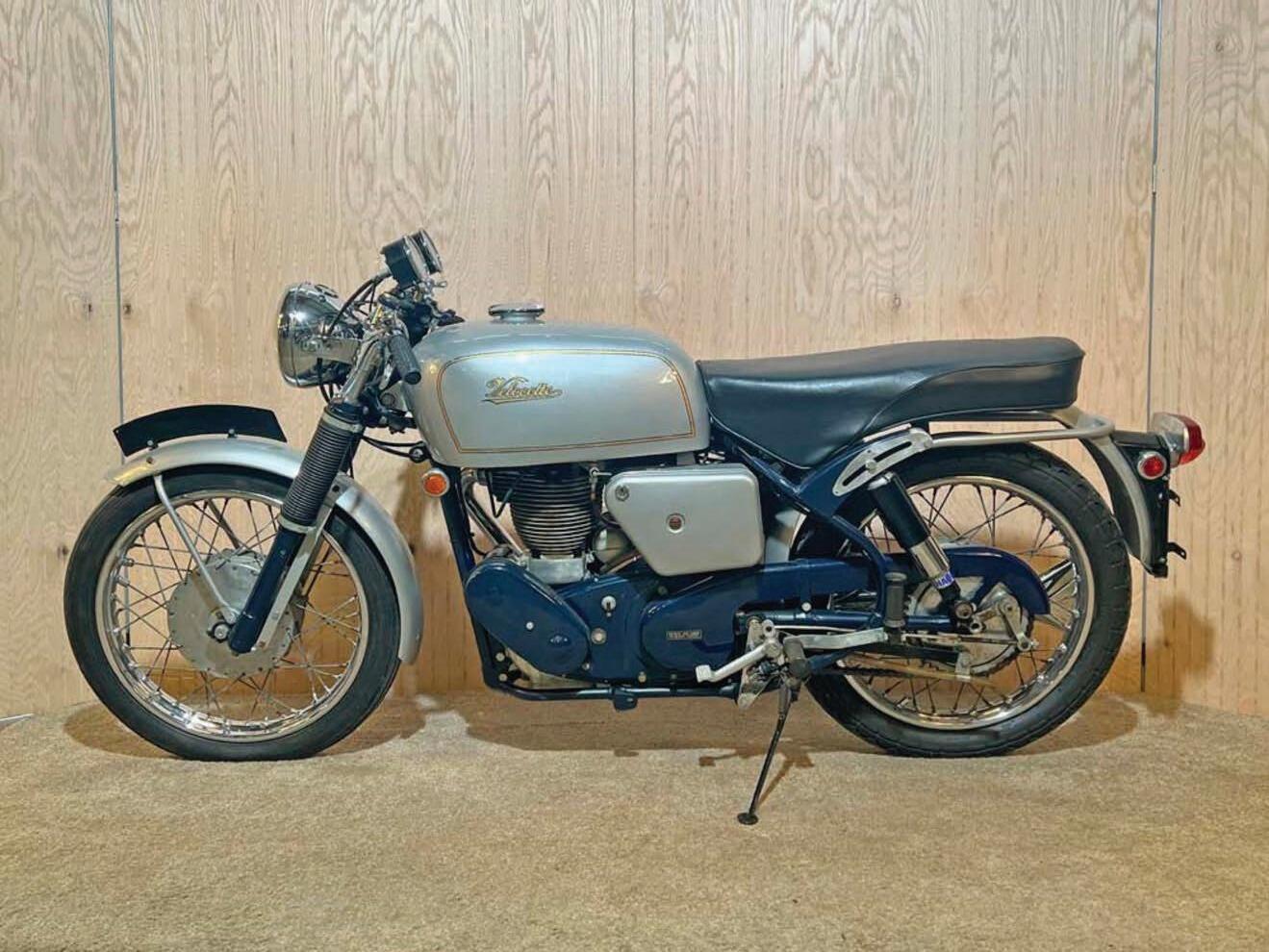

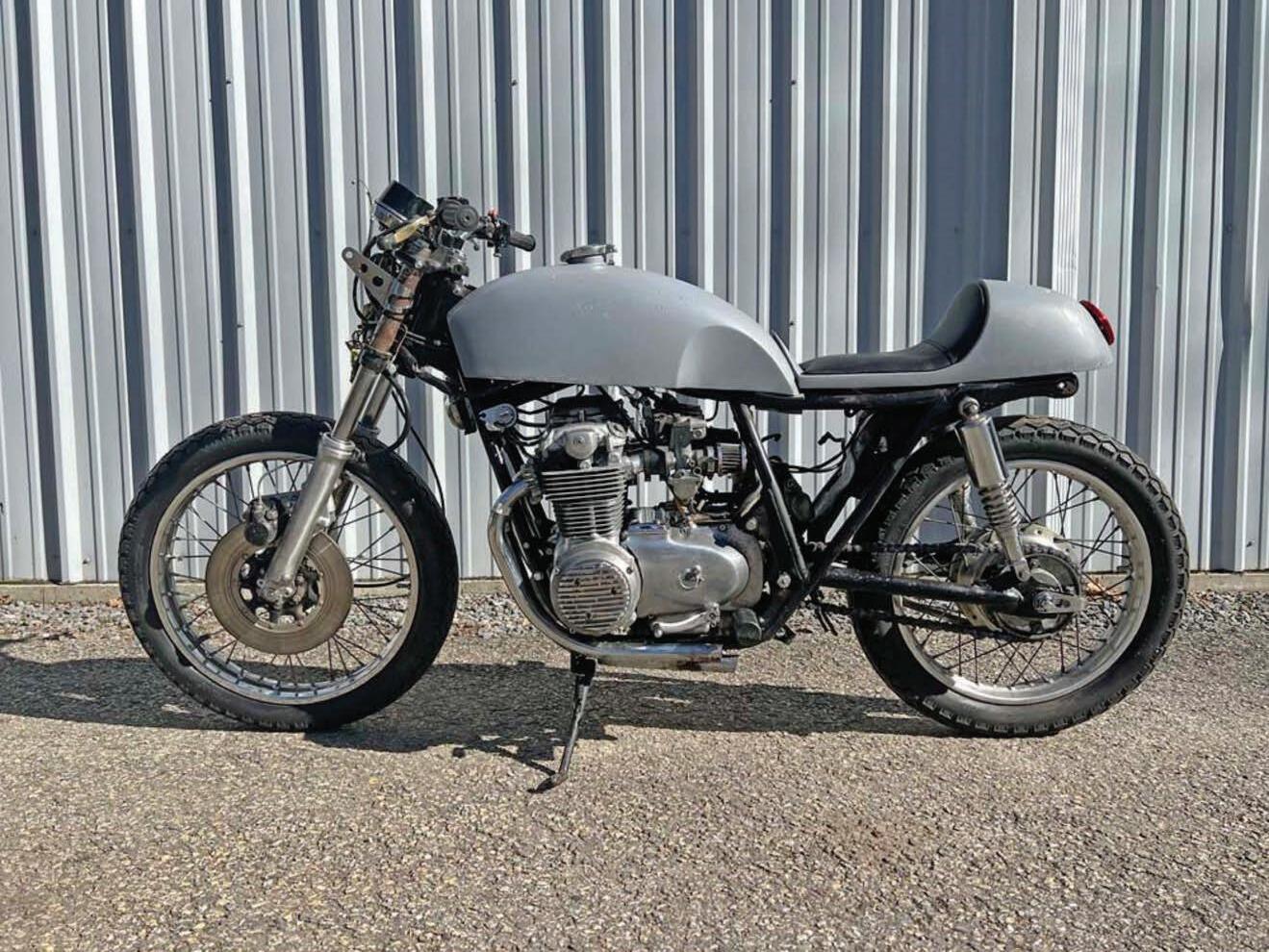
The two businesses have worked together during the past several J Wood auctions and the two-week format should prove popular with buyers, Wood said. “We have a real strong customer base and none of the bikes will be giveaways. When people have extra time to consider bidding rather than being in a live auction where you have to raise your hand all the time, there’s less pressure,” he said.
The majority of the historic collection of motorcycles is amassed at J
ing a rare 1970 Velocette Thruxton with just 13 original miles, a restored BSA Gold Star and a museum-quality 1978 Kawasaki Z1 in



Log onto www. jwoodandcompany.com


CR Tech HONDA CB750 PROJECT
FIGHTING CB REVISITED A Master Class
Story and Photos by Mike Seate
There comes a time when we have to admit we don’t know everything. At these times, outside help is invaluable especially when it’s being dished out by a genuine expert. Our 1977 Honda CB750 project had stalled bigtime thanks to a basic lack of knowledge on how to proceed with the Japanese four after installing the forks, wheels and engine. When Managing Editor, Kim Love suggested we call Bob Hesch, a legend in local Honda circles, we had to agree. During the 1970s and early ‘80s, Hesch ran a championship-winning endurance racing team (featured in issue #71) and, lucky for us, he recently returned to the area. He agreed to sort out our CB750 and we hoped his wealth of experience would help get the bike back on track.
“The front wheel is on backwards, the master cylinder is shoddy and the carb intake rubbers are way past their sell-by date,” barked Hesch, after a brief assessment of the Honda. Besides those glaring inefficiencies, he did offer faint praise for parts of the build. He agreed that testing the engine’s vi-
ability by hooking a battery lead to the starter was a bright one. “You won’t believe how many idiots build a complete motorcycle before realizing the engine is seized,” Hesch said. And he thought our decision to supplement the single-piston front caliper with updated EBC rotors and a second caliper was admirable.
“We used to add a second caliper to our Honda 750 race bikes because the brakes back then were such garbage. It made the front end heavier and slowed down the steering a little, but it really made a difference, especially when slowing down from top speed,” he said.
Hesch then set about installing our clutch cover and its cable activation mechanism, explaining how the cable would need routed in order to work properly. The basket case Honda came with an oddball set of carburetors originally fitted to a Kawasaki Z1 for some unknown reason. Well, unknown to everyone but Hesch, that is. “Lots of guys ran Kawasaki carburetors because the Z1s were a lot faster than these early Hondas. If you look at the diameter of the carbs, they really aren’t that
big, but the Kawasaki’s diameter was maybe two millimeters larger, and that could make a small difference,” he said.

As he’d first observed, the intake manifold rubbers were likely OEM and had become brittle and unusable after 46 years. Lucky for us, our friends at Oregon’s Speed Moto Co. had send a quartet of replacement intakes that Hesch fitted on in minutes. Years of quickly replacing and rebuilding carburetors in racetrack paddocks meant that our guest technician inspected each manifold clamp before lubing the new intakes and shoving the Kawasaki carbs into place.
“If you’re not running an airbox, the weight of the bank of four carbs will eventually wear on the rubbers and they’ll start to sag. Then air gets into the cylinders and people always wonder why the bikes aren’t running properly,” Hesch schooled us. “It’s best to tighten the manifold clamps every few months or rig up some kind of support to take the weight off.”

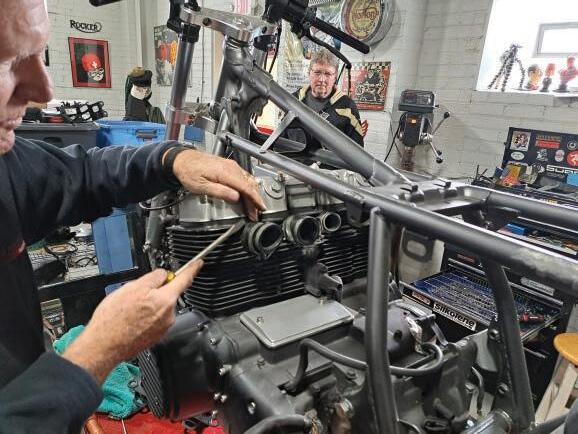
One day with Uncle Bob felt like a master class, and his quick prognosis of the wellworn brake master cylinder we’d bolted on, imagining it was a bargain, saved us loads of time. He promised to come back and assist us further; we’re eager – and grateful –for the schooling. Build on. CR
Resource: speedmotoco.com
80 www.caferacermag.com
Bob Hesch removing the Honda’s ancient carb intake rubbers. After 46 years in use, they were brittle and cracked.
New Speed Moto Co intake rubbers lubed and mounted the bank of Kawasaki Z1 carbs popped into place. CRM pal Steve Eckerson looks on in awe.
Remarkably, the intake clamps were still usable.
CR Tech
FAT FEATHERBED MODERN TRITON Liner Notes
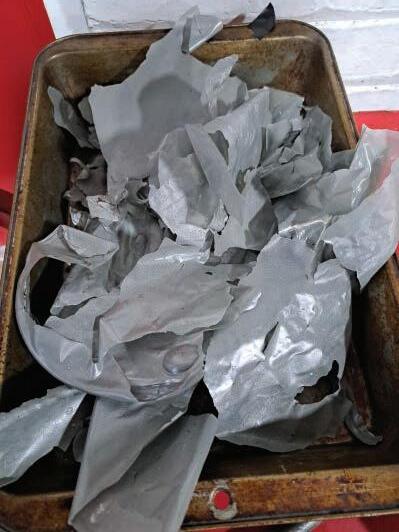 Story and Photos by Paul D. Stanstead
Story and Photos by Paul D. Stanstead
Prep work – it’s a task most mechanics loath to do, but ignoring it can bite us in the bum faster than a hungry rottweiler. Case in point, the alloy fuel tank on our Fat Featherbed modern Triton. Too little prep work and not allowing enough set-up time for the Por 15 tank liner to adhere properly to the inside surfaces has translated into a serious headache for the team.
Last issue, the failed liner was noticed by welder Kenny Munz at South Hills Cycle, who was repairing a tiny leak in the Tab II Classics Lyta sprint racing tank. Ridding the handmade tank of the errant silicone, which was threatening to find its way into carburetors and engine, was a matter of applying a dose of acetone to the tank and hoping for the best.
Cutting the bottom from the tank, scraping away the Por 15’s remains and hoping to rewelding it well enough to hold fuel is unlikely, so we picked up a gallon of ace-

tone at the local hardware store.
The all-purpose thinner and cleaner is a staple of any house painter’s tool kit and was cheap at $14 per can. We poured it into the tank, left it to sit for 24 hours and then returned, eager as kids with a school science project, to see the results. We couldn’t have been more chuffed if our 6th grade model volcano spewed actual lava, as the acetone had managed to completely separate the tank sealant from the metal.
This proved that acetone is, indeed, a cureall for such problems, but we still faced the bigger issue: removing the sealant from the tank. Usually, Nick Coumos brings his handy fiber optic camera along which allows us to see into tiny, inaccessible spaces like the interiors of gas tanks. But Nick was busy babysitting his grandson, leaving us to improvise.
A solution occurred to us when sometimegarage helper, full-time pothead (and editor’s older brother) Aaron Seate revealed the set of long medical-grade hemostats
that he carries at all times – for some unknown reason. The medical pincers allowed me to clamp onto the long thin strips of hardened plastic liner and slowly pull them from the fuel tank. (Who knew recreational marijuana paraphernalia could prove so practical?) After a good two hours of alternately shaking, yanking and scraping the failed sealant from the gas tank, we gave it a good shake to make sure nothing remained inside.
While Aaron kept me entertained by extolling the various virtues of homegrown vs laboratory strains of cannabis, I flushed the tank with petrol one final time to cleanse it. With the results piled up in a metal oil pan, it was astonishing to see how much Por15 had been floating around in there.
If so much as a sliver of this gunk had found its way into the combustion chamber, we’d be telling quite a different story. Once returned from babysitting, Nick observed that our mishap with the tank liner was one of many reasons he’d never utilize chemical sealants on any of his bikes. “There’s too much at risk if they fail and it’s just too difficult to get that stuff out of a tank if things go wrong,” he said. “A well-made or clean tank shouldn’t need anything inside of it except fuel.”
That said, it’s time to re-attach the fuel tank to the Triton and give her a go. What could go wrong at this point? CR
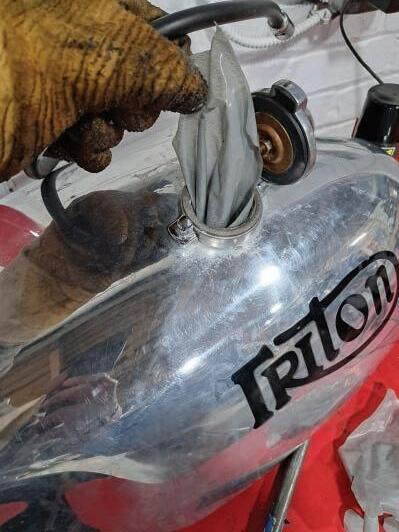 Around 1/3 bottle of acetone was added to the repaired fuel tank. After 24 hours, the silicone tank liner had peeled itself away from the tank’s insides. Ain’t science amazing?
The staggering amount of plastic that we managed to remove from the alloy gas tank. Get this inside an engine or carburetor and things could get very expensive.
Around 1/3 bottle of acetone was added to the repaired fuel tank. After 24 hours, the silicone tank liner had peeled itself away from the tank’s insides. Ain’t science amazing?
The staggering amount of plastic that we managed to remove from the alloy gas tank. Get this inside an engine or carburetor and things could get very expensive.
Cognito Moto’s High-Tech Machining Revolution
Story and Photos by Nick Coumos

Custom motorcycles have been around for a long time. The addition, subtraction or the substitution of parts in order to improve performance or change the looks of the motorcycle to reflect the personality of the rider is commonplace in this community of enthusiasts. Dealers who specialize

in aftermarket parts are ubiquitous and a Google search of “custom motorcycle parts” will yield millions of results. The problem is, they all sell pretty much the same stuff. What are you to do if you want something unique?

In a previous issue of Café Racer Magazine (#84), I wrote about our 850 Norton Commando that now sports the front end
of a 2008 Honda CBR1000RR. No special tools were required for this transformation and no adjustment of the parts was needed to make them fit. This was a simple bolt-on modification that not only improved the looks of this aged motorcycle, but also greatly improved the performance. It was made possible by the folks at Cognito Moto in Richmond Virginia. They created the beefy billet aluminum triple tree to mount the Honda front end to the Norton frame and even made the spoked wheel hub that helps the 49-year-old British classic maintain its original appearance.
I’ve always been interested in machine tools and own an 80-year-old South Bend lathe. And while I’m certainly not a professional machinist, I do enjoy removing metal from round objects. I met Devin Henriques, the owner of Cognito Moto, at the last Café Racer Ride-In Show and, finding that I shared his passion for modifying metal, he invited me to visit the Richmond workshop. Upon my arrival, Devin asked if I wanted to see a part being made. Of course, I said yes and the manufacturing began.

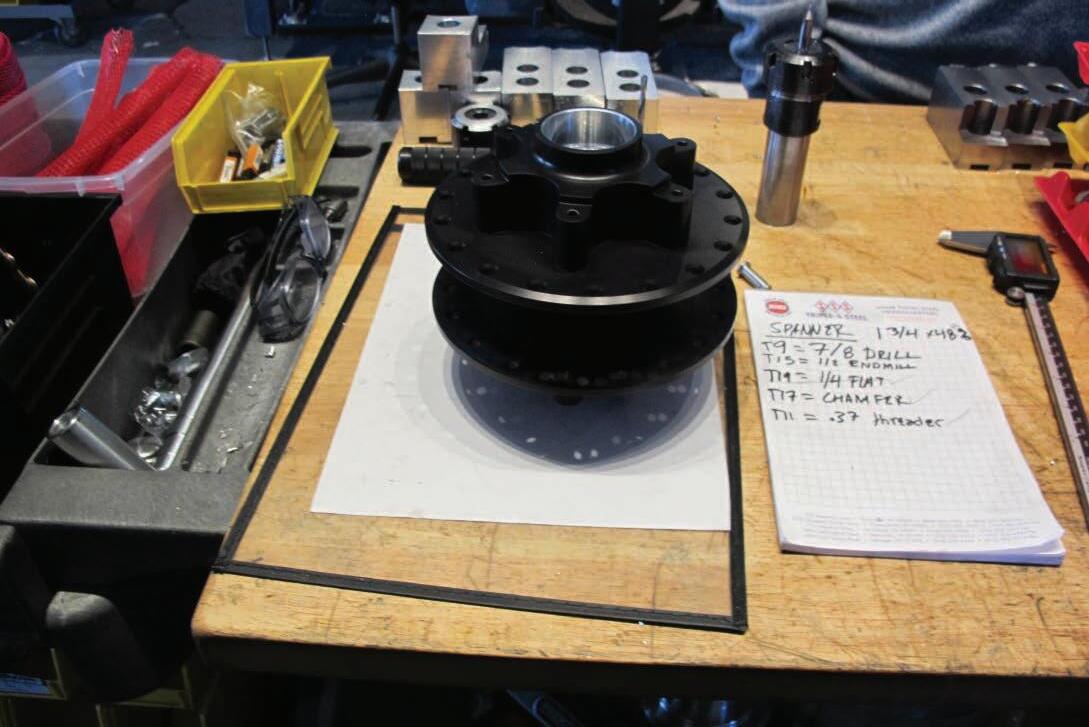
The heart of the Cognito Moto manufacturing process is high-tech mills and a lathe, American made, computer controlled, and
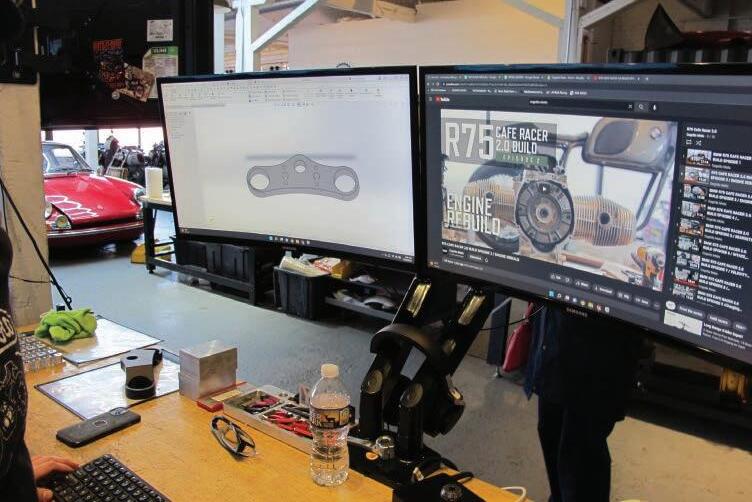
SHOPKEEPING
And a few minutes later, this wheel hubs emerges. This finished piece has been drilled to accept spokes and powdercoated in black.
Scott Misturini, Cognito Moto’s CNC programmer and machine operator, creating made-to-order custom motorcycle bits.
Each custom parts is precision designed in the company’s software database before being manufactured.
very expensive. The mill that I saw run that day made an upper triple clamp from start to finish with very little operator input. Scott Misturini, who is the CNC programmer and machine operator, directed the process via a bunch of very complicated-looking buttons on the outside of the machine. In very short order, the top of the part was finished. The piece was then turned over by hand and the machining process was resumed. In about five more minutes the completed part was done and on the bench.
Devin, a fourth-generation machinist, got his start creating high-speed manufacturing equipment that speeded-up the making of various health care products for Playtex, believe it or not. He spent 15 years as a mechanical engineer in the buttoned-up corporate world before shifting his focus to motorcycles, a passion of his from an early age.
One of the most popular special parts produced by Cognito’s four-man team is a custom wheel hub that allows the lacing of spoked rims to modern sportbike front ends. Today, Devin says Cognito has sold thousands of these sturdy billet aluminum hubs over the past few years, in the process helping make vintage cafe racers and bobbers safer and more roadworthy. “If you’ve ever ridden a classic bike and had to grab a handful of front brake and realized nothing’s happening, it’s a scary experience,” he told CRM. “Even though the early disc brakes on Hondas and BMWs were considered great back in the day, they’re pretty crap compared to modern brakes. With modern forks and brakes, these older bikes actually handle a lot better and the stopping power is increased a hundredfold.”
All of the Cognito team members are avid riders and deeply involved in custom culture, each riding and tinkering with their own retro bikes in their (limited) spare time.
In addition to their denselypacked parts inventory, which covers everything from wheel hubs to rearset controls, suspension components and mounting brackets for a variety of Japanese
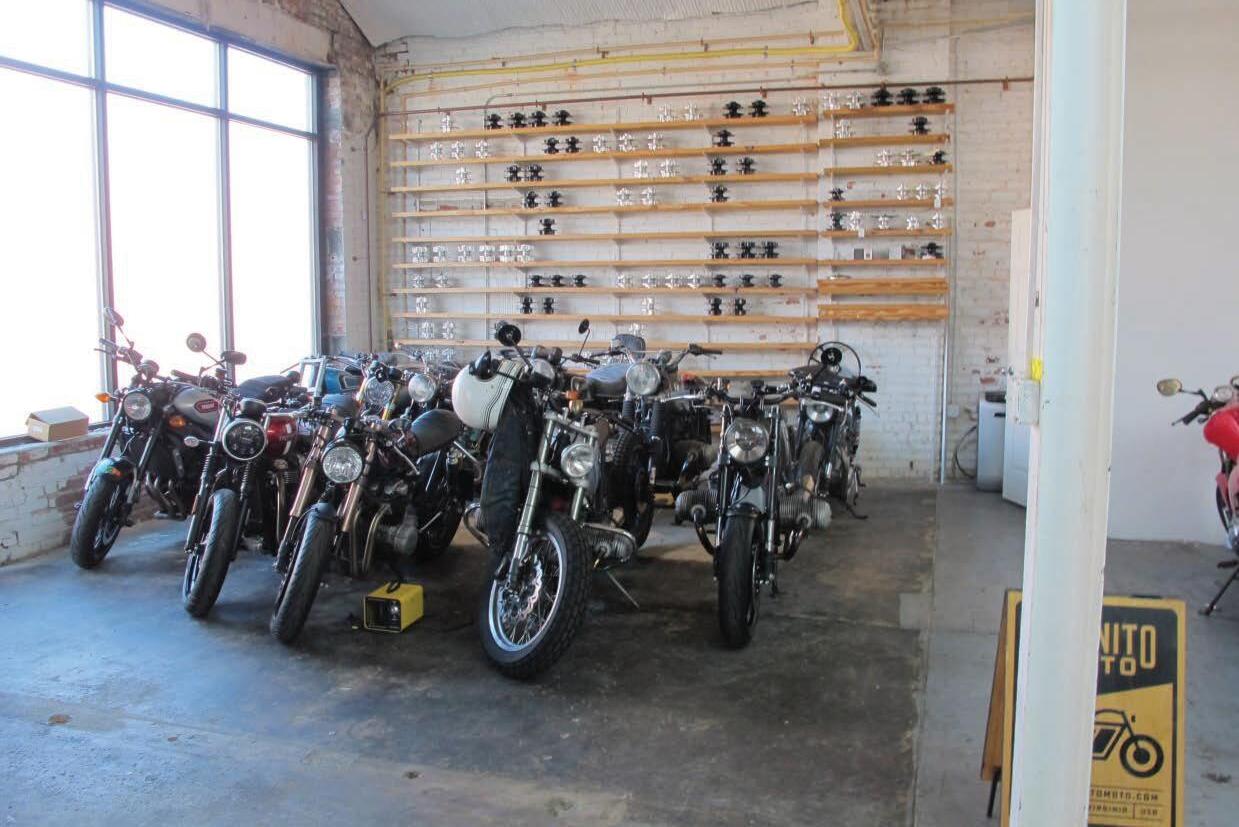
and European bikes, Cognito has recently started offering complete custom machining services. You simply upload your 3-D CAD files to their interactive web portal and they will quote you a price to manufacture that part in steel, stainless, aluminum, brass, or almost any other appropriate material.

This service eliminates the risk of purchasing parts of unknown quality from equally unknown suppliers (read eBay). Sure, you can print your own bits with an at-home 3-D printer and take your chances fabricating your own, but why bother when high-tech top-quality parts are so easy to source? CR
Resource: www.cognitomoto.com
 A perk of the job is fitting parts to these test mule bikes and riding them to make sure everything is safe and functional.
Deep within this murky swirl of cooling fluid and shredded metal lies a new, pristine triple clamp.
A perk of the job is fitting parts to these test mule bikes and riding them to make sure everything is safe and functional.
Deep within this murky swirl of cooling fluid and shredded metal lies a new, pristine triple clamp.
Moto Guzzi V9 Bobber Sport Fueled and Fettled

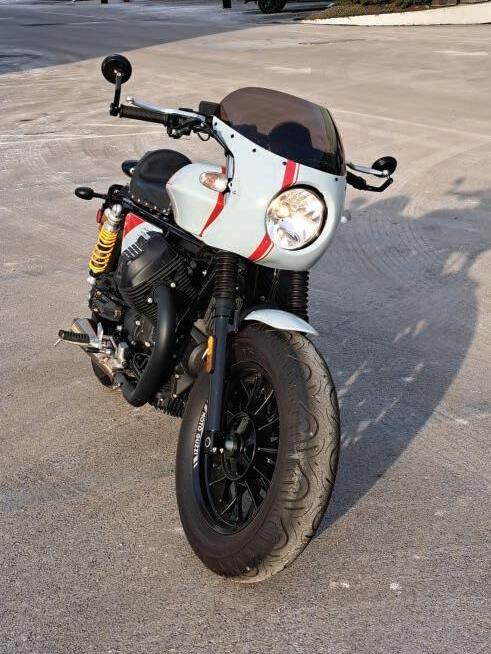 Story by Mike Seate
Photos by Nick Altland
Story by Mike Seate
Photos by Nick Altland
After tech Jeremy Haynes found a pirated version of the necessary software to re-set the Moto Guzzi’s throttle position sensor (last issue) it was just a matter of letting the shaft-drive Italian twin warm up enough for a test ride. Customizing the air-cooled machine had proven more fun than hassle thanks to Mr. Haynes abilities with software,
an ECU re-flash from So Cal’s GT Motocycles and the whole CRM crew pitching in to get things done.
This project bike revealed as much about myself as it had the motorcycle as the bike’s stock power output of a modest 60 horses promised to disappoint, but ended up doing anything but. Perhaps it’s a symptom of getting older or maybe we enjoy doing more with less, but the torque-laden, fourvalve transverse twin has proven a joy to
ride, reminding the team (or everyone but Jeremy) that you don’t need 170 ponies to have an exciting time on a streetbike.
The mods we performed were sensible instead of extreme, focusing on improving the V9’s airflow, combustion and fueling. Jeremy had lobbied to adapt a turbocharger from an Audi TT sports car, but Managing Editor Kim Love wisely stepped in and warned us away from that potentially disastrous course of action. This being the
84 www.caferacermag.com
CR Tech
was sorted at the factory with a set of adjustable Swedish Ohlins rear shocks in place and a set of telescopic 40mm Marzocchi forks up front. We lowered the forks 1 ¾” as the V9 Bobber’s fork tubes are a bit longer than the bike’s sibling, the cafe racer V7. This altered the steering head angle a few degrees which, on the first test ride, proved a nice adjustment.



“I can’t believe how much faster it turns in and how much stronger the midrange feels after getting rid of the fugly heavy-ass stock mufflers and re-flashing the ECU. You can feel there’s more torque down low and power everywhere,” young Mr. Haynes said after his first ride. The bike’s ample 46 footpounds of torque makes itself known at just 4,250 RPM which makes surfing through backroad bends in third gear a delight. Jeremy is eager to get the bike on a dyno to measure just how much hidden thrust the fueling work has unleashed, a great idea if ever there was one.
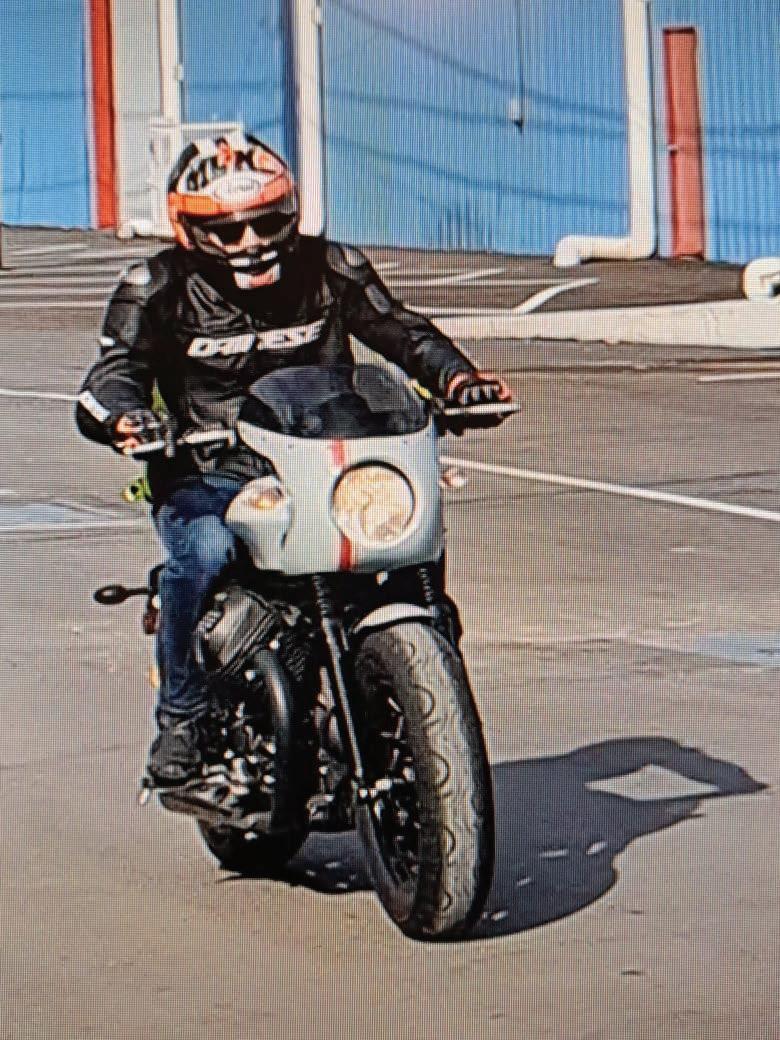
On the move, the addition of a wide-open airbox lid can also be heard if not immediately felt: there’s a satisfying rumble coming from beneath the seat (not cause by last night’s Guinness, I swear!) where the stock airbox received a more breathable DNA filter and the modified lid. The


 Bikini fairing didn’t fit our Harley Sportster 1250S but it found a home on the Moto Guzzi. Bar-end mirrors from Speed Moto Co were a nice addition.
The slick red on muted gray paint was laid down by Muzzy and was borrowed from a KIA SUV.
Jeremy promised not to wheelie the V9 and kept his promise. With all the new power, that must have been a challenge.
Bikini fairing didn’t fit our Harley Sportster 1250S but it found a home on the Moto Guzzi. Bar-end mirrors from Speed Moto Co were a nice addition.
The slick red on muted gray paint was laid down by Muzzy and was borrowed from a KIA SUV.
Jeremy promised not to wheelie the V9 and kept his promise. With all the new power, that must have been a challenge.
CR Tech

other source of improved soundtrack is the stainless steel Cone Engineering mufflers that dropped a dozen pounds and added even more surge to the Guzzi.
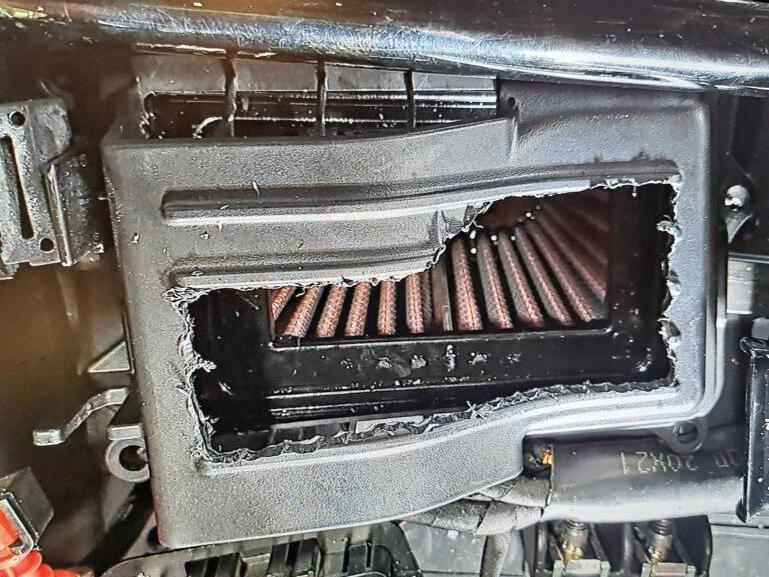
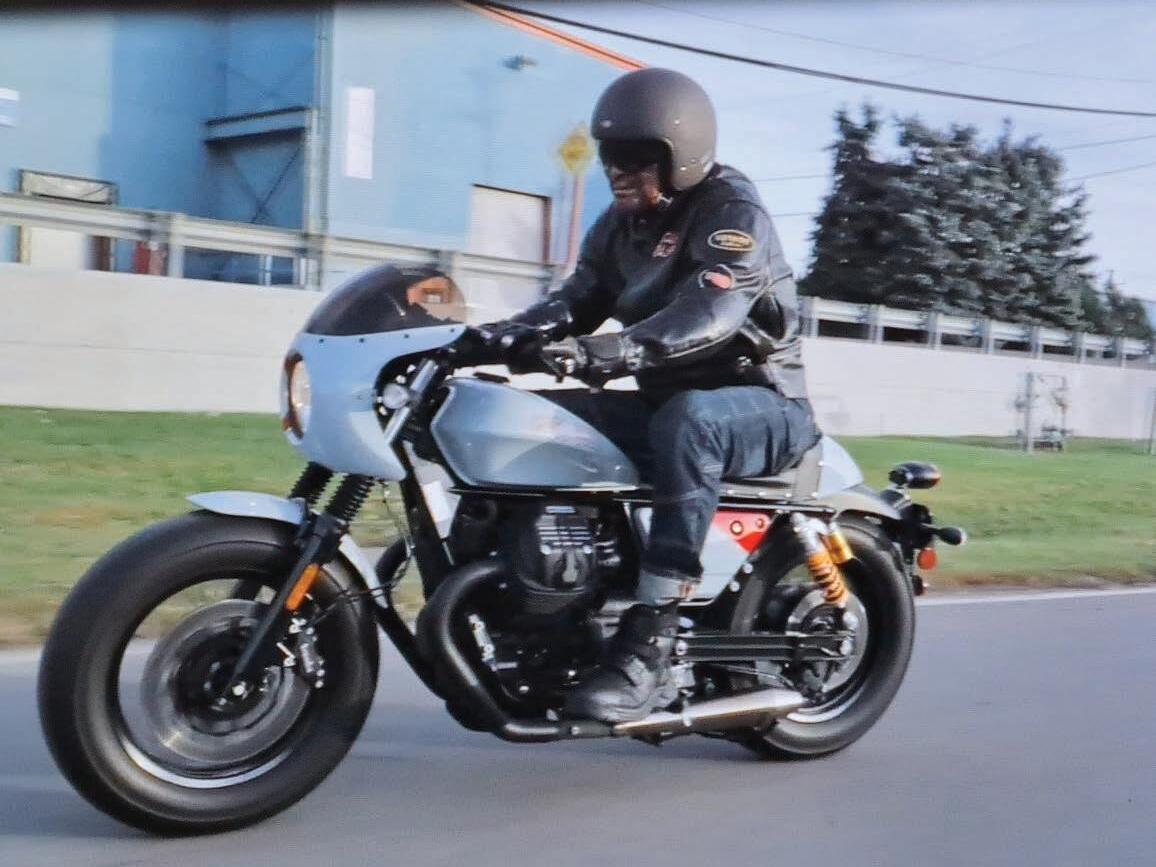
Unfortunately, the early spring weather still wasn’t cooperating well enough for a lengthy series of test rides and we’ve still to mount the new Avon Cobra Chrome radials to further improve the bike’s cornering grip and steering. Jeremy swears he knows some people at the local racetrack who might allow us to test the V9 on its undulating (and traffic-free) corners, so we’ll be working towards that goal next issue. In the meantime, the Guzzi still needs an oil and filter change and its initial service. These tasks should prove a pleasure considering all the fun this bike promises to deliver in the months to come. CR
Resource: www.gtmotocycles.com
86 www.caferacermag.com
The narrow cafe racer seat is more accommodating than imagined. Is that why this man is smiling?
The rough edges need sanded, but the engine is now receiving about 80% more airflow thanks to a new filter and modded lid.
Shoring Up the Bars
Story by Adam Bowser
Photos by Nick Altland
We were fortunate enough to have Adam Bowser, the highly motivated owner of Moto PGH, assisting us in the CRM garage recently. In this issue, the prolific builder of over 500 custom cafe racers shares his practical insights into keeping classic Japanese motorcycle roadworthy - editor
The handlebars on the 1972 CB450 feel wobbly when you grab onto them and that’s a common problem on older Hondas. The problem is with the two rubber bush-
a few decades, they shrink from just drying up from being so old and they can make the bar risers feel wobbly.
There’s a couple of ways to fix this problem with some guys opting to just replace the riser hardware with bigger-diameter riser inserts that eliminate the need for rubber bushings at all. This works, but without the rubber pieces you get a lot more vibration through the bars, especially on one of these bigger 450cc or 500cc twins. You don’t notice as much running solid-
mounted handlebars on a CB750 or one of the smaller displacement fours.


You can buy a new pair of rubber bushings, but they’re hard to find and can cost a lot if you do find NOS bushings.

A cheap shortcut I do on some of my classic Hondas is to just wrap the old bushings up in electrical tape. This makes them bigger and helps the bushings to fill up the space inside the holes in the top triple clamps. It seems like it wouldn’t work, but I’ve done this on some of my own bikes and ridden hundreds and hundreds of miles with no problems.
Just unbolt the risers from under the top triple clamp and the bars will lift out. The bushings are just sitting in the holes so be careful or they’ll drop down and roll across the floor. Use typical black electrical tape and wrap them a couple of times around, stopping to check and make sure you haven’t wrapped them too thick so they can’t fit back into the holes.
Shove the wrapped bushings back into the triple clamp and slowly slide the threaded riser bolts back through the bushings, being careful not to knock them back through. When you tighten them back up, do a few turns on each instead of completely tightening one all the way and then the other.
Once the handlebars are back in place, when you shove on them, you’ll notice they aren’t moving around a lot anymore. There will still be a little bit of play in the bars, but that’s OK. If there’s still a lot of play you’ll want to replace the bushings because they may be cracked or worn out. CR
Cafe Racer • APRIL/MAY 2023 87
CR Tech 1972 Honda CB450
Adam loosens the handlebars and drops the rubber bushings that have shrunk over time.
Wrapping the bushings in electrical tape helps shore them up, quelling that weird, loose feeling in the bars.
Have a pressing technical issue with your ride? Contact Matt directly via motovintagematt@gmail.com
Their circumference larger thanks to the miracle that is electrical tape, the bars will vibrate less and feel more solid.
Kick the Tires and Light the Fires
Spring Motorcycle Ride Preparations
By Tech Editor Matt Wiley
Spring has sprung (hopefully) for riders in seasonal areas, and waking your trusty steed from hibernation for the riding season comes with a yearly To-Do List. As with so many things in life, preparation and planning can make or break the outcome. Here are some tips and a checklist to get your bike going again and avoid first ride breakdowns and other issues. Let’s Ride Clyde!
If your motorcycle was blessed, it spent the winter months at The Four Seasons: a climate controlled, weatherproof, varmint-safe environment. This really helps as storage sheds or units, barns or, worse yet, outdoor storage invites a lot of extra issues that can potentially drive you to drink. Either way, pop a cold one or fill the thermos with coffee and here we go.
Take the cover off the bike (you wouldn’t sleep naked with no blanket for several cold, damp months, would you?) and look it over: Are there any fluid spots underneath? If so, then make note of where for further inspection of leakage source. Check the engine,

suspension, brakes and look for any leaked battery acid (yikes! please say it ain’t so!)
Are there indications of mouse droppings, spiderwebs or paw prints? Once varmints get out of the weather they look for a home and, unfortunately, motorcycles offer lots of opportunity for winter residence. Airboxes are a favorite of mice as they chew up the air filter to make a nest. Mouse urine is terrible, causing acidic corrosion. Insects like small areas to build mud nests and webs, with the air pipes that run up the sides of a Yamaha Virago frame are notoriously inviting to spiders and wasp/hornet nests.
Tires: If they’re flat, plan to pull both wheels. If the pressure is low, that’s to be expected after a bike has sat idle for a while. If the bike needs to be moved to another location, air up the tires first to ease movement and to inspect for cracking at both sidewalls and tread area.
Note – five years is the maximum safe life for motorcycle tires so check the manufacturing date on the tire sidewall. Tire company websites help explain where to find and how to read these. Old tires, even with good tread, can cause a crash due to old, hardened rubber. Last year on a group ride a fellow went down hard in a moderate corner at moderate speed after the front end tucked. It turns out his front tire was hard as a rock and around eight years old.
Battery: If you haven’t already done so, put the battery on a trickle charger to warm it up and make sure it’s at full charge prior to startup. Note: even well-stored batteries can lose charge capacity or die without regular use. When the battery is back in the motorcycle, run a lighting check and don’t overlook the brake light operation and horn function as car drivers have forgotten we exist over the winter months.
88 www.caferacermag.com
WORKSHOP FILES With Technical Editor
MATT Wiley
Fluids: Check the oil level and sniff to make sure it’s not contaminated by gasoline. If your ride is liquid cooled, observe the coolant in the recovery bottle for level and cleanliness. The engine coolant should be changed semi-annually as it degrades and becomes corrosive over time. Is the brake fluid visible in the master cylinder sight glass? You may need to remove the filler caps on some models to properly inspect what’s inside.
Brake fluid should be clear and the brake levers and pedal firm. As with engine coolant, brake fluid should be refreshed semi-annually. Open the fuel filler cap and inhale. You’re sniffing for an odor of stale gas or even fuel that’s turned to varnish. If there’s any fumy smells, drain, flush and refill the tank with fresh gas. Today’s gasoline has a short shelf life prior to going stale and losing combustibility.
Carbs: If your motorcycle is carbureted, it’s best to drain the old fuel from them prior to cranking the engine as stale fuel does not want to burn and often fouls spark plugs. Make a shield or funnel by cutting up an old plastic container to make sure old nasty fuel does not stain your engine’s finish (a shield also helps drained gas to reach a catch pan rather than the floor). Models with vacuum-operated fuel petcocks must use the PRIME position on the valve. It’s better this way as opposed to using up your battery cranking power while refilling the carbs. Don’t forget to re-set the fuel knob to the ON position so as not to run out of gas somewhere inconvenient
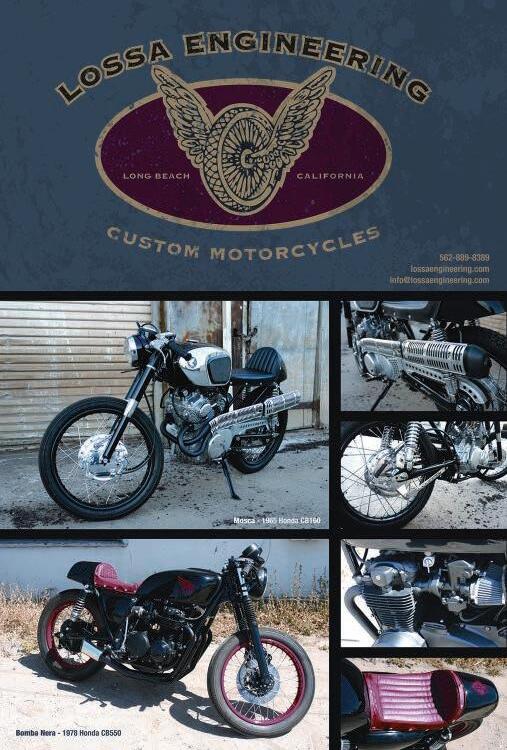
OK, it’s showtime! After running our checklist, crank the bike up. Hopefully, it starts up easily with no leaks, backfires or belching of some vital fluid. Once it starts up go easy on it, don’t wring the motor’s neck. Let the engine warm up a bit, blip the throttle, but go easy until (hopefully) after the enricher/choke is released at which point the engine will idle and throttle up smoothly. Now it’s time for shakedown ride. Again, go easy – it’s been a while for both you and the bike so take your time to get back into your riding groove.
Should the throttle response be off or if the engine is running a bit rough, add some fuel system cleaner and fresh high octane gas to clear the carb passages or fuel injection nozzles. Pay attention to your bike’s recommended amount of fuel system cleaner because the typical bottle is enough for a 12- to 15-gallon car gas tank. Your motorcycle only holds 3 to 5 gallons, so several treatments can be had from one bottle.
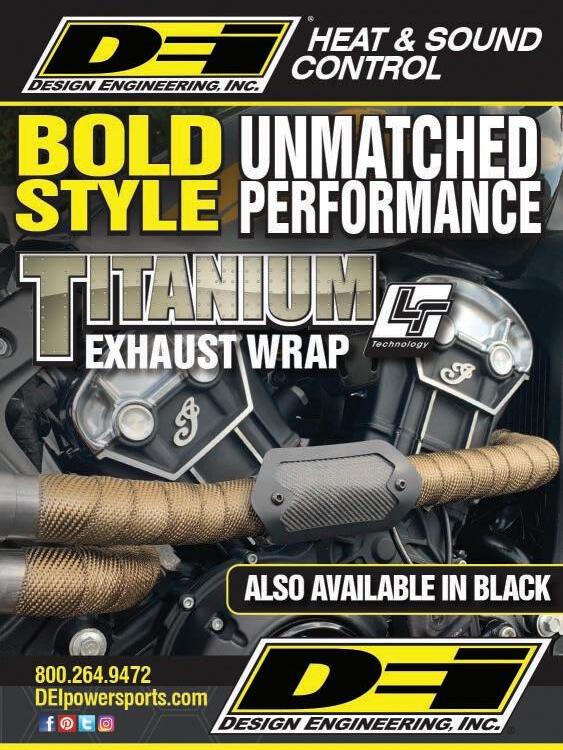
After the shakedown ride, go over the motorcycle again to make sure no leaks have popped up and to confirm that all your bike’s lights are functioning. Lube the chain while it’s still warm from the shakedown ride for best lubricant penetration and allow 20-30 minutes for the chain lube to set-up prior to riding again.
Last check is you, the rider. Do your jacket, boots and gloves all still fit comfortably? How old is that helmet? Does it still fit snugly? Can you see through the visor? Bet you need a new one. How about your riding skills? We all get rusty when not riding regularly. An advanced rider class or track day could be a really nice kickstart to your riding season. It’s only your life at stake after all. Situational awareness is very important to street riding as this is what allows us to see pending situations to avoid or at least prepare for. Now, Go Ride Clyde! CR
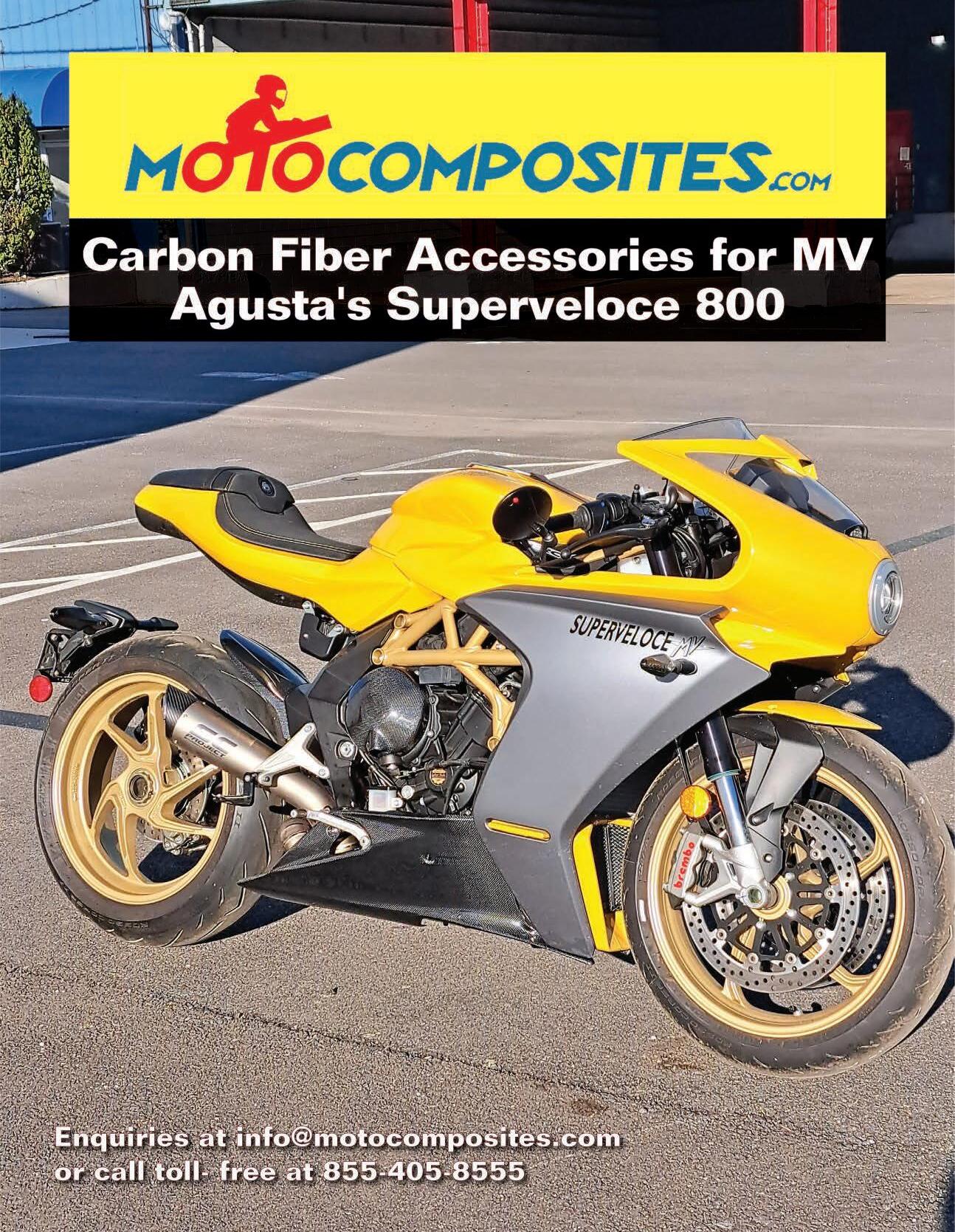
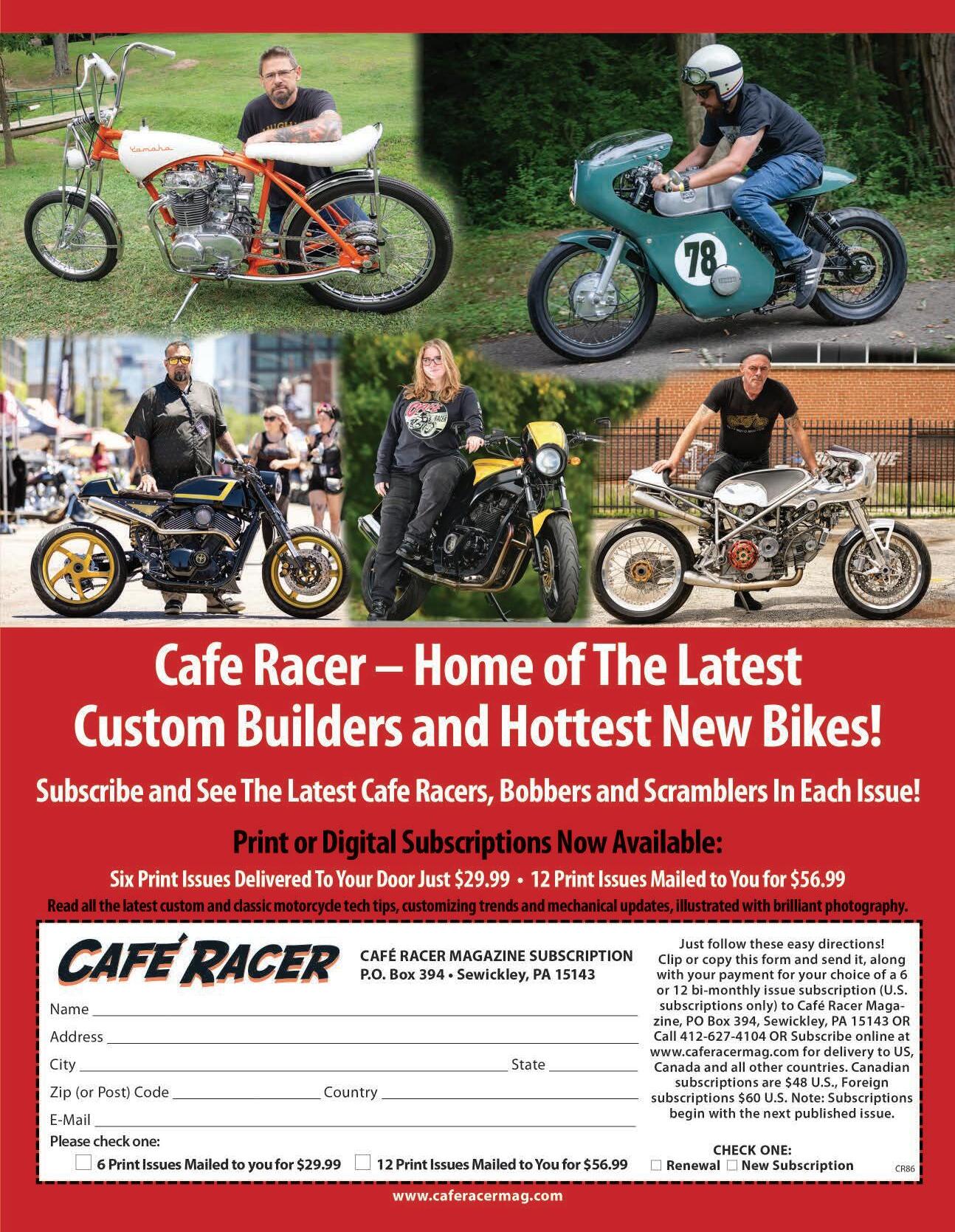
































 The Voge 525 utilizes the same running gear and engine as Benelli’s Leoncino that we reviewed last issue. Copyright laws are few and far between with the Chinese manufacturers.
The Voge 525 utilizes the same running gear and engine as Benelli’s Leoncino that we reviewed last issue. Copyright laws are few and far between with the Chinese manufacturers.













 Contributed by Lee Patterson
Contributed by Lee Patterson









































































 Photos by Manny Pandya and Never Ending Cycles
Photos by Manny Pandya and Never Ending Cycles









 Story by Mike Seate Photos courtesy the Hill Family
Story by Mike Seate Photos courtesy the Hill Family

























 Compiled by The Staff
Compiled by The Staff






















 Triumph’s late 1960s twin leading shoe front brake is more period-perfect than the disc set-up that Jeff replaced.
Derisively called the Power Egg due its rounded crankcases, the unit-construction BSA twins are quicker and more reliable than early versions. Note odd ignition coil location.
Triumph’s late 1960s twin leading shoe front brake is more period-perfect than the disc set-up that Jeff replaced.
Derisively called the Power Egg due its rounded crankcases, the unit-construction BSA twins are quicker and more reliable than early versions. Note odd ignition coil location.













 Unafraid to face the unusual, Dan Torres mounted a Ducati 748 single-sided swingarm to his Harley Street 750 for amazing results. Homemade headers sport Cone Engineering mufflers.
Unafraid to face the unusual, Dan Torres mounted a Ducati 748 single-sided swingarm to his Harley Street 750 for amazing results. Homemade headers sport Cone Engineering mufflers.

















 Story and Photos by Paul D. Stanstead
Story and Photos by Paul D. Stanstead

 Around 1/3 bottle of acetone was added to the repaired fuel tank. After 24 hours, the silicone tank liner had peeled itself away from the tank’s insides. Ain’t science amazing?
The staggering amount of plastic that we managed to remove from the alloy gas tank. Get this inside an engine or carburetor and things could get very expensive.
Around 1/3 bottle of acetone was added to the repaired fuel tank. After 24 hours, the silicone tank liner had peeled itself away from the tank’s insides. Ain’t science amazing?
The staggering amount of plastic that we managed to remove from the alloy gas tank. Get this inside an engine or carburetor and things could get very expensive.








 A perk of the job is fitting parts to these test mule bikes and riding them to make sure everything is safe and functional.
Deep within this murky swirl of cooling fluid and shredded metal lies a new, pristine triple clamp.
A perk of the job is fitting parts to these test mule bikes and riding them to make sure everything is safe and functional.
Deep within this murky swirl of cooling fluid and shredded metal lies a new, pristine triple clamp.

 Story by Mike Seate
Photos by Nick Altland
Story by Mike Seate
Photos by Nick Altland





 Bikini fairing didn’t fit our Harley Sportster 1250S but it found a home on the Moto Guzzi. Bar-end mirrors from Speed Moto Co were a nice addition.
The slick red on muted gray paint was laid down by Muzzy and was borrowed from a KIA SUV.
Jeremy promised not to wheelie the V9 and kept his promise. With all the new power, that must have been a challenge.
Bikini fairing didn’t fit our Harley Sportster 1250S but it found a home on the Moto Guzzi. Bar-end mirrors from Speed Moto Co were a nice addition.
The slick red on muted gray paint was laid down by Muzzy and was borrowed from a KIA SUV.
Jeremy promised not to wheelie the V9 and kept his promise. With all the new power, that must have been a challenge.












